Paul van Yperen's Blog, page 72
October 5, 2023
Carroll Baker
American film, stage and television actress Carroll Baker (1931) enjoyed popularity as both a serious dramatic actress and as a sex symbol. Cast in a wide range of roles during her heyday in the 1960s, Baker was especially memorable playing brash, flamboyant women, due to her beautiful features, striking blonde hair, and distinctive Southern drawl. In the late 1960s, she moved to Italy, where she starred in numerous Giallo thrillers and Horror films.
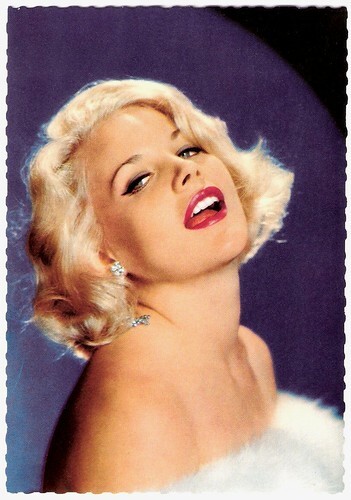
German postcard by ISV, no. T-13.
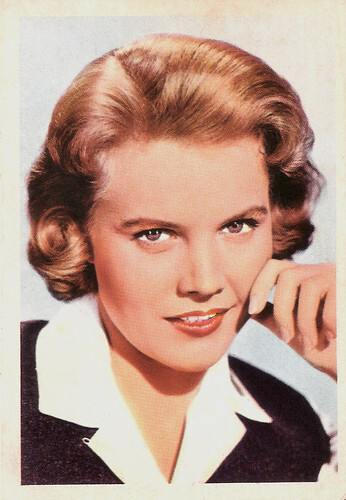
West German Collectors card, no. 55. Photo: Paramount. Carroll Baker in But not for me (Walter Lang, 1959).
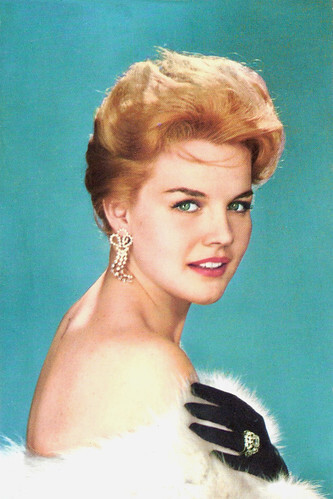
Israelian postcard by Editions de Luxe, no. 117.
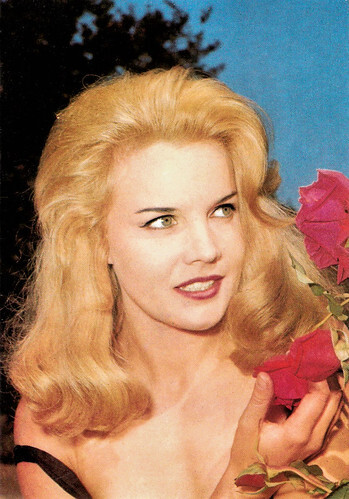
Spanish postcard by Postal Oscarcolor, no. 101.
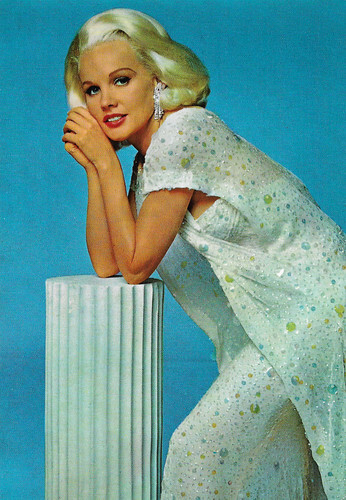
Italian postcard by Rotalfoto, Milano, no. 231. Carroll Baker in Harlow (Joseph E. Levine, 1965).
Baby Doll
Carroll Baker was born Karolina Piekarski in Johnstown, Pennsylvania, in 1931. Her parents were Virginia (née Duffy) and Polish-born William Watson Baker (Piekarski), who was a travelling salesman. After spending a year in college, she began working as the assistant of magician the Great Volta and joined a dance company.
Baker moved to New York City. In 1953, she married furrier Louie Ritter, but the marriage ended the same year. She began her film career with a small part in Easy to Love (Charles Walters, 1953). After appearing in television commercials, she took a role in the Broadway production of Robert Anderson's play 'All Summer Long' (1955).
In 1954, she studied acting under Lee Strasberg, eventually becoming part of the famed Actors Studio, where she was an acquaintance of Marilyn Monroe and became a close friend of James Dean . At the Actors Studio; she also met director Jack Garfein, whom she married in 1955.
Director Elia Kazan cast her as the title character in his controversial Baby Doll (1956), based on a script by Tennessee Williams. Her role as the thumb-sucking teenage bride to a failed middle-aged cotton gin owner (Karl Malden) brought Baker instant fame as well as a certain level of notoriety. It earned her an Oscar nomination and a Golden Globe.
She also appeared in Giant (George Stevens, 1956) alongside Elizabeth Taylor , Rock Hudson , and James Dean .
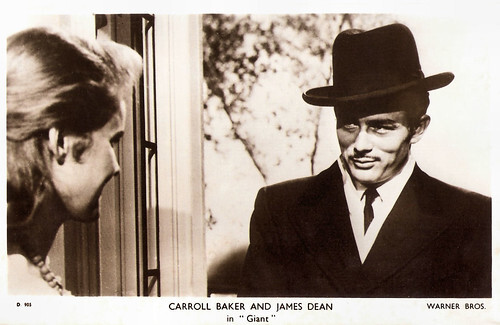
British postcard in the Picturegoer Series, no. D 905. Photo: Warner Bros. Carroll Baker and James Dean in Giant (William Wyler, 1956).
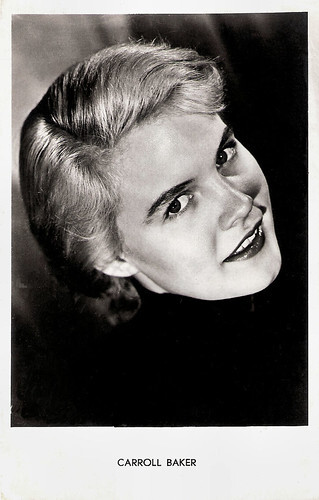
Vintage postcard.
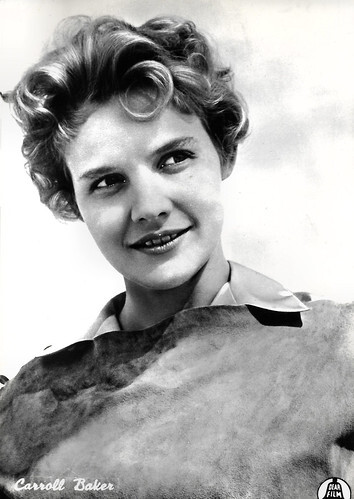
Italian postcard by Bromofoto, Milano, no. 1368. Photo: Dear Film. Carroll Baker in The Big Country (William Wyler, 1958).
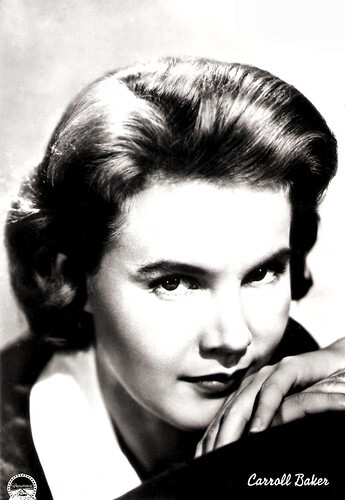
Italian postcard by Bromoforo, Milano, no. 1583. Photo: Paramount. Publicity still for But Not for Me (Walter Lang, 1959).
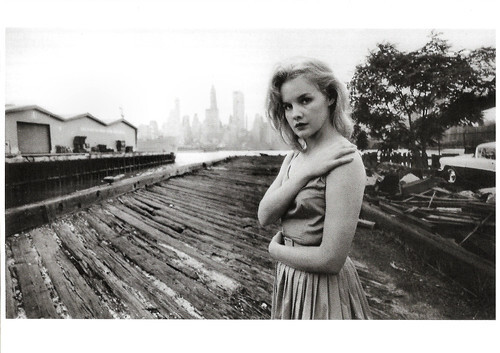
Swiss-British postcard by News Productions, Baulmes / Stroud, no. 56737, 1996. Photo: Larry Shaw. Caption: Carroll Baker, New York City, 1960.
Something wild
Carroll Baker would go on to work steadily in films throughout the late fifties and early sixties. She appeared in a variety of genres: romances, such as The Miracle (Irving Rapper, 1959), co-starring a young Roger Moore , and But Not for Me (Walter Lang, 1959) with Clark Gable , as well as Westerns, including The Big Country (William Wyler, 1958) and a lead role in the epic How the West Was Won (Henry Hathaway, John Ford, George Marshall, 1962).
She also acted in steamy melodramas, including the controversial independent film Something Wild (1961), directed by her then-husband Jack Garfein, in which she plays a rape victim; and Station Six-Sahara (Seth Holt, 1962).
Baker was also chosen by MGM for the lead in Cat on a Hot Tin Roof, but her contract with Warner Brothers prevented her from accepting the role, which ultimately went to Elizabeth Taylor .
Baker's portrayal of a Jean Harlow -type movie star in The Carpetbaggers (Edward Dmytryk, 1964) brought her a second wave of notoriety. The film was the top money-maker of that year, with domestic box-office receipts of $13,000,000 and marked the beginning of a tumultuous relationship with the film's producer, Joseph E. Levine.
Based on her Carpetbaggers performance, Levine began to develop Baker as a sex symbol, casting her in the title roles of Sylvia (Gordon Douglas, 1965) and Harlow (Joseph E. Levine, 1965). Despite much pre-publicity, the latter film was unsuccessful, and relations between Baker and Levine soured.
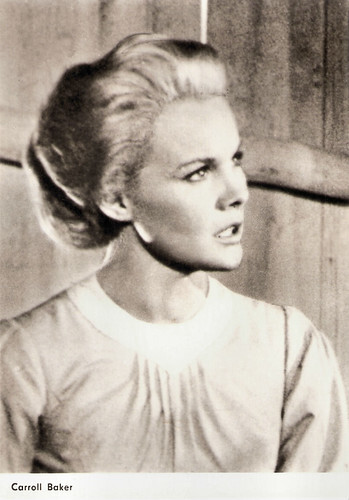
East-German postcard by VEB Progress Film-Vertrieb, Berlin, no. 3143, 1968. Retail price: 0,20 M. Photo: publicity still for Cheyenne Autumn (John Ford, 1964).
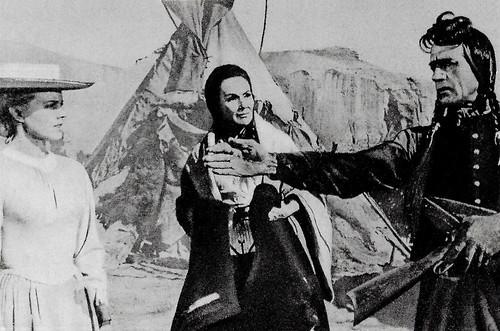
East-German collectors card in the 'Neu im Kino' series by VEB Progress Film-Vertrieb, Berlin, no. 500/6/68. Carroll Baker, Dolores del Río and Ricardo Montalban in Cheyenne Autumn (John Ford, 1964).
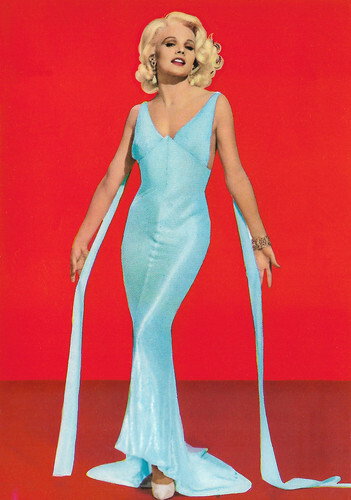
Spanish postcard by CyA, no. 135. Photo: Paramount. Carroll Baker in Harlow (Joseph E. Levine, 1965).
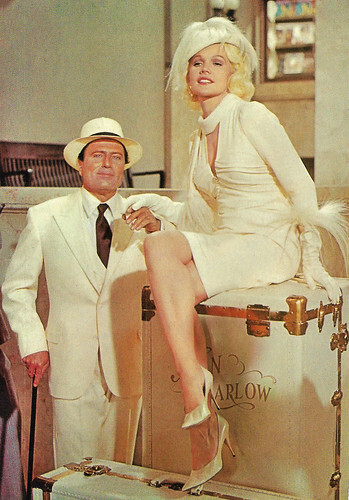
Spanish postcard by Postal Oscarcolor, no. 429. Carroll Baker and Raf Vallone in Harlow (Joseph E. Levine, 1965).
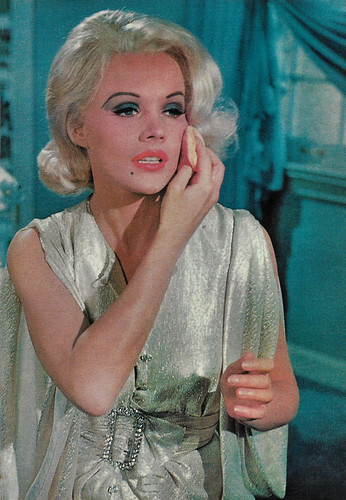
Spanish postcard by Postal Oscarcolor, no. 431. Carroll Baker in Harlow (Joseph E. Levine, 1965).
Horror and Giallos
In the late 1960s, Carroll Baker moved to Italy after a protracted legal battle with Paramount Pictures and a divorce from her second husband, Jack Garfein. In the next decade, she starred in a multitude of Italian films.
These included several horror films and Giallo thrillers such as L’Harem/Her Harem (Marco Ferreri, 1967) with Renato Salvatori , Il dolce corpo di Deborah/The Sweet Body of Deborah (Romolo Guerrieri, 1968) opposite Jean Sorel , and Il diavolo a sette face/The Devil Has Seven Faces (Osvaldo Civirani, 1971).
She became a favourite of cult director Umberto Lenzi who directed her in the Horror films Così dolce... così perversa/So Sweet... So Perverse (1969) with Jean-Louis Trintignant , Orgasmo/Paranoia (1969) with Lou Castel, Paranoia/A Quiet Place to Kill (1970), and Il coltello di ghiaccio/Knife of Ice (1972).
She followed her roles in Lenzi's films with a leading role in Baba Yaga/Black Magic (Corrado Farina, 1973) as the titular witch, alongside George Eastman.
In those years, film locations would take her all around the world, including Spain, Germany, the United Kingdom, and Mexico.
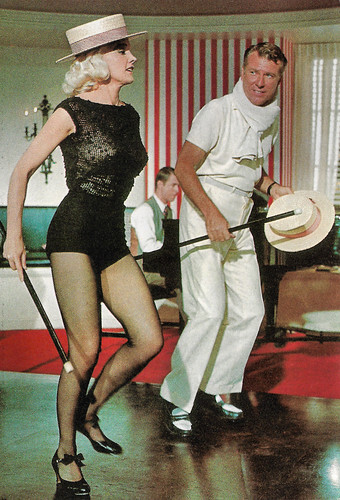
Spanish postcard by Postal Oscarcolor, no. 432. Carroll Baker in Harlow (Joseph E. Levine, 1965).
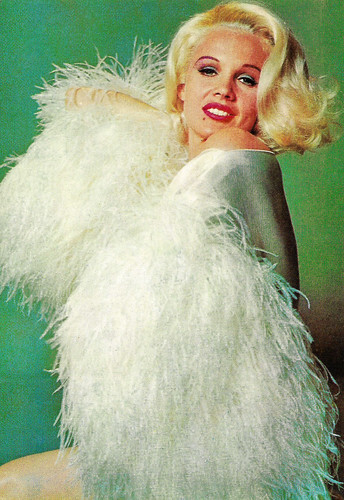
Spanish postcard by Postal Oscarcolor, no. 433. Carroll Baker in Harlow (Joseph E. Levine, 1965).
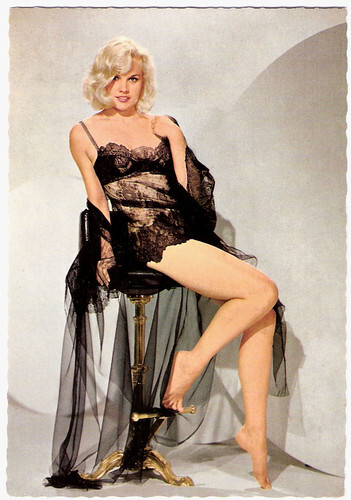
Dutch postcard by P. Moorlag, Heerlen, Sort. 15/6.
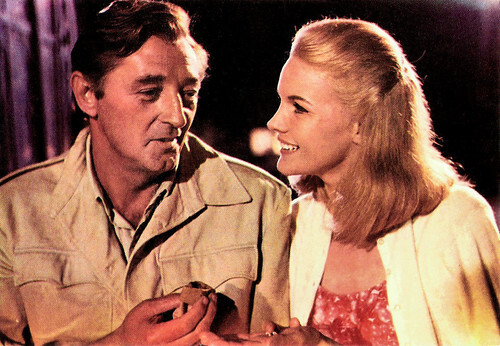
Italian postcard. Photo: DEAR Film. Publicity still for Mister Moses (Ronald Neame, 1965).
Warhol
Carroll Baker returned to American cinema with a leading part as a beauty salon owner who provides hit men with jobs in Andy Warhol's Bad (Jed Johnson, 1977). She played a washed-up actress living among expatriates in a Spanish village in Las flores del vicio/The Sky Is Falling (Silvio Narizzano, 1979) with Dennis Hopper.
She appeared in British theatre productions of 'Bell, Book, and Candle', W. Somerset Maugham's 'Rain', 'Lucy Crown', and 'Motive'. There she met her third husband, stage actor Donald Burton.
Baker starred in the Walt Disney-produced Horror film, The Watcher in the Woods (John Hough, 1980), alongside Bette Davis and played the mother of Dorothy Stratten in Star 80 (Bob Fosse, 1983). She also played Jack Nicholson 's wife in Ironweed (Héctor Babenco, 1987).
She later had supporting roles in Kindergarten Cop (Ivan Reitman, 1990) and the acclaimed thriller The Game (David Fincher, 1997), before retiring in 2002.
During a career spanning 50 years, Carroll Baker appeared in over 80 roles in film, television, and theatre. In 1983, she published a well-received autobiography entitled 'Baby Doll: An Autobiography', and later wrote two other books, 'To Africa with Love', and a novel entitled 'A Roman Tale'. Baker has two children with Jack Garfein, Blanche Baker (1956) and Herschel Garfein (1958).
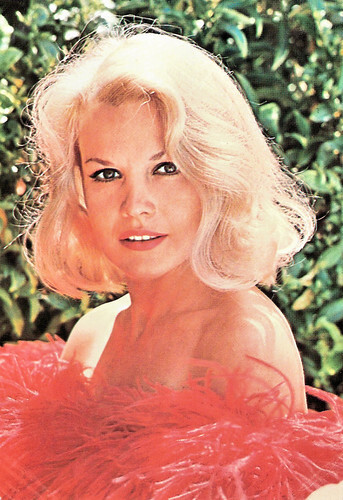
Romanian postcard by Casa Filmului Acin.
Trailer for L’Harem/Her Harem (1967). Source: Brian Horrorwitz (YouTube).
Trailer for Orgasmo/Paranoia (1969). Source: Javierdigranti (YouTube).
Sources: AllMovie, Glamour Girls of the Silver Screen, Wikipedia and .

German postcard by ISV, no. T-13.

West German Collectors card, no. 55. Photo: Paramount. Carroll Baker in But not for me (Walter Lang, 1959).

Israelian postcard by Editions de Luxe, no. 117.

Spanish postcard by Postal Oscarcolor, no. 101.

Italian postcard by Rotalfoto, Milano, no. 231. Carroll Baker in Harlow (Joseph E. Levine, 1965).
Baby Doll
Carroll Baker was born Karolina Piekarski in Johnstown, Pennsylvania, in 1931. Her parents were Virginia (née Duffy) and Polish-born William Watson Baker (Piekarski), who was a travelling salesman. After spending a year in college, she began working as the assistant of magician the Great Volta and joined a dance company.
Baker moved to New York City. In 1953, she married furrier Louie Ritter, but the marriage ended the same year. She began her film career with a small part in Easy to Love (Charles Walters, 1953). After appearing in television commercials, she took a role in the Broadway production of Robert Anderson's play 'All Summer Long' (1955).
In 1954, she studied acting under Lee Strasberg, eventually becoming part of the famed Actors Studio, where she was an acquaintance of Marilyn Monroe and became a close friend of James Dean . At the Actors Studio; she also met director Jack Garfein, whom she married in 1955.
Director Elia Kazan cast her as the title character in his controversial Baby Doll (1956), based on a script by Tennessee Williams. Her role as the thumb-sucking teenage bride to a failed middle-aged cotton gin owner (Karl Malden) brought Baker instant fame as well as a certain level of notoriety. It earned her an Oscar nomination and a Golden Globe.
She also appeared in Giant (George Stevens, 1956) alongside Elizabeth Taylor , Rock Hudson , and James Dean .

British postcard in the Picturegoer Series, no. D 905. Photo: Warner Bros. Carroll Baker and James Dean in Giant (William Wyler, 1956).

Vintage postcard.

Italian postcard by Bromofoto, Milano, no. 1368. Photo: Dear Film. Carroll Baker in The Big Country (William Wyler, 1958).

Italian postcard by Bromoforo, Milano, no. 1583. Photo: Paramount. Publicity still for But Not for Me (Walter Lang, 1959).

Swiss-British postcard by News Productions, Baulmes / Stroud, no. 56737, 1996. Photo: Larry Shaw. Caption: Carroll Baker, New York City, 1960.
Something wild
Carroll Baker would go on to work steadily in films throughout the late fifties and early sixties. She appeared in a variety of genres: romances, such as The Miracle (Irving Rapper, 1959), co-starring a young Roger Moore , and But Not for Me (Walter Lang, 1959) with Clark Gable , as well as Westerns, including The Big Country (William Wyler, 1958) and a lead role in the epic How the West Was Won (Henry Hathaway, John Ford, George Marshall, 1962).
She also acted in steamy melodramas, including the controversial independent film Something Wild (1961), directed by her then-husband Jack Garfein, in which she plays a rape victim; and Station Six-Sahara (Seth Holt, 1962).
Baker was also chosen by MGM for the lead in Cat on a Hot Tin Roof, but her contract with Warner Brothers prevented her from accepting the role, which ultimately went to Elizabeth Taylor .
Baker's portrayal of a Jean Harlow -type movie star in The Carpetbaggers (Edward Dmytryk, 1964) brought her a second wave of notoriety. The film was the top money-maker of that year, with domestic box-office receipts of $13,000,000 and marked the beginning of a tumultuous relationship with the film's producer, Joseph E. Levine.
Based on her Carpetbaggers performance, Levine began to develop Baker as a sex symbol, casting her in the title roles of Sylvia (Gordon Douglas, 1965) and Harlow (Joseph E. Levine, 1965). Despite much pre-publicity, the latter film was unsuccessful, and relations between Baker and Levine soured.

East-German postcard by VEB Progress Film-Vertrieb, Berlin, no. 3143, 1968. Retail price: 0,20 M. Photo: publicity still for Cheyenne Autumn (John Ford, 1964).

East-German collectors card in the 'Neu im Kino' series by VEB Progress Film-Vertrieb, Berlin, no. 500/6/68. Carroll Baker, Dolores del Río and Ricardo Montalban in Cheyenne Autumn (John Ford, 1964).

Spanish postcard by CyA, no. 135. Photo: Paramount. Carroll Baker in Harlow (Joseph E. Levine, 1965).

Spanish postcard by Postal Oscarcolor, no. 429. Carroll Baker and Raf Vallone in Harlow (Joseph E. Levine, 1965).

Spanish postcard by Postal Oscarcolor, no. 431. Carroll Baker in Harlow (Joseph E. Levine, 1965).
Horror and Giallos
In the late 1960s, Carroll Baker moved to Italy after a protracted legal battle with Paramount Pictures and a divorce from her second husband, Jack Garfein. In the next decade, she starred in a multitude of Italian films.
These included several horror films and Giallo thrillers such as L’Harem/Her Harem (Marco Ferreri, 1967) with Renato Salvatori , Il dolce corpo di Deborah/The Sweet Body of Deborah (Romolo Guerrieri, 1968) opposite Jean Sorel , and Il diavolo a sette face/The Devil Has Seven Faces (Osvaldo Civirani, 1971).
She became a favourite of cult director Umberto Lenzi who directed her in the Horror films Così dolce... così perversa/So Sweet... So Perverse (1969) with Jean-Louis Trintignant , Orgasmo/Paranoia (1969) with Lou Castel, Paranoia/A Quiet Place to Kill (1970), and Il coltello di ghiaccio/Knife of Ice (1972).
She followed her roles in Lenzi's films with a leading role in Baba Yaga/Black Magic (Corrado Farina, 1973) as the titular witch, alongside George Eastman.
In those years, film locations would take her all around the world, including Spain, Germany, the United Kingdom, and Mexico.

Spanish postcard by Postal Oscarcolor, no. 432. Carroll Baker in Harlow (Joseph E. Levine, 1965).

Spanish postcard by Postal Oscarcolor, no. 433. Carroll Baker in Harlow (Joseph E. Levine, 1965).

Dutch postcard by P. Moorlag, Heerlen, Sort. 15/6.

Italian postcard. Photo: DEAR Film. Publicity still for Mister Moses (Ronald Neame, 1965).
Warhol
Carroll Baker returned to American cinema with a leading part as a beauty salon owner who provides hit men with jobs in Andy Warhol's Bad (Jed Johnson, 1977). She played a washed-up actress living among expatriates in a Spanish village in Las flores del vicio/The Sky Is Falling (Silvio Narizzano, 1979) with Dennis Hopper.
She appeared in British theatre productions of 'Bell, Book, and Candle', W. Somerset Maugham's 'Rain', 'Lucy Crown', and 'Motive'. There she met her third husband, stage actor Donald Burton.
Baker starred in the Walt Disney-produced Horror film, The Watcher in the Woods (John Hough, 1980), alongside Bette Davis and played the mother of Dorothy Stratten in Star 80 (Bob Fosse, 1983). She also played Jack Nicholson 's wife in Ironweed (Héctor Babenco, 1987).
She later had supporting roles in Kindergarten Cop (Ivan Reitman, 1990) and the acclaimed thriller The Game (David Fincher, 1997), before retiring in 2002.
During a career spanning 50 years, Carroll Baker appeared in over 80 roles in film, television, and theatre. In 1983, she published a well-received autobiography entitled 'Baby Doll: An Autobiography', and later wrote two other books, 'To Africa with Love', and a novel entitled 'A Roman Tale'. Baker has two children with Jack Garfein, Blanche Baker (1956) and Herschel Garfein (1958).

Romanian postcard by Casa Filmului Acin.
Trailer for L’Harem/Her Harem (1967). Source: Brian Horrorwitz (YouTube).
Trailer for Orgasmo/Paranoia (1969). Source: Javierdigranti (YouTube).
Sources: AllMovie, Glamour Girls of the Silver Screen, Wikipedia and .
Published on October 05, 2023 22:00
October 4, 2023
La Collectionneuse: Twin Sisters
This post is dedicated to several twin sisters who have appeared in movies. The Hilton Sisters and the Dionne Quintuplets were of course special cases. Their movie careers were intrinsically limited, as they were considered as phenomenons. As for the Dolly Sisters, they probably were too busy on stage to appear regularly onscreen. Several twins worked mainly as twosomes. By the way, it’s interesting to note that The Fairbanks Sisters, the Nash Sisters, the Günther Sisters and the Kessler Sisters made their screen debut together and left movies at the same time. When only one of the twins retired, it was often difficult for the remaining one to achieve success alone. Lyn Wilde and Pili never reached again the level of popularity they had with their sisters. Two pairs of twins included in this post have succeeded in having separate careers because they were not viewed as a team. Although they appeared in a few movies together, Mirtha and Silvia Legrand also separately got their own starring vehicles from the beginning of their careers. So, when Silvia retired for fifteen years in 1944, Mirtha didn’t suffer of any negative impact. Pier Angeli and Marisa Pavan were also seen as distinct personalities and never co-starred together. That enabled them to be considered as Pier Angeli and Marisa Pavan and not as the Pierangeli Sisters.
Madeline and Marion Fairbanks

British postcard. Photo: Thanhouser.
Madeleine (later Madeline) and Marion Fairbanks were born on the 15th of November 1900 in New York, U.S.A. They made their screen debut at Biograph in 1910 but they became stars at the Tanhouser company in 1912. Until 1916, Madeline and Marion Fairbanks were famous as the Thanhouser Twins and were featured in movies such as The Twins (1912), Cousins (1912), Their Great Beautiful Doll (1913), Twins and a Stepmother (1914), The Widow’s Mite (1914), The Flying Twins (1915) or The Burglar’s Picnic (1916). The two sisters also appeared separately in several films. After they had left Thanhouser, they turned to a stage career and notably appeared in the 'Ziegfeld Follies of 1917', 1918 and 1919. They also performed in Irving Berlin’s 'Music Box Revue' during the season 1922-1923. They came back twice to the movie world in The Beauty Shop (1922), in which their characters are named Coca and Cola, and On With the Show (1929). They retired in the 1930s. Marion passed away in 1973 and Madeline died in 1989.
Edna and Alice Nash
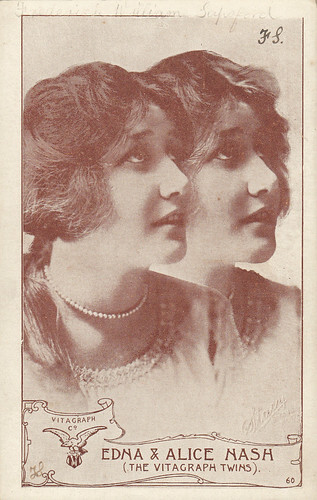
Vintage postcard, no. 60. Photo: Stacy / Vitagraph. Caption: The Vitagraph Twins.
Edna and Alice Nash were born on the 12th of October 1898 in New York, U.S.A. They made their screen debut at Vitagraph in Bunny and the Twins (1912). Until 1914, the two girls, who were known as the Vitagraph Twins, were featured in movies such as Two of a Kind (1913), Seeing Double (1913) or The Athletic Family (1914). In 1918, their last film, Love Watches, a Corinne Griffith vehicle, was released. From 1918 to 1921, they appeared in three Broadway musicals, produced by Charles Billingham at the Hippodrome Theatre. Edna passed away in April 1985. The date of Alice’s death is unknown.
The Dolly Sisters
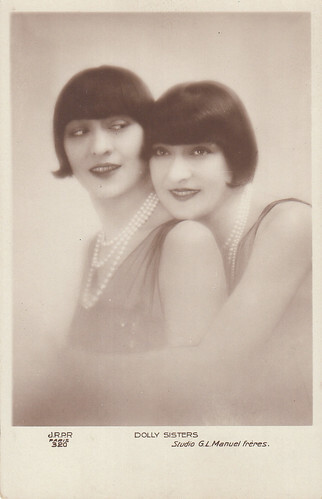
French postcard by J.R.P.R., Paris, no. 320. Photo: Studio G.L. Manuel frères. Collection: Marlene Pilaete.
Rozsika (later Rosie) and Janka (later Jenny) Deutsch were born on the 24th of October 1892 in Balassagyarmat, Hungary. The twins, who were to become famous as the Dolly Sisters, emigrated to the U.S.A. in 1905. In 1906, they began their dancing career and, in 1909, they appeared in their first Broadway show. They got their big break when they were cast in 'The Ziegfeld Follies of 1911' and soon got praise for their performance in 'The Merry Countess'. They also successfully toured with the musical 'Oh Look!' at the end of the 1910s. In 1915, they accepted movie offers: Jenny played an impoverished girl who becomes a famous dancer in Call of the Dance and Rosie was a beautiful temptress who steals Lillian Gish ’s husband in The Lily and the Rose. In 1918, they starred in The Million Dollar Dollies, directed by Leonce Perret for Emerald Pictures. In the 1920s, their fame spread to London and Paris, where they performed at the best venues. They retired at the end of the decade. Jenny was severely injured in a car crash in March 1933. She was in a coma for several days. Doctors had to replace her stomach to a normal position and she then embarked on several plastic surgery operations on her face. She never fully recovered, physically and mentally, and committed suicide in 1941. In 1945, the highly fictionalised biopic The Dolly Sisters was released. Jenny and Rosie were respectively played by Betty Grable and June Haver . Rosie passed away in 1970.
Daisy and Violet Hilton
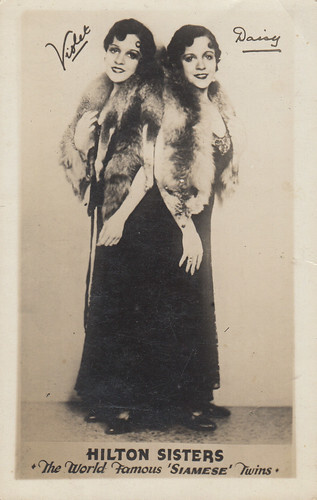
American postcard. Caption: Hilton Sisters, 'the World Famous Siamese Twins'.
Daisy and Violet were conjoined twins born on the 5th of February 1908 in Brighton, England. Their unmarried mother, Kate Skinner, soon abandoned them and left them at the hands of her employer, Mary Hilton, who became their legal guardian and who quickly realised the profits she could get from their public exposure. As they were looked upon as phenomenons, they were shamelessly exploited by this unscrupulous woman. When they were eight years old, they left for the U.S.A. and, over the years, became skilled musicians, singers and dancers. At the death of Mary Hilton in the 1920s, her daughter and her son-in-law took over Daisy and Violet’s management and continued to pocket most of the money the two girls, who were then high-paid entertainers in the vaudeville circuit, made from their shows. In 1931, a lawyer finally helped them to free themselves from their exploiters and they could at last reap the benefits of their work. In 1932, they made their screen debut in Tod Browning’s horror classic Freaks. Some twenty years later, they starred in the exploitation film Chained for Life (1951), in which one twin kills a scheming man who has wronged her sister. The justice is thus faced with a dilemma about the culprit: condemn her and, as a result, condemn her innocent sister too, or free her and leave her crime unpunished. Gradually, their popularity had faded and, as they never had a strong business sense, their finances dwindled. At the beginning of the 1960s, they found themselves stranded in Charlotte, North Carolina, abandoned by their touring manager and completely broke. They decided to settle there and found work in a grocery store. They died in 1969 from the Hong Kong flu.
The Dionne Quintuplets
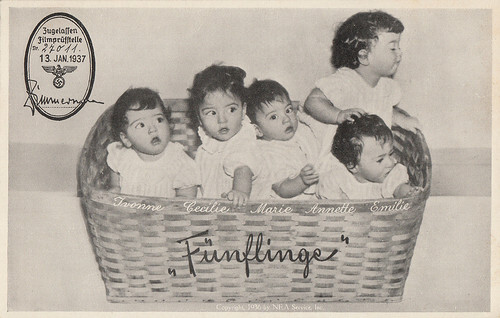
German promotional postcard by NEA Service, Inc., for the film The Country Doctor (Henry King, 1936). Caption: Quintuplets.
Yvonne, Cécile, Marie, Annette and Emilie Dionne were born on the 28th of May 1934 in Corbeil, Canada. They all survived, which was considered miraculous at the time, and attracted much attention. A few months after their birth, they were taken away from their family to be put first under the care of the Red Cross and, in March 1935, Ontario declared them wards of the Crown. Officially, they wanted to avoid them being commercially exploited and offer them harmonious growth. But it turned out differently as, paradoxically, Ontario would take unfair advantage of the twins, who never had a normal childhood and were considered public curiosities. They grew up in a hospital nursery especially built for them and their development was carefully studied by doctors. The place, soon called Quintland, would become a very lucrative tourist attraction for Ontario and would rival Niagara Falls in terms of economic profitability. Around three million people visited it to get a glimpse of the five phenomenons. Their image graced spoons, plates, postcards, calendars, fans, handkerchieves, playing cards, etc. and brands such as Palmolive, Quaker, Lysol or Colgate used them for their publicity. Dionne Quintuplets dolls were also produced by the famous Madame Alexander Doll Company. Hollywood also beckoned and 20th Century Fox starred them in The Country Doctor (1936), Reunion (1936) and Five of a Kind (1938). In 1943, Ontario finally gave the girls back to their parents but it was too late for them to establish strong ties with their family. They were unhappy and, when they were 18 years old, they left. Emilie died in 1954 and Marie in 1970. In 1998, following a lawsuit, Ontario had to pay the twins the sum of 4.000.000 Canadian dollars, in compensation for the harm suffered. In 2001, Yvonne passed away.
Mirtha and Silvia Legrand
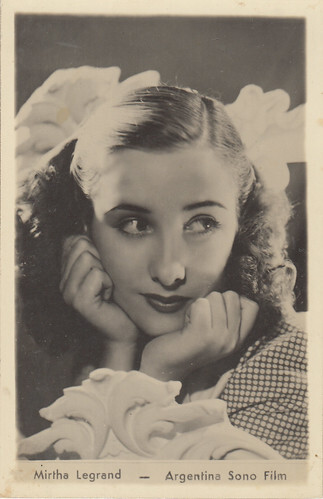
Argentinian postcard. Photo: Argentina Sono Film.
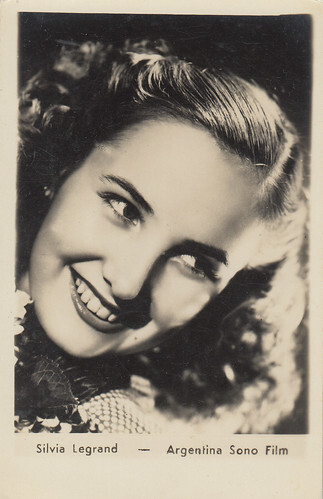
Argentinian postcard. Photo: Argentina Sono Film.
Mirtha and Silvia Legrand were born Rosa Maria Juana and Maria Aurelia Paula Martinez Suarez on the 23rd of February 1927 in Villa Canas, Argentina. They made their screen debut in small roles in a Nini Marshall vehicle, Hay que educar a Nini (1940) and quickly became famous. In the first half of the 1940s, Mirtha was featured in, notably, Los martes, orquideas (1941), Adolescencia (1942), El espejo (1943) or La pequena Senora de Perez (1944) and Silvia appeared in El tercer beso (1942), Su hermana menor (1943) or Siete mujeres (1944). The two sisters also co-starred in Sonar no cuesta nada (1941) and Claro de luna (1942). After El juego del amor y del hazar (1944), Sivia retired, following her marriage. Mirtha made a successful transition to adulthood and she was among the more brilliant stars of the Argentinian movie world thanks to movies such as Un beso en la nuca (1946), 30 segundos de amor (1947), La vendedora de fantasia (1950), De los ojos color del tiempo (1952), El amor nunca muere (1955), En la ardiente oscuridad (1958), La patota (1960), etc. From 1959 to 1962, Silvia came back to the screen in four movies, including Bajo un mismo rostro (1962), in which she co-starred again with her sister. Ten years later, she definitely ended her film career with Juan Manuel de Rosas (1972). Mirtha’s filmography ended with Con gusto a rabia (1963) and, from 1968 on, she embarked on an incredibly long and successful career on TV with her programs Almorzando con Mirtha Legrand and La noche de Mirtha. She became a true icon in her country. Silvia passed away in 2020.
Lee and Lyn Wilde
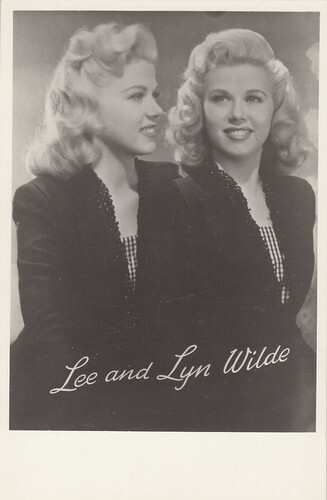
Dutch postcard by Takken, no. 3157.
Lee and Lyn Wilde were born Marion Lee and Mary Lyn Wilde in October 1922 in East St. Louis, Illinois, U.S.A. At the end of the 1930s, they performed on local radio stations and became band singers at the beginning of the 1940s. As themselves, they appeared in a few movies such as Juke Box Jenny (1942) or Presenting Lily Mars (1943). They got their first acting opportunities in Andy Hardy’s Double Trouble (1944) opposite Mickey Rooney and M.G.M. then starred in Twice Blessed (1945). They were also featured in Republic’s Campus Honeymoon (1947). They performed together for the last time onscreen in Look for the Silver Lining (1949) and Lee left the movie world to focus more on family life. From 1949 to 1953, Lyn continued her film career but the most important role she could get was in an Allan 'Rocky' Lane western, Sheriff of Wichita (1949). So, she also stepped out of the limelight to start a family. Lyn married Jim Cathcart in 1942 and Lee married his brother Tom in 1947. So, the twins became sisters-in-law. They both had two children from their marriage. The Cathcarts were musicians and, for the record, another brother, Jack, was married from 1941 to 1963 to Judy Garland ’s sister, Mary Jane 'Suzanne' Gumm. Lee died in 2015 and Lyn passed away in 2016.
Pier Angeli and Marisa Pavan
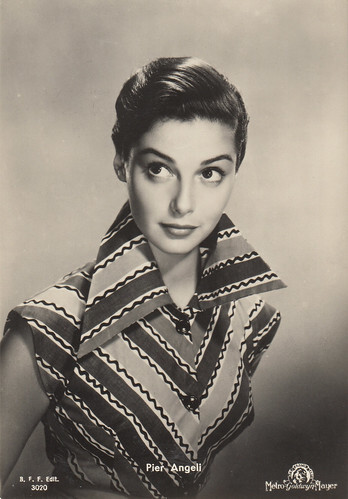
Italian postcard by B.F.F., Firenze, no. 3020. Photo: Metro Goldwyn Mayer.
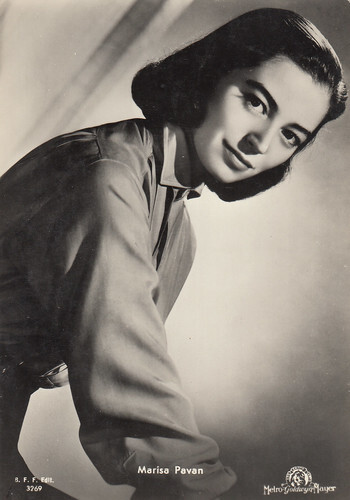
Italian postcard by B.F.F., Firenze, no. 3069. Photo: Metro Goldwyn Mayer.
Pier Angeli and Marisa Pavan were born Anna Maria and Maria Teresa Pierangeli on the 19th of June 1932 in Cagliari, Italy. Anna Maria was the first to become famous thanks to Domani è troppo tardi (1950), followed by Domani è un altro giorno (1951). She then went to Hollywood, where her name was shortened to Pier Angeli . In America, she notably starred in Teresa (1951), The Light Touch (1952), The Story of Three Loves (1953), Somebody Up There Likes Me (1956) and Merry Andrew (1958). In Europe, she also co-starred with famous French comedian Fernandel in Mam’zelle Nitouche (1954) and had an interesting part in the British movie The Angry Silence (1960). She had an affair with James Dean but her mother disapproved of it and they separated. In the 1960s, her career declined and most of her roles were less noteworthy. On the 10th of September 1971, she was given an injection of tranquillizer by a doctor and died from a cardiac arrest during her sleep, probably from anaphylaxis.
As Marisa Pavan , Maria Teresa made her screen debut in a supporting role as Robert Wagner ’s love interest in John Ford’s What Price Glory (1952). 'Pavan' was the name of a Jewish officer her parents had hidden during World War II. She then came back to Italy to star in Ho scelto l’amore (1953). Her Hollywood films include Drum Beat (1954), Down Three Dark Streets (1954), The Rose Tattoo (1955), Diane (1956) and The Midnight Story (1957). She didn’t appear in many movies after 1960 but continued to perform on stage and on television until the beginning of the 1990s. The great love of her life was French actor Jean-Pierre Aumont , whom she married in 1956. In 2004, she became president of an association called U.R.M.A. which supported medical research on Alzheimer’s disease and which was dissolved in 2019. She currently lives in the South of France.
Isa and Jutta Günther
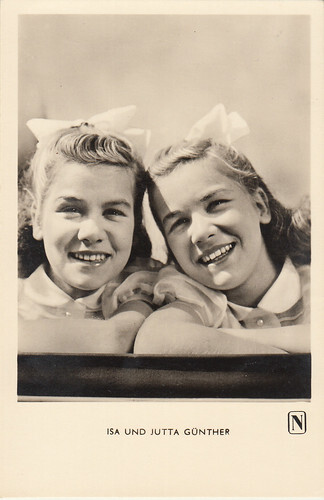
German postcard by Kunst und Bild, Berlin, no. A 104. Photo: N.
Isa and Jutta Günther were born on the 20th of May 1938 in München, Germany. They made their screen debut in Das doppelte Lottchen (1950), which made them famous. Their other films include Das Wirtin von Maria Wirth (1952), Der Erste Kus (1954) or Vier Mädels aus der Wachau (1957). Isa also played the young crippled girl Klara Sesemann in Heidi (1952) and Heidi und Peter (1955). The twin’s career ended with Der Sünderbock vom Spatzenhausen (1958) and they thereafter led a quiet family life.
Alice and Ellen Kessler
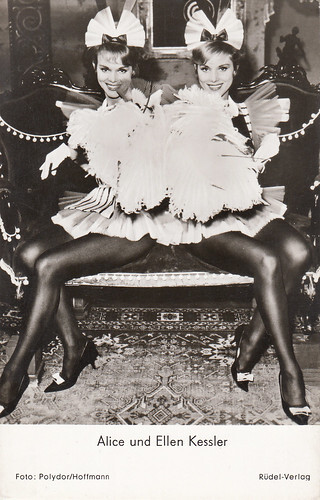
German postcard by Rüdel Verlag, no. 3836. Photo: Polydor / Hoffmann.
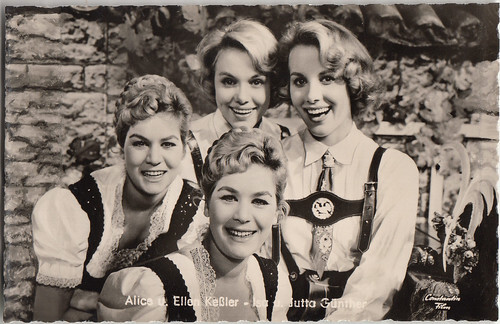
German postcard by Kolibri, no. 2763. Photo: Constantin Film. Alice Kessler , Ellen Kessler , Isa Günther and Jutta Günther . The two Germany’s most famous pairs of twins of their time co-starred in one film, Vier Mädels aus der Wachau (Franz Antel, 1957).
The Kessler twins were born as Alice and Ellen Kässler on the 20th of August 1936 in Nerchau, Germany. They were taught dancing since childhood and got their big break in the mid-1950s when they were hired at the Lido, one of the best-known cabarets in Paris. They soon became internationally famous and performed all around the world. From 1955 to 1964, they also appeared in about twenty movies, which were filmed in Germany, Austria, France and Italy. They include Solang’es hübsche Mädchen gibt (1955), Mit Rosen fängt die Liebe an (1957), Vier Mädels aus der Wachau (1957), Tabarin (1958), Mein Schatz ist aus Tirol (1958), Les magiciennes (1960), Rocco e le sorelle (1961) or Hochzeitsnacht im Paradies (1962). They also had a brilliant career on TV, especially in Italy, and made several records.
Pili and Mili
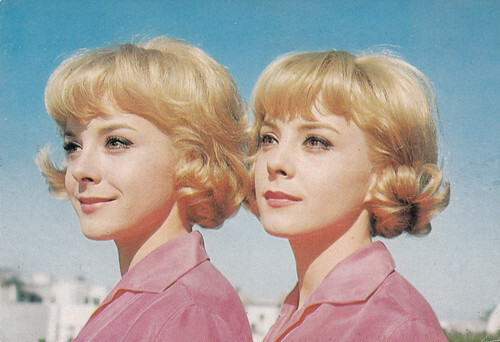
Spanish postcard by Oscarcolor, no. 354.
Pili and Mili were born as Pilar and Aurora Bayona Sarria on the 10th of February 1947 in Zaragoza, Spain. They became stars with their first movie Como dos gotas de agua (1964). In their native country, they were also featured in Whisky y vodka (1965), Dos chicas locas locas (1965), Dos pistolas gemelas (1966) and Agachate, que disparan (1969). They were also very popular in Latin America. In Argentina, they co-starred with Nini Marshall in Escandolo en la familia (1967) and they filmed in Mexico Un novio para dos hermanas (1967), Vestidas y alborotadas/Dos gemelas estupendas (1968) and La princesa hipie (1969). Mili, who had married in 1968, chose to retire after a last movie with her sister, La guerra de las monjas (1970). Pili appeared again in a few Mexican movies such as El club de los suicidas (1970) or El tesoro di Morgan (1971) and then went back to Spain. As Pilar Bayona , she continued her acting career on stage, on TV and, occasionally, in movies, without regaining the success she had met in the 1960s with her twin sister.
Text and postcards: Marlene Pilaete.
Madeline and Marion Fairbanks

British postcard. Photo: Thanhouser.
Madeleine (later Madeline) and Marion Fairbanks were born on the 15th of November 1900 in New York, U.S.A. They made their screen debut at Biograph in 1910 but they became stars at the Tanhouser company in 1912. Until 1916, Madeline and Marion Fairbanks were famous as the Thanhouser Twins and were featured in movies such as The Twins (1912), Cousins (1912), Their Great Beautiful Doll (1913), Twins and a Stepmother (1914), The Widow’s Mite (1914), The Flying Twins (1915) or The Burglar’s Picnic (1916). The two sisters also appeared separately in several films. After they had left Thanhouser, they turned to a stage career and notably appeared in the 'Ziegfeld Follies of 1917', 1918 and 1919. They also performed in Irving Berlin’s 'Music Box Revue' during the season 1922-1923. They came back twice to the movie world in The Beauty Shop (1922), in which their characters are named Coca and Cola, and On With the Show (1929). They retired in the 1930s. Marion passed away in 1973 and Madeline died in 1989.
Edna and Alice Nash

Vintage postcard, no. 60. Photo: Stacy / Vitagraph. Caption: The Vitagraph Twins.
Edna and Alice Nash were born on the 12th of October 1898 in New York, U.S.A. They made their screen debut at Vitagraph in Bunny and the Twins (1912). Until 1914, the two girls, who were known as the Vitagraph Twins, were featured in movies such as Two of a Kind (1913), Seeing Double (1913) or The Athletic Family (1914). In 1918, their last film, Love Watches, a Corinne Griffith vehicle, was released. From 1918 to 1921, they appeared in three Broadway musicals, produced by Charles Billingham at the Hippodrome Theatre. Edna passed away in April 1985. The date of Alice’s death is unknown.
The Dolly Sisters

French postcard by J.R.P.R., Paris, no. 320. Photo: Studio G.L. Manuel frères. Collection: Marlene Pilaete.
Rozsika (later Rosie) and Janka (later Jenny) Deutsch were born on the 24th of October 1892 in Balassagyarmat, Hungary. The twins, who were to become famous as the Dolly Sisters, emigrated to the U.S.A. in 1905. In 1906, they began their dancing career and, in 1909, they appeared in their first Broadway show. They got their big break when they were cast in 'The Ziegfeld Follies of 1911' and soon got praise for their performance in 'The Merry Countess'. They also successfully toured with the musical 'Oh Look!' at the end of the 1910s. In 1915, they accepted movie offers: Jenny played an impoverished girl who becomes a famous dancer in Call of the Dance and Rosie was a beautiful temptress who steals Lillian Gish ’s husband in The Lily and the Rose. In 1918, they starred in The Million Dollar Dollies, directed by Leonce Perret for Emerald Pictures. In the 1920s, their fame spread to London and Paris, where they performed at the best venues. They retired at the end of the decade. Jenny was severely injured in a car crash in March 1933. She was in a coma for several days. Doctors had to replace her stomach to a normal position and she then embarked on several plastic surgery operations on her face. She never fully recovered, physically and mentally, and committed suicide in 1941. In 1945, the highly fictionalised biopic The Dolly Sisters was released. Jenny and Rosie were respectively played by Betty Grable and June Haver . Rosie passed away in 1970.
Daisy and Violet Hilton

American postcard. Caption: Hilton Sisters, 'the World Famous Siamese Twins'.
Daisy and Violet were conjoined twins born on the 5th of February 1908 in Brighton, England. Their unmarried mother, Kate Skinner, soon abandoned them and left them at the hands of her employer, Mary Hilton, who became their legal guardian and who quickly realised the profits she could get from their public exposure. As they were looked upon as phenomenons, they were shamelessly exploited by this unscrupulous woman. When they were eight years old, they left for the U.S.A. and, over the years, became skilled musicians, singers and dancers. At the death of Mary Hilton in the 1920s, her daughter and her son-in-law took over Daisy and Violet’s management and continued to pocket most of the money the two girls, who were then high-paid entertainers in the vaudeville circuit, made from their shows. In 1931, a lawyer finally helped them to free themselves from their exploiters and they could at last reap the benefits of their work. In 1932, they made their screen debut in Tod Browning’s horror classic Freaks. Some twenty years later, they starred in the exploitation film Chained for Life (1951), in which one twin kills a scheming man who has wronged her sister. The justice is thus faced with a dilemma about the culprit: condemn her and, as a result, condemn her innocent sister too, or free her and leave her crime unpunished. Gradually, their popularity had faded and, as they never had a strong business sense, their finances dwindled. At the beginning of the 1960s, they found themselves stranded in Charlotte, North Carolina, abandoned by their touring manager and completely broke. They decided to settle there and found work in a grocery store. They died in 1969 from the Hong Kong flu.
The Dionne Quintuplets

German promotional postcard by NEA Service, Inc., for the film The Country Doctor (Henry King, 1936). Caption: Quintuplets.
Yvonne, Cécile, Marie, Annette and Emilie Dionne were born on the 28th of May 1934 in Corbeil, Canada. They all survived, which was considered miraculous at the time, and attracted much attention. A few months after their birth, they were taken away from their family to be put first under the care of the Red Cross and, in March 1935, Ontario declared them wards of the Crown. Officially, they wanted to avoid them being commercially exploited and offer them harmonious growth. But it turned out differently as, paradoxically, Ontario would take unfair advantage of the twins, who never had a normal childhood and were considered public curiosities. They grew up in a hospital nursery especially built for them and their development was carefully studied by doctors. The place, soon called Quintland, would become a very lucrative tourist attraction for Ontario and would rival Niagara Falls in terms of economic profitability. Around three million people visited it to get a glimpse of the five phenomenons. Their image graced spoons, plates, postcards, calendars, fans, handkerchieves, playing cards, etc. and brands such as Palmolive, Quaker, Lysol or Colgate used them for their publicity. Dionne Quintuplets dolls were also produced by the famous Madame Alexander Doll Company. Hollywood also beckoned and 20th Century Fox starred them in The Country Doctor (1936), Reunion (1936) and Five of a Kind (1938). In 1943, Ontario finally gave the girls back to their parents but it was too late for them to establish strong ties with their family. They were unhappy and, when they were 18 years old, they left. Emilie died in 1954 and Marie in 1970. In 1998, following a lawsuit, Ontario had to pay the twins the sum of 4.000.000 Canadian dollars, in compensation for the harm suffered. In 2001, Yvonne passed away.
Mirtha and Silvia Legrand

Argentinian postcard. Photo: Argentina Sono Film.

Argentinian postcard. Photo: Argentina Sono Film.
Mirtha and Silvia Legrand were born Rosa Maria Juana and Maria Aurelia Paula Martinez Suarez on the 23rd of February 1927 in Villa Canas, Argentina. They made their screen debut in small roles in a Nini Marshall vehicle, Hay que educar a Nini (1940) and quickly became famous. In the first half of the 1940s, Mirtha was featured in, notably, Los martes, orquideas (1941), Adolescencia (1942), El espejo (1943) or La pequena Senora de Perez (1944) and Silvia appeared in El tercer beso (1942), Su hermana menor (1943) or Siete mujeres (1944). The two sisters also co-starred in Sonar no cuesta nada (1941) and Claro de luna (1942). After El juego del amor y del hazar (1944), Sivia retired, following her marriage. Mirtha made a successful transition to adulthood and she was among the more brilliant stars of the Argentinian movie world thanks to movies such as Un beso en la nuca (1946), 30 segundos de amor (1947), La vendedora de fantasia (1950), De los ojos color del tiempo (1952), El amor nunca muere (1955), En la ardiente oscuridad (1958), La patota (1960), etc. From 1959 to 1962, Silvia came back to the screen in four movies, including Bajo un mismo rostro (1962), in which she co-starred again with her sister. Ten years later, she definitely ended her film career with Juan Manuel de Rosas (1972). Mirtha’s filmography ended with Con gusto a rabia (1963) and, from 1968 on, she embarked on an incredibly long and successful career on TV with her programs Almorzando con Mirtha Legrand and La noche de Mirtha. She became a true icon in her country. Silvia passed away in 2020.
Lee and Lyn Wilde

Dutch postcard by Takken, no. 3157.
Lee and Lyn Wilde were born Marion Lee and Mary Lyn Wilde in October 1922 in East St. Louis, Illinois, U.S.A. At the end of the 1930s, they performed on local radio stations and became band singers at the beginning of the 1940s. As themselves, they appeared in a few movies such as Juke Box Jenny (1942) or Presenting Lily Mars (1943). They got their first acting opportunities in Andy Hardy’s Double Trouble (1944) opposite Mickey Rooney and M.G.M. then starred in Twice Blessed (1945). They were also featured in Republic’s Campus Honeymoon (1947). They performed together for the last time onscreen in Look for the Silver Lining (1949) and Lee left the movie world to focus more on family life. From 1949 to 1953, Lyn continued her film career but the most important role she could get was in an Allan 'Rocky' Lane western, Sheriff of Wichita (1949). So, she also stepped out of the limelight to start a family. Lyn married Jim Cathcart in 1942 and Lee married his brother Tom in 1947. So, the twins became sisters-in-law. They both had two children from their marriage. The Cathcarts were musicians and, for the record, another brother, Jack, was married from 1941 to 1963 to Judy Garland ’s sister, Mary Jane 'Suzanne' Gumm. Lee died in 2015 and Lyn passed away in 2016.
Pier Angeli and Marisa Pavan

Italian postcard by B.F.F., Firenze, no. 3020. Photo: Metro Goldwyn Mayer.

Italian postcard by B.F.F., Firenze, no. 3069. Photo: Metro Goldwyn Mayer.
Pier Angeli and Marisa Pavan were born Anna Maria and Maria Teresa Pierangeli on the 19th of June 1932 in Cagliari, Italy. Anna Maria was the first to become famous thanks to Domani è troppo tardi (1950), followed by Domani è un altro giorno (1951). She then went to Hollywood, where her name was shortened to Pier Angeli . In America, she notably starred in Teresa (1951), The Light Touch (1952), The Story of Three Loves (1953), Somebody Up There Likes Me (1956) and Merry Andrew (1958). In Europe, she also co-starred with famous French comedian Fernandel in Mam’zelle Nitouche (1954) and had an interesting part in the British movie The Angry Silence (1960). She had an affair with James Dean but her mother disapproved of it and they separated. In the 1960s, her career declined and most of her roles were less noteworthy. On the 10th of September 1971, she was given an injection of tranquillizer by a doctor and died from a cardiac arrest during her sleep, probably from anaphylaxis.
As Marisa Pavan , Maria Teresa made her screen debut in a supporting role as Robert Wagner ’s love interest in John Ford’s What Price Glory (1952). 'Pavan' was the name of a Jewish officer her parents had hidden during World War II. She then came back to Italy to star in Ho scelto l’amore (1953). Her Hollywood films include Drum Beat (1954), Down Three Dark Streets (1954), The Rose Tattoo (1955), Diane (1956) and The Midnight Story (1957). She didn’t appear in many movies after 1960 but continued to perform on stage and on television until the beginning of the 1990s. The great love of her life was French actor Jean-Pierre Aumont , whom she married in 1956. In 2004, she became president of an association called U.R.M.A. which supported medical research on Alzheimer’s disease and which was dissolved in 2019. She currently lives in the South of France.
Isa and Jutta Günther

German postcard by Kunst und Bild, Berlin, no. A 104. Photo: N.
Isa and Jutta Günther were born on the 20th of May 1938 in München, Germany. They made their screen debut in Das doppelte Lottchen (1950), which made them famous. Their other films include Das Wirtin von Maria Wirth (1952), Der Erste Kus (1954) or Vier Mädels aus der Wachau (1957). Isa also played the young crippled girl Klara Sesemann in Heidi (1952) and Heidi und Peter (1955). The twin’s career ended with Der Sünderbock vom Spatzenhausen (1958) and they thereafter led a quiet family life.
Alice and Ellen Kessler

German postcard by Rüdel Verlag, no. 3836. Photo: Polydor / Hoffmann.

German postcard by Kolibri, no. 2763. Photo: Constantin Film. Alice Kessler , Ellen Kessler , Isa Günther and Jutta Günther . The two Germany’s most famous pairs of twins of their time co-starred in one film, Vier Mädels aus der Wachau (Franz Antel, 1957).
The Kessler twins were born as Alice and Ellen Kässler on the 20th of August 1936 in Nerchau, Germany. They were taught dancing since childhood and got their big break in the mid-1950s when they were hired at the Lido, one of the best-known cabarets in Paris. They soon became internationally famous and performed all around the world. From 1955 to 1964, they also appeared in about twenty movies, which were filmed in Germany, Austria, France and Italy. They include Solang’es hübsche Mädchen gibt (1955), Mit Rosen fängt die Liebe an (1957), Vier Mädels aus der Wachau (1957), Tabarin (1958), Mein Schatz ist aus Tirol (1958), Les magiciennes (1960), Rocco e le sorelle (1961) or Hochzeitsnacht im Paradies (1962). They also had a brilliant career on TV, especially in Italy, and made several records.
Pili and Mili

Spanish postcard by Oscarcolor, no. 354.
Pili and Mili were born as Pilar and Aurora Bayona Sarria on the 10th of February 1947 in Zaragoza, Spain. They became stars with their first movie Como dos gotas de agua (1964). In their native country, they were also featured in Whisky y vodka (1965), Dos chicas locas locas (1965), Dos pistolas gemelas (1966) and Agachate, que disparan (1969). They were also very popular in Latin America. In Argentina, they co-starred with Nini Marshall in Escandolo en la familia (1967) and they filmed in Mexico Un novio para dos hermanas (1967), Vestidas y alborotadas/Dos gemelas estupendas (1968) and La princesa hipie (1969). Mili, who had married in 1968, chose to retire after a last movie with her sister, La guerra de las monjas (1970). Pili appeared again in a few Mexican movies such as El club de los suicidas (1970) or El tesoro di Morgan (1971) and then went back to Spain. As Pilar Bayona , she continued her acting career on stage, on TV and, occasionally, in movies, without regaining the success she had met in the 1960s with her twin sister.
Text and postcards: Marlene Pilaete.
Published on October 04, 2023 22:00
October 3, 2023
Planet of the Apes (2001)
Next week, the exhibition 'The World of Tim Burton' makes its Italian debut at the Museo Nazionale del Cinema in Turin. One of our favourite directors in one of the most wonderful film museums in the world, the Mole Antonelliana. For the occasion, EFSP has a post on his Planet of the Apes (Tim Burton, 2001), the sixth instalment in the Planet of the Apes film series. The film is loosely based on the 1963 novel of the same name by Pierre Boulle and serves as a remake of the 1968 film version. It tells the story of astronaut Leo Davidson (Mark Wahlberg) crash-landing on a planet inhabited by intelligent apes. The apes treat humans as slaves, but with the help of an ape named Ari (Helena Bonham Carter), Leo starts a rebellion. Tim Roth, Michael Clarke Duncan, Kris Kristofferson, Estella Warren, and Paul Giamatti also star and there are cameos by Charlton Heston and Linda Harrison who both participated in Planet of the Apes (1968) and Beneath the Planet of the Apes (1970).
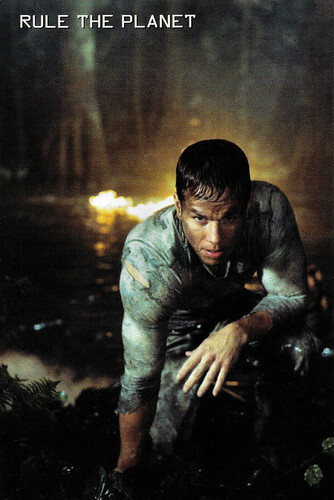
Australian freecard by Avanti. Photo: 20th Century Fox. Mark Wahlberg in Planet of the Apes (Tim Burton, 2001). Caption: Mark Wahlberg as Leo Davidson - American Astronaut.
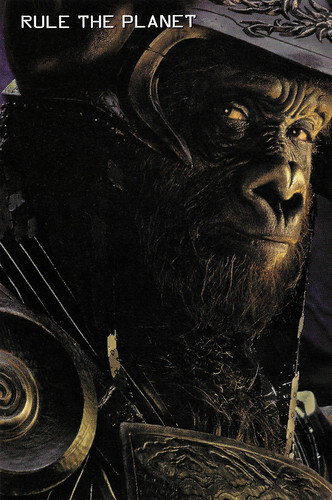
Australian freecard by Avanti, 2001, no. 5865. Photo: 20th Century Fox. Michael Clark Duncan in Planet of the Apes (Tim Burton, 2001). Caption: Rule the planet. Michael Clark Duncan as Attar - Gorilla Warrior.
A strange unknown planet in the year 5021
Development for a Planet of the Apes remake started as far back as 1988 with Adam Rifkin. His project nearly reached the pre-production stage before being cancelled. Terry Hayes's script, titled Return of the Apes, would have starred Arnold Schwarzenegger , under the direction of Phillip Noyce. Oliver Stone, Don Murphy, and Jane Hamsher were set to produce.
Creative differences ensued between Hayes and distributor 20th Century Fox. Chris Columbus, Sam Hamm, James Cameron, Peter Jackson, and the Hughes brothers later became involved. With Broyles Jr.'s script, Tim Burton was hired as director, and the film was put into active development. Konner and Rosenthal rewrote the script, and filming took place from November 2000 to April 2001.
It is the year 2029. The spaceship Oberon, in which astronaut Leo Davidson (Mark Wahlberg) is working, encounters a magnetic storm. On board the ship are live monkeys trained to investigate. Leo's favourite monkey Pericles goes to find out what happened. However, he loses contact with the Oberon.
Leo then also goes to investigate but ends up in a wormhole, after which he ends up on a strange unknown planet, where people live in the year 5021. His cruiser, the machine he crashed on the planet with, is damaged beyond repair. The strange thing is that on the planet, not humans are in charge, but monkeys. The apes capture all humans on that planet, regarding them as animals. A number of humans, including Leo, are captured by the apes and put behind bars at the orangutan Limbo's (Paul Giamatti) monkey trading centre. The idea is that they will be bought by directors of companies that need slaves.
The arrested meet Ari (Helena Bonham Carter), an activist fighting for human rights. Ari buys Leo. However, Leo manages to escape and he goes to Limbo's building where all the other people are imprisoned. He lets them escape and they take off. Ari, however, sees them. Leo tells Ari to escape with them so he can show her something. Together, they all try to escape. Some other monkeys they come across also take them with them. Meanwhile, Ari's father, Senator Sandar (David Warner), a very powerful monkey, thinks she has been kidnapped. He enlists General Thade's (Tim Roth) giant ape army to stop Leo and his group.
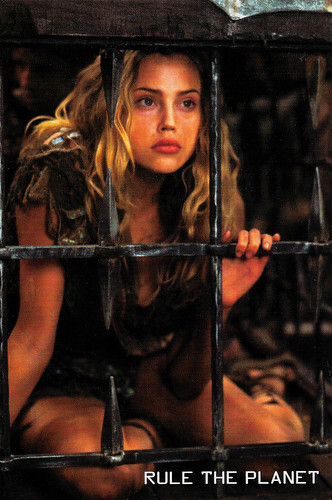
Australian freecard by Avanti, 2001, no. 5864. Photo: 20th Century Fox. Estella Warren in Planet of the Apes (Tim Burton, 2001). Caption: Rule the planet, Estella Warren as Daena.
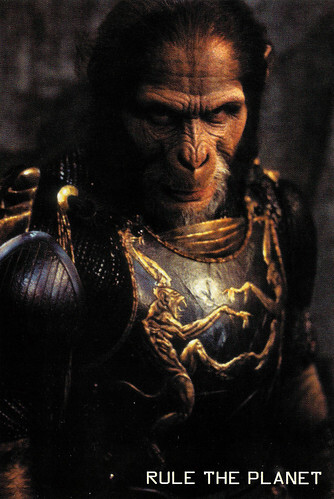
Australian freecard by Avanti, 2001, no. 5864. Photo: 20th Century Fox. Tim Roth in Planet of the Apes (Tim Burton, 2001). Caption: Rule the planet, Tim Roth as Thade - General of the Ape Army.
Using real actors in costumes
Fox considered using computer animation to portray the monkeys as much as possible, but director Tim Burton insisted on using real actors in costumes. Rick Baker was hired to help develop the grime and costumes. On his hiring, Baker explained, "I did the Dino De Laurentiis version of King Kong in 1976 and was always disappointed because I wasn't able to do it as realistically as I wanted. I thought Apes would be a good way to make up for that." The grime for 1 actor took about 4.5 hours to apply, and another 1.5 hours to remove again.
Tim Burton hired regular collaborator Danny Elfman as a composer. Elfman had already previously attached when Adam Rifkin planned to do his own remake in 1989. Elfman noted that his work on Planet of the Apes contained more percussion instruments than usual. Planet of the Apes was the last film Burton worked on with his former fiancée Lisa Marie. After their relationship broke up, Burton started a relationship with Helena Bonham Carter, who portrayed Ari.
Planet of the Apes was released in the United States on 27 July 2001, by 20th Century Fox. The film was nominated for two BAFTA Awards, one for Best Make-up held by Rick Baker, and the other for Best Costume Design by Colleen Atwood. The film received mixed reviews from critics, who criticised the confusing plot and ending but praised Rick Baker's prosthetic makeup designs, visual aspects, and Elfman's musical score.
Film critic Roger Ebert wrote: "Tim Burton's Planet of the Apes wants to be all things to all men, and all apes. It's an action picture and a satire of an action picture. It's a comedy and then it gets serious. It's a social satire and then backs away from pushing that angle too far. It even has a weird intra-species romantic triangle in it. And it has a surprise ending that I loved(...) The movie could have been more. It could have been a parable of men and animals, as daring as Animal Farm. It could have dealt in social commentary with a sting, and satire that hurt. It could have supported, or attacked, the animal rights movement. It could have dealt with the intriguing question of whether a man and a gorilla having sex is open-mindedness, or bestiality (and, if bestiality, in both directions?). It could have, but it doesn't. It's a cautious movie, earning every letter and numeral of its PG-13 rating. Intellectually, it's science fiction for junior high school boys."
Fox initially stated that if Planet of the Apes was a financial success, then a sequel would be commissioned. Planet of the Apes raised $362,211,740 worldwide, making it the 9th most successful film in North America at the time. Despite its financial success, Fox chose not to produce a sequel. Reportedly, Tim Burton said that he would rather jump out of a window than direct a sequel to this film. Fox later rebooted the film series with Rise of the Planet of the Apes (Rupert Wyatt, 2011).
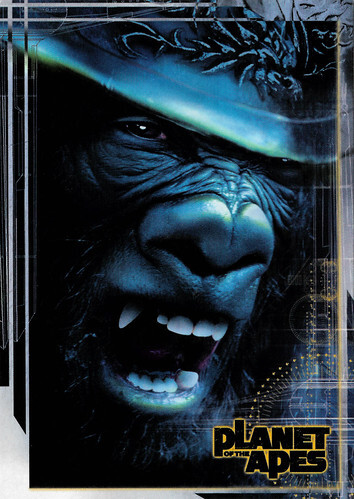
British postcard by GB Posters, Sheffield, no. PC0444. Photo: 20th Century Fox. Michael Clark Duncan as in Planet of the Apes (Tim Burton, 2001). Caption: Planet of the Apes attar frame.
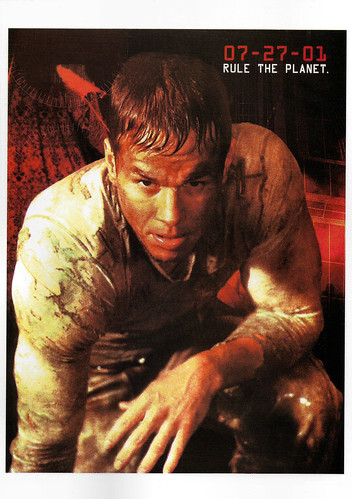
Vintage postcard in the Cinemascope Collection, no. 449. Photo: 20th Century Fox. Mark Wahlberg in Planet of the Apes (Tim Burton, 2001). Caption: Rule the Planet - Planet of the Apes - The Visitor.
Source: Roger Ebert (Roger Ebert.com), Wikipedia (English and Dutch) and IMDb.
The World of Tim Burton
'The World of Tim Burton' was conceived and co-curated by Jenny He in collaboration with Tim Burton and was adapted by Domenico De Gaetano for the Museo Nazionale del Cinema. Split into 9 thematic sections, it features over 500 examples of rarely or never-before-seen original artworks from Burton's early ages through to the most recent projects across mediums of sketches, paintings, drawings, photographs, concept art, storyboards, costumes, moving-image works, maquettes, puppets and life-sized sculptural installations. You can visit the exhibition at the Museo Nazionale del Cinema in Turin till 7 April 2024.

Australian freecard by Avanti. Photo: 20th Century Fox. Mark Wahlberg in Planet of the Apes (Tim Burton, 2001). Caption: Mark Wahlberg as Leo Davidson - American Astronaut.

Australian freecard by Avanti, 2001, no. 5865. Photo: 20th Century Fox. Michael Clark Duncan in Planet of the Apes (Tim Burton, 2001). Caption: Rule the planet. Michael Clark Duncan as Attar - Gorilla Warrior.
A strange unknown planet in the year 5021
Development for a Planet of the Apes remake started as far back as 1988 with Adam Rifkin. His project nearly reached the pre-production stage before being cancelled. Terry Hayes's script, titled Return of the Apes, would have starred Arnold Schwarzenegger , under the direction of Phillip Noyce. Oliver Stone, Don Murphy, and Jane Hamsher were set to produce.
Creative differences ensued between Hayes and distributor 20th Century Fox. Chris Columbus, Sam Hamm, James Cameron, Peter Jackson, and the Hughes brothers later became involved. With Broyles Jr.'s script, Tim Burton was hired as director, and the film was put into active development. Konner and Rosenthal rewrote the script, and filming took place from November 2000 to April 2001.
It is the year 2029. The spaceship Oberon, in which astronaut Leo Davidson (Mark Wahlberg) is working, encounters a magnetic storm. On board the ship are live monkeys trained to investigate. Leo's favourite monkey Pericles goes to find out what happened. However, he loses contact with the Oberon.
Leo then also goes to investigate but ends up in a wormhole, after which he ends up on a strange unknown planet, where people live in the year 5021. His cruiser, the machine he crashed on the planet with, is damaged beyond repair. The strange thing is that on the planet, not humans are in charge, but monkeys. The apes capture all humans on that planet, regarding them as animals. A number of humans, including Leo, are captured by the apes and put behind bars at the orangutan Limbo's (Paul Giamatti) monkey trading centre. The idea is that they will be bought by directors of companies that need slaves.
The arrested meet Ari (Helena Bonham Carter), an activist fighting for human rights. Ari buys Leo. However, Leo manages to escape and he goes to Limbo's building where all the other people are imprisoned. He lets them escape and they take off. Ari, however, sees them. Leo tells Ari to escape with them so he can show her something. Together, they all try to escape. Some other monkeys they come across also take them with them. Meanwhile, Ari's father, Senator Sandar (David Warner), a very powerful monkey, thinks she has been kidnapped. He enlists General Thade's (Tim Roth) giant ape army to stop Leo and his group.

Australian freecard by Avanti, 2001, no. 5864. Photo: 20th Century Fox. Estella Warren in Planet of the Apes (Tim Burton, 2001). Caption: Rule the planet, Estella Warren as Daena.

Australian freecard by Avanti, 2001, no. 5864. Photo: 20th Century Fox. Tim Roth in Planet of the Apes (Tim Burton, 2001). Caption: Rule the planet, Tim Roth as Thade - General of the Ape Army.
Using real actors in costumes
Fox considered using computer animation to portray the monkeys as much as possible, but director Tim Burton insisted on using real actors in costumes. Rick Baker was hired to help develop the grime and costumes. On his hiring, Baker explained, "I did the Dino De Laurentiis version of King Kong in 1976 and was always disappointed because I wasn't able to do it as realistically as I wanted. I thought Apes would be a good way to make up for that." The grime for 1 actor took about 4.5 hours to apply, and another 1.5 hours to remove again.
Tim Burton hired regular collaborator Danny Elfman as a composer. Elfman had already previously attached when Adam Rifkin planned to do his own remake in 1989. Elfman noted that his work on Planet of the Apes contained more percussion instruments than usual. Planet of the Apes was the last film Burton worked on with his former fiancée Lisa Marie. After their relationship broke up, Burton started a relationship with Helena Bonham Carter, who portrayed Ari.
Planet of the Apes was released in the United States on 27 July 2001, by 20th Century Fox. The film was nominated for two BAFTA Awards, one for Best Make-up held by Rick Baker, and the other for Best Costume Design by Colleen Atwood. The film received mixed reviews from critics, who criticised the confusing plot and ending but praised Rick Baker's prosthetic makeup designs, visual aspects, and Elfman's musical score.
Film critic Roger Ebert wrote: "Tim Burton's Planet of the Apes wants to be all things to all men, and all apes. It's an action picture and a satire of an action picture. It's a comedy and then it gets serious. It's a social satire and then backs away from pushing that angle too far. It even has a weird intra-species romantic triangle in it. And it has a surprise ending that I loved(...) The movie could have been more. It could have been a parable of men and animals, as daring as Animal Farm. It could have dealt in social commentary with a sting, and satire that hurt. It could have supported, or attacked, the animal rights movement. It could have dealt with the intriguing question of whether a man and a gorilla having sex is open-mindedness, or bestiality (and, if bestiality, in both directions?). It could have, but it doesn't. It's a cautious movie, earning every letter and numeral of its PG-13 rating. Intellectually, it's science fiction for junior high school boys."
Fox initially stated that if Planet of the Apes was a financial success, then a sequel would be commissioned. Planet of the Apes raised $362,211,740 worldwide, making it the 9th most successful film in North America at the time. Despite its financial success, Fox chose not to produce a sequel. Reportedly, Tim Burton said that he would rather jump out of a window than direct a sequel to this film. Fox later rebooted the film series with Rise of the Planet of the Apes (Rupert Wyatt, 2011).

British postcard by GB Posters, Sheffield, no. PC0444. Photo: 20th Century Fox. Michael Clark Duncan as in Planet of the Apes (Tim Burton, 2001). Caption: Planet of the Apes attar frame.

Vintage postcard in the Cinemascope Collection, no. 449. Photo: 20th Century Fox. Mark Wahlberg in Planet of the Apes (Tim Burton, 2001). Caption: Rule the Planet - Planet of the Apes - The Visitor.
Source: Roger Ebert (Roger Ebert.com), Wikipedia (English and Dutch) and IMDb.
The World of Tim Burton
'The World of Tim Burton' was conceived and co-curated by Jenny He in collaboration with Tim Burton and was adapted by Domenico De Gaetano for the Museo Nazionale del Cinema. Split into 9 thematic sections, it features over 500 examples of rarely or never-before-seen original artworks from Burton's early ages through to the most recent projects across mediums of sketches, paintings, drawings, photographs, concept art, storyboards, costumes, moving-image works, maquettes, puppets and life-sized sculptural installations. You can visit the exhibition at the Museo Nazionale del Cinema in Turin till 7 April 2024.
Published on October 03, 2023 22:00
October 2, 2023
Diomira Jacobini
Diomira Jacobini (1899-1959) was one of the stars of the Italian silent cinema. She was the younger sister of film diva Maria Jacobini, in whose shadow she always stayed. Diomira appeared in some 55 films in Italy and Germany.
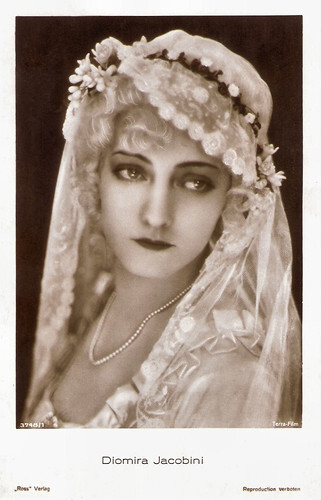
German postcard by Ross Verlag, no. 3748/1, 1928-1929. Source: Terra-Film. Diomira Jacobini in Revolutionshochzeit//The Last Night (A.W. Sandberg, 1928).
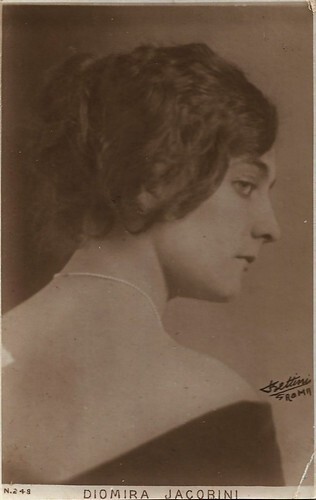
Italian postcard, no. 248. Photo: Bettini, Roma.
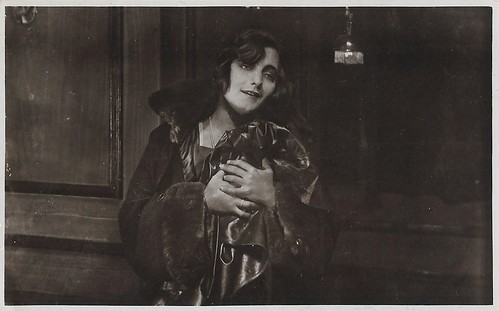
Italian postcard. Photo: Fert Film. Diomira Jacobini in L'isola della felicità/The Island of Happiness (Luciano Doria, 1921). Caption: Towards new happiness.
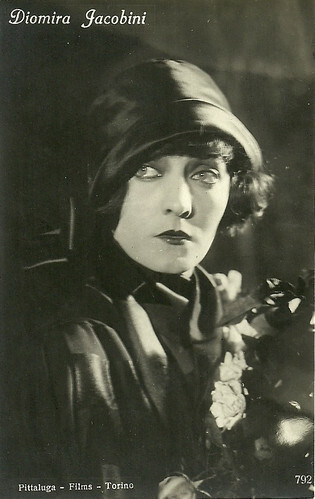
Italian postcard by Ed. A. Traldi, Milano, no. 792. Photo: Pitaluga-Films, Torino (Turin).
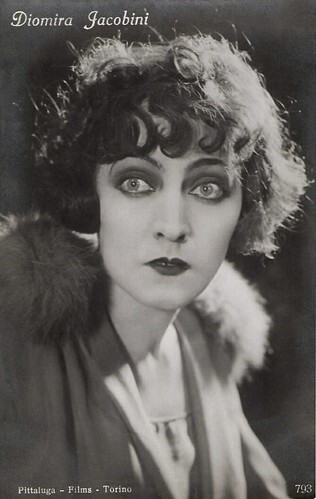
Italian postcard by Ed. A. Traldi, Milano, no. 793. Photo: Pittaluga-Films, Torino (Turin).
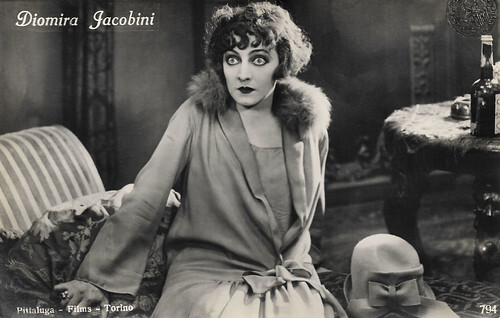
Italian postcard by Ed. A. Traldi, Milano, no. 794. Photo: Pittaluga-Films, Torino. Perhaps this card refers to Der Trödler von Amsterdam/The Dealer from Amsterdam (Victor Janson, 1925). The plot deals with a poor old dealer, Arent van Bergh (Werner Krauss), whose only friend is Oliver, a young philosopher (Alf Blütecher). The dealer's daughter Annette (Diomira Jacobini) wants to escape the black hole she lives in and is easily won over by a friend to explore the sinful places of the city, where she becomes infatuated with a wild criminal (Anton Pointner). With Oliver's help, the dealer will unmask the criminal as a ruthless murderer, which will open Annette's eyes.
A scandal in the noble family
Diomira Jacobini was born in Rome, Italy in 1896. She was the niece of a Vatican-based cardinal. When her older sister, Maria Jacobini , chose to work as an actress in the young film industry, it caused a scandal in the noble family.
The young Diomira decided to follow in her sister’s footsteps. She started to work for the prestigious Cines film studio in Rome. There she first appeared in such short films as Anna Maria/For Her Father's Sake (1912) with Ida Carloni Talli . Her name was included in the title when she appeared in the short comedy Le birichinate di Kri Kri e Diomira/Bloomer and Diomira at Play (1913) featuring Raymond Dandy, whose comic character Kri Kri was very popular at the time. According to Wikipedia , Jacobini had her first starring role in Il piccolo mozzo/The small hub (Carmine Gallone, 1915).
In the same year, she participated next to Lyda Borelli in Marcia nuziale/Wedding March (Carmine Gallone, 1915) in which she had one of her finest and prettiest parts. For the Celio film company, she co-starred with her sister Maria and another diva, Leda Gys in Ananka/Fate (1915), directed by Maria’s fiancé Nino Oxilia.
In 1916, she moved on to Tiber Film. For the Tiber studio, Jacobini made many films. Under the direction of Emilio Ghione , she made La rosa di granata/The Rose of Granada (Emilio Ghione, 1916) with Ida Carloni Talli and Lina Cavalieri .
Other films were Tormento gentile/Kind Torment (Emilio Ghione, 1916) with Alda Borelli , and Il figlio dell'amore/The Love Child (Emilio Ghione, 1916). A success was Demonietto/Imp (Gennaro Righelli, 1917). The male lead of this film was played by Alberto Collo , who would also be her co-star in several other films.
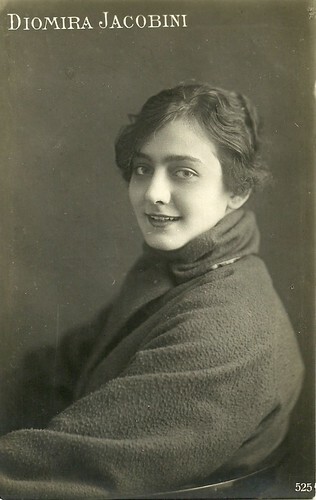
Italian postcard by Ed. A. Traldi, Milano, no. 525.
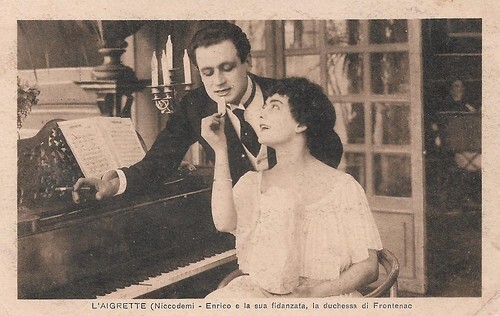
Italian postcard by IPA CT Duplex, no. 5111. Photo: Tiber Film. Tullio Carminati and Diomira Jacobini in L'aigrette/The Egret (Baldassarre Negroni, 1917), based on the play by Dario Niccodemi. Caption: Enrico and his fiancee, the duchess of Frontenac.
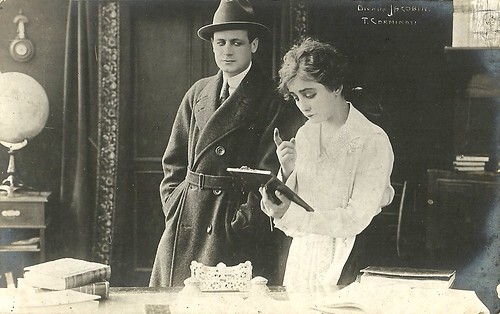
Italian postcard. Around 1917-1918, after they acted together in L'aigrette (1917), Diomira Jacobini and Tullio Carminati acted together a few times at Tiber Film, but with Jacobini always in supporting parts, e.g. in La via della luce (1917) with Hesperia , and La via più lunga (1918) starring Maria Jacobini .
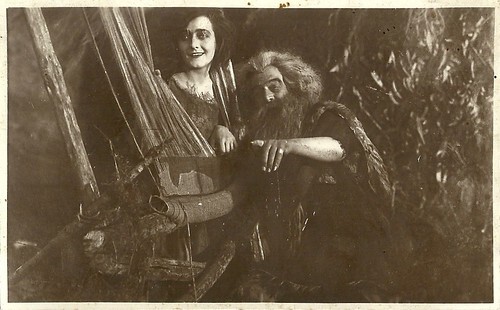
Italian postcard. Photo: Fert Film. Diomira Jacobini and Alfonso Cassini in L'isola della felicità/The island of happiness (Luciano Doria, 1921). Caption: The happiness of a simple life.
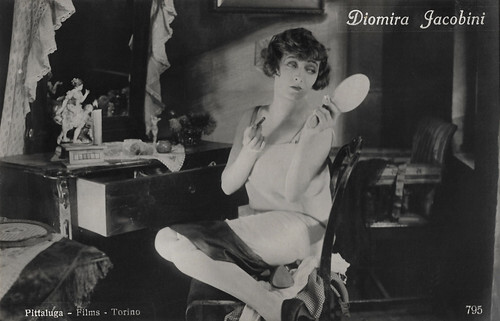
Italian postcard by Ed. Traldi, Milano, no. 795. Photo: Pittaluga Films, Torino.
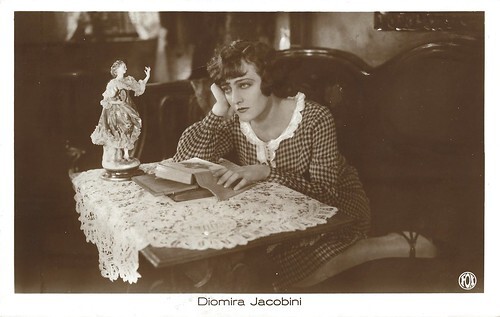
Vintage postcard. Photo: Fox / Deutsche Vereins-Film AG (Defa-Deutsche Fox). Diomira Jacobini in the German Fox production Der Trödler von Amsterdam/The Dealer from Amsterdam (Victor Janson, 1925).
A deep crisis
After finishing her engagement at Tiber Film, Diomira Jacobini signed a contract with Fert Film. The 1920s were less satisfactory for the actress, although she could show her talents successfully in films like La rosa di Fortunio/The Rose of Fortunio (Luciano Doria, 1922), Jolly, clown da circo/Jolly, circus clown (Mario Camerini, 1923) and La casa dei pulcini/The House of Pulcini (Mario Camerini, 1924) with Amleto Novelli .
She also starred opposite the popular ‘forzuto’ (strongman) Bartolomeo Pagano in the action film Maciste e il nipote d'America/Maciste and the nephew from America (Eleuterio Rodolfi, 1924).
At that time, the Italian film industry was in a deep crisis and only a few films were produced. Some of the best film actors and directors went to work abroad. Maria Jacobini was already working in Germany. There, Diomira co-starred with Werner Krauss in Der Trödler von Amsterdam/The junk dealer of Amsterdam (Victor Janson, 1925) and in some other films.
In Germany, she also appeared in Revolutionshochzeit/The Last Night (A.W. Sandberg, 1927) opposite Gösta Ekman . In the 1930s, she returned to Italy and worked again at Cines, where she acted in Il buon ragazzo/The good boy (Mario Camerini, 1930).
She made only two sound films: L'ultima avventura/The Last Adventure (Mario Camerini, 1932) starring Armando Falconi , and Cento di questi giorni/Hundred of these days (Augusto and Mario Camerini, 1933). Then she retired to private life with her husband L. Ghezzi. However, she participated in Quando eravamo muti/When we were silent (Riccardo Cassano, 1935).Diomira Jacobini died in 1959 in Rome.
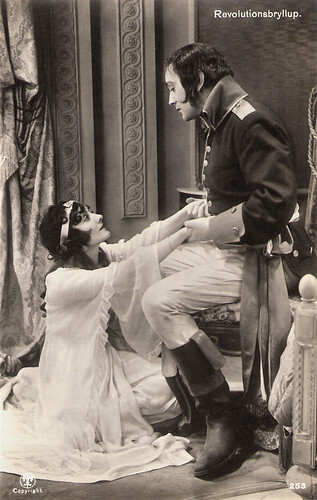
Danish postcard by Alex. Vincent's Kunstforlag, Eneret, no. 253. Photo: Gösta Ekman and Diomira Jacobini in Revolutionshochzeit/The Last Night (A.W. Sandberg, 1927).

Danish postcard by Alex. Vincent's Kunstforlag, Eneret, no. 254. Photo: publicity still for Revolutionshochzeit/The Last Night (A.W. Sandberg, 1927). This was a German dramatisation of Sophus Michaëlis' play 'Revolutionshochzeit' (Revolutionary Wedding), with ; Gösta Ekman , Karina Bell , Walter Rilla and Fritz Kortner , and produced by Terra-Filmkunst.
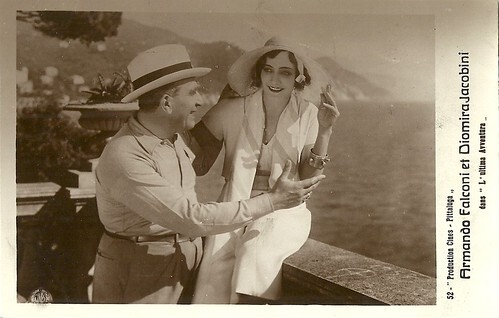
Italian postcard, even if with French written captions, no. 52. Photo: Prod. Cines - Pittaluga. Diomira Jacobini and Armando Falconi in L'ultima avventura/The last adventure (Mario Camerini, 1932).
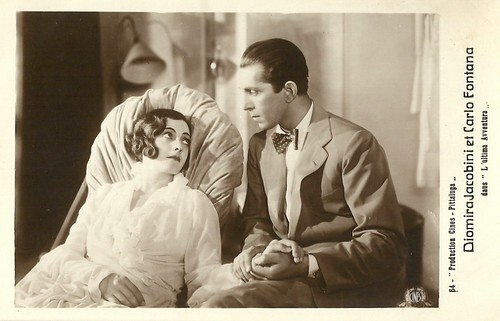
Italian postcard, even if with French written captions, no. 64. Photo: Prod. Cines - Pittaluga. Diomira Jacobini and Carlo Fontana in L'ultima avventura/The last adventure (Mario Camerini, 1932).
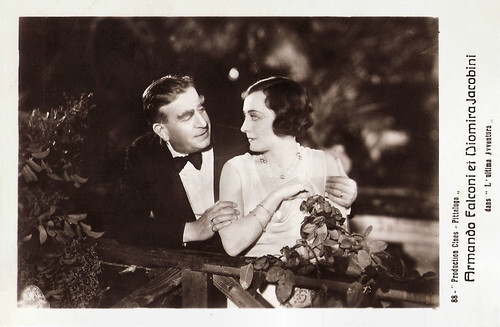
Italian postcard by Stab. Fotografico G.B. Falci, Milano, no. 88. Photo: Production Cines Pittaluga. Armando Falconi and Diomira Jacobini in L'ultima avventura/The last adventure (Mario Camerini, 1932).
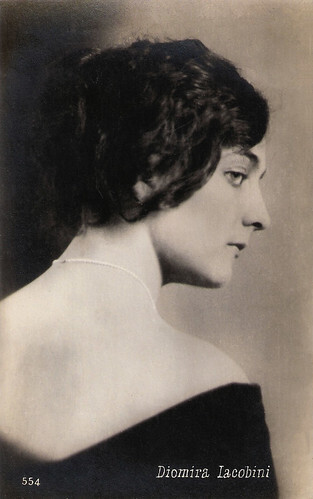
Italian postcard by Ed. Ballerini & Fratini, Firenze, no. 554.
Sources: Treccani.it (Italian), Wikipedia (Italian), and .

German postcard by Ross Verlag, no. 3748/1, 1928-1929. Source: Terra-Film. Diomira Jacobini in Revolutionshochzeit//The Last Night (A.W. Sandberg, 1928).

Italian postcard, no. 248. Photo: Bettini, Roma.

Italian postcard. Photo: Fert Film. Diomira Jacobini in L'isola della felicità/The Island of Happiness (Luciano Doria, 1921). Caption: Towards new happiness.

Italian postcard by Ed. A. Traldi, Milano, no. 792. Photo: Pitaluga-Films, Torino (Turin).

Italian postcard by Ed. A. Traldi, Milano, no. 793. Photo: Pittaluga-Films, Torino (Turin).

Italian postcard by Ed. A. Traldi, Milano, no. 794. Photo: Pittaluga-Films, Torino. Perhaps this card refers to Der Trödler von Amsterdam/The Dealer from Amsterdam (Victor Janson, 1925). The plot deals with a poor old dealer, Arent van Bergh (Werner Krauss), whose only friend is Oliver, a young philosopher (Alf Blütecher). The dealer's daughter Annette (Diomira Jacobini) wants to escape the black hole she lives in and is easily won over by a friend to explore the sinful places of the city, where she becomes infatuated with a wild criminal (Anton Pointner). With Oliver's help, the dealer will unmask the criminal as a ruthless murderer, which will open Annette's eyes.
A scandal in the noble family
Diomira Jacobini was born in Rome, Italy in 1896. She was the niece of a Vatican-based cardinal. When her older sister, Maria Jacobini , chose to work as an actress in the young film industry, it caused a scandal in the noble family.
The young Diomira decided to follow in her sister’s footsteps. She started to work for the prestigious Cines film studio in Rome. There she first appeared in such short films as Anna Maria/For Her Father's Sake (1912) with Ida Carloni Talli . Her name was included in the title when she appeared in the short comedy Le birichinate di Kri Kri e Diomira/Bloomer and Diomira at Play (1913) featuring Raymond Dandy, whose comic character Kri Kri was very popular at the time. According to Wikipedia , Jacobini had her first starring role in Il piccolo mozzo/The small hub (Carmine Gallone, 1915).
In the same year, she participated next to Lyda Borelli in Marcia nuziale/Wedding March (Carmine Gallone, 1915) in which she had one of her finest and prettiest parts. For the Celio film company, she co-starred with her sister Maria and another diva, Leda Gys in Ananka/Fate (1915), directed by Maria’s fiancé Nino Oxilia.
In 1916, she moved on to Tiber Film. For the Tiber studio, Jacobini made many films. Under the direction of Emilio Ghione , she made La rosa di granata/The Rose of Granada (Emilio Ghione, 1916) with Ida Carloni Talli and Lina Cavalieri .
Other films were Tormento gentile/Kind Torment (Emilio Ghione, 1916) with Alda Borelli , and Il figlio dell'amore/The Love Child (Emilio Ghione, 1916). A success was Demonietto/Imp (Gennaro Righelli, 1917). The male lead of this film was played by Alberto Collo , who would also be her co-star in several other films.

Italian postcard by Ed. A. Traldi, Milano, no. 525.

Italian postcard by IPA CT Duplex, no. 5111. Photo: Tiber Film. Tullio Carminati and Diomira Jacobini in L'aigrette/The Egret (Baldassarre Negroni, 1917), based on the play by Dario Niccodemi. Caption: Enrico and his fiancee, the duchess of Frontenac.

Italian postcard. Around 1917-1918, after they acted together in L'aigrette (1917), Diomira Jacobini and Tullio Carminati acted together a few times at Tiber Film, but with Jacobini always in supporting parts, e.g. in La via della luce (1917) with Hesperia , and La via più lunga (1918) starring Maria Jacobini .

Italian postcard. Photo: Fert Film. Diomira Jacobini and Alfonso Cassini in L'isola della felicità/The island of happiness (Luciano Doria, 1921). Caption: The happiness of a simple life.

Italian postcard by Ed. Traldi, Milano, no. 795. Photo: Pittaluga Films, Torino.

Vintage postcard. Photo: Fox / Deutsche Vereins-Film AG (Defa-Deutsche Fox). Diomira Jacobini in the German Fox production Der Trödler von Amsterdam/The Dealer from Amsterdam (Victor Janson, 1925).
A deep crisis
After finishing her engagement at Tiber Film, Diomira Jacobini signed a contract with Fert Film. The 1920s were less satisfactory for the actress, although she could show her talents successfully in films like La rosa di Fortunio/The Rose of Fortunio (Luciano Doria, 1922), Jolly, clown da circo/Jolly, circus clown (Mario Camerini, 1923) and La casa dei pulcini/The House of Pulcini (Mario Camerini, 1924) with Amleto Novelli .
She also starred opposite the popular ‘forzuto’ (strongman) Bartolomeo Pagano in the action film Maciste e il nipote d'America/Maciste and the nephew from America (Eleuterio Rodolfi, 1924).
At that time, the Italian film industry was in a deep crisis and only a few films were produced. Some of the best film actors and directors went to work abroad. Maria Jacobini was already working in Germany. There, Diomira co-starred with Werner Krauss in Der Trödler von Amsterdam/The junk dealer of Amsterdam (Victor Janson, 1925) and in some other films.
In Germany, she also appeared in Revolutionshochzeit/The Last Night (A.W. Sandberg, 1927) opposite Gösta Ekman . In the 1930s, she returned to Italy and worked again at Cines, where she acted in Il buon ragazzo/The good boy (Mario Camerini, 1930).
She made only two sound films: L'ultima avventura/The Last Adventure (Mario Camerini, 1932) starring Armando Falconi , and Cento di questi giorni/Hundred of these days (Augusto and Mario Camerini, 1933). Then she retired to private life with her husband L. Ghezzi. However, she participated in Quando eravamo muti/When we were silent (Riccardo Cassano, 1935).Diomira Jacobini died in 1959 in Rome.

Danish postcard by Alex. Vincent's Kunstforlag, Eneret, no. 253. Photo: Gösta Ekman and Diomira Jacobini in Revolutionshochzeit/The Last Night (A.W. Sandberg, 1927).

Danish postcard by Alex. Vincent's Kunstforlag, Eneret, no. 254. Photo: publicity still for Revolutionshochzeit/The Last Night (A.W. Sandberg, 1927). This was a German dramatisation of Sophus Michaëlis' play 'Revolutionshochzeit' (Revolutionary Wedding), with ; Gösta Ekman , Karina Bell , Walter Rilla and Fritz Kortner , and produced by Terra-Filmkunst.

Italian postcard, even if with French written captions, no. 52. Photo: Prod. Cines - Pittaluga. Diomira Jacobini and Armando Falconi in L'ultima avventura/The last adventure (Mario Camerini, 1932).

Italian postcard, even if with French written captions, no. 64. Photo: Prod. Cines - Pittaluga. Diomira Jacobini and Carlo Fontana in L'ultima avventura/The last adventure (Mario Camerini, 1932).

Italian postcard by Stab. Fotografico G.B. Falci, Milano, no. 88. Photo: Production Cines Pittaluga. Armando Falconi and Diomira Jacobini in L'ultima avventura/The last adventure (Mario Camerini, 1932).

Italian postcard by Ed. Ballerini & Fratini, Firenze, no. 554.
Sources: Treccani.it (Italian), Wikipedia (Italian), and .
Published on October 02, 2023 22:00
October 1, 2023
Wolf Albach-Retty
Austrian-German actor Wolf Albach-Retty (1906-1967) is nowadays best known as the father of Romy Schneider, but during the 1930s he was a popular leading man of the German cinema, full of charm, presence and wit. After the war, his theatre career was more satisfactory, notably his acclaimed performances in plays by Arthur Schnitzler.
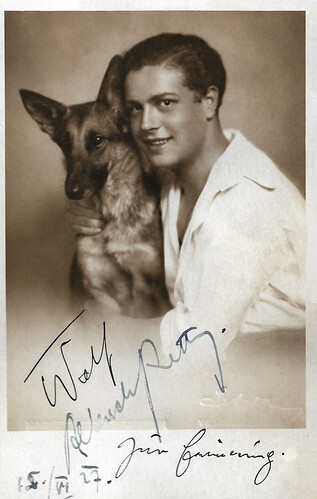
Austrian autograph card, signed in 1927. Photo: Franz Xaver Setzer, Wien.
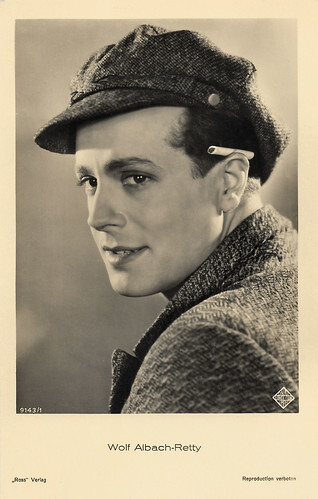
German postcard by Ross Verlag, no. 9143/2, 1935-1936. Photo: Ondra-Lamac-Film GmbH. Wolf Albach-Retty in Großreinemachen/General Housecleaning (Karel Lamac, 1935).
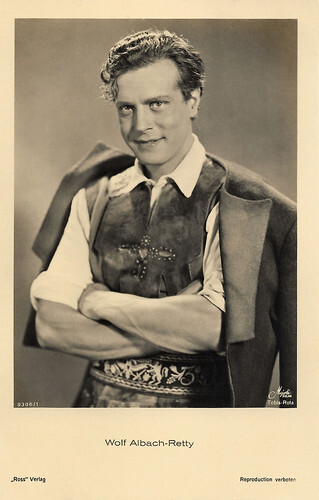
German postcard by Ross Verlag, no. 9306/1, 1935-1936. Photo: Majestic-Film / Tobis - Rota. Wolf Albach-Retty in Der Vogelhändler/The Bird Seller (E.W. Emo, 1935).
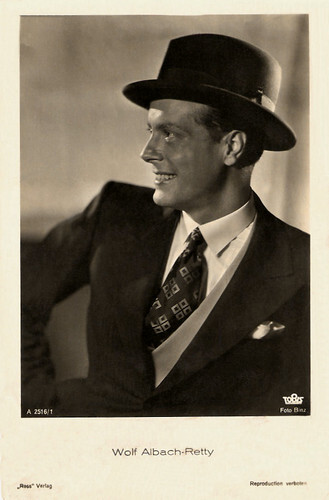
German postcard by Ross Verlag, no. A 2516/1, 1939-1940. Photo: Binz / Tobis.
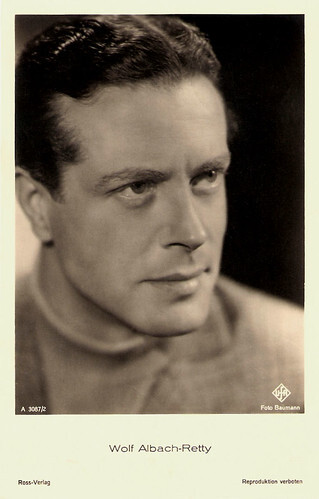
German postcard by Ross Verlag, no. A 3087/2, 1941-1944. Photo: Baumann / Ufa.
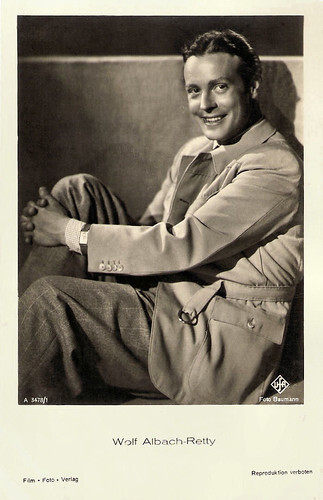
German postcard by Film-Foto-Verlag, no. A 3478/1, 1941-1944. Photo: Baumann / Ufa.
The beautiful adventure
Wolf Albach-Retty was born as Helmuth Walter Wolf Albach in Vienna, Austria-Hungary (now Austria) in 1906. He was the son of officer Karl Albach and actress Rosa Albach-Retty, a star of the Viennese stage. He studied at the Akademie für Musik und Darstellende Kunst (Academy for Music and Performing Arts) in Vienna. When he was 20 he debuted at the famous Burgtheater. He made his first film appearance in the leading role in the silent production Das Grobe Hemd/The Coarse Shirt (Fritz Kaufmann, 1927).
More leading roles followed in silent and early sound films, including Ein Wiener Musikantenmädel/A Vienna Music Girl (1928) and Zwei Herzen und ein Schlag/Two Hearts Beat as One (Wilhelm Thiele, 1932) opposite Lilian Harvey .
In 1932 the Ufa had invited him to come to Berlin. That year he was the male star of Das schöne Abenteuer/The Beautiful Adventure (1932), a romantic comedy by the great director Reinhold Schünzel . Schünzel and Emmerich Preßburger based their script on the French stage play La belle aventure by Gaston Arman de Caillavet, Robert de Flers and Etienne Rey.
Käthe von Nagy stars as the lovely Helene engaged to a corpulent man of wealth ( Otto Wallburg ). On the wedding day, she runs off with the man she really loves, her cousin André (Wolf Albach-Retty). They stay with her aged grandmother ( Adele Sandrock ) who assumes André (whom she doesn't know) to be the new husband and has prepared a bridal bed for them.
Schünzel also directed a French version with Roger Le Bon, La belle aventure (1932), starring Käthe von Nagy and Daniel Lecourtois in the role of Albach-Retty. Assistant director Kurt Hoffmann would later direct a remake, Das schöne Abenteuer (1959), with Liselotte Pulver and Robert Graf.
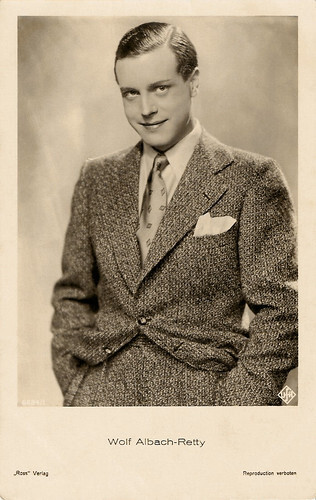
German postcard by Ross Verlag, no. 6884/1, 1931-1932. Photo: Ufa.
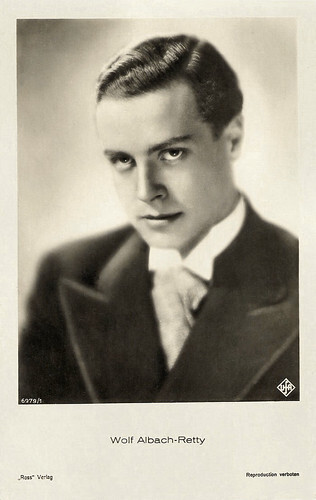
German postcard by Ross-Verlag, no. 6979/1, 1931-1932. Photo: Ufa.

German postcard by Ross Verlag, no. 142/2. Photo: Günther Pilz / Ufa. Publicity still for <1>Das schöne Abenteuer/The Beautiful Adventure1> (1932) with Käthe von Nagy .
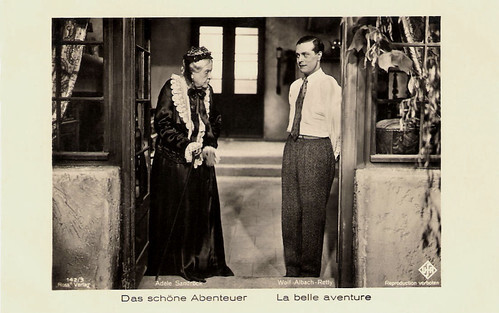
German postcard by Ross Verlag, no. 142/3. Photo: Ufa. Publicity still for Das schöne Abenteuer/Beautiful Adventure (Reinhold Schünzel, 1932) with Adele Sandrock.
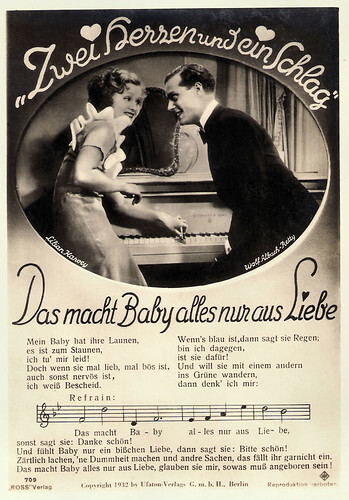
German postcard by Ross Verlag, no. 709. Photo: Ufa. Publicity still for Zwei Herzen und ein Schlag/Two Hearts Beat as One (Wilhelm Thiele, 1932). Collection: Geoffrey Donaldson Institute.
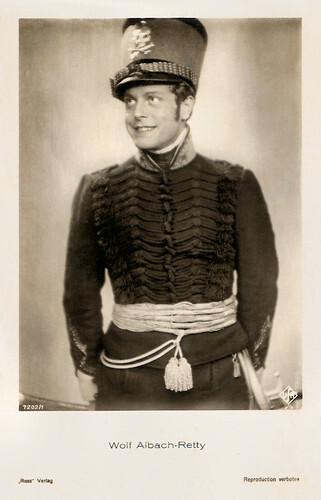
German postcard by Ross Verlag, no. 7202/1, 1932-1933. Photo: Ufa. Wolf Albach-Retty in Der schwarze Husar/The Black Hussar (Gerhard Lamprecht, 1932).
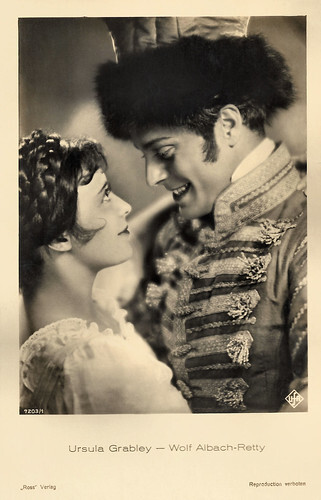
German postcard by Ross Verlag, no. 7203/1, 1932-1933. Photo: Ufa. Ursula Grabley and Wolf Albach-Retty in Der Schwarze HusarThe Black Hussar (Gerhard Lamprecht, 1932).
Romy
Despite his acting talents, Wolf Albach-Retty was mainly seen in commercial entertainment films. During the Nazi years, he mainly performed the romantic lead in superficial musicals and mediocre comedies which pleased the crowds but did not make film history.
Among his most popular films were Liebe muß verstanden sein/Love Must Be Understood (Hans Steinhoff, 1933), the operetta Der Vogelhändler/The Bird Seller (E.W. Emo, 1935) and the comedy Sieben Jahre Pech/Seven Years of Bad Luck (Ernst Marischka, 1940) starring Hans Moser .
In 1940, two years after the 'Anschluss' of Austria to Nazi Germany, Albach-Retty became a party member of the NSDAP.
In 1936 he married the German actress Magda Schneider . The so-called 'dream pair' co-starred in seven films including G'schichten aus dem Wienerwald/Tales from Vienna Woods (Georg Jacoby, 1934) and Winternachtstraum/Winter Night's Dream (Géza von Bolváry, 1935).
Temporarily Albach-Retty became a German citizen during his marriage. He and Schneider divorced in 1946 (some sources say 1945 or 1949). They had two children: Wolf-Dieter (1941) and Rosemarie, who would later become famous as Romy Schneider (1938-1982).
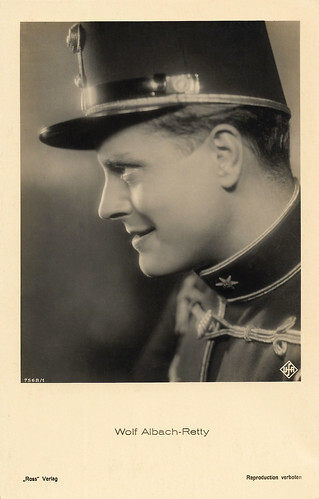
German postcard by Ross Verlag, no. 7568/1, 1932-1933. Photo: Ufa. Wolf Albach-Retty in ...und es leuchtet die Pußta/And the Plains Are Gleaming (Heinz Hille, 1933).
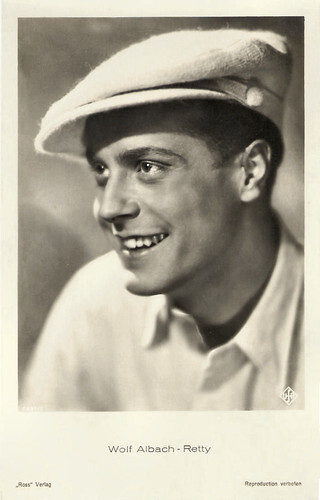
German postcard by Ross Verlag, no. 7851/2, 1932-1933. Photo: Ufa.
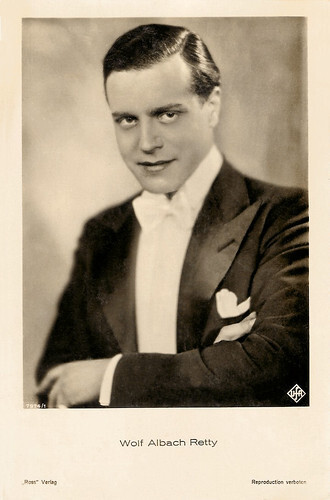
German postcard by Ross Verlag, no. 7974/1, 1932-1933. Photo: Ufa. Wolf Albach Retty in Liebe muß verstanden sein/Love Must Be Understood (Hans Steinhoff, 1933).
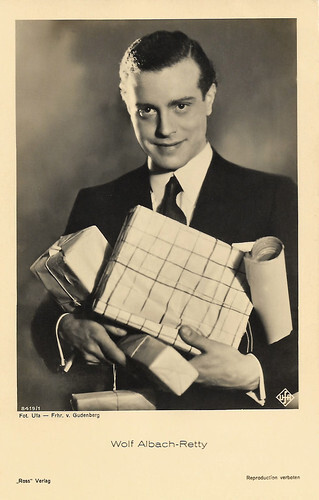
German postcard by Ross Verlag, no. 8419/1, 1933-1934. Photo: Ufa / Frhr. von Gudenberg.
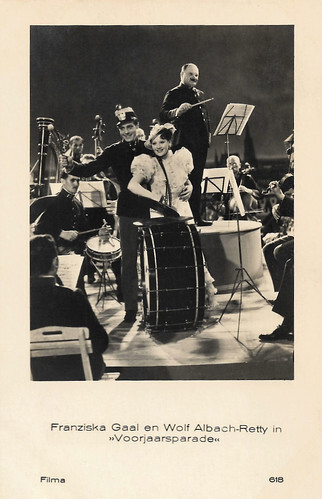
Dutch postcard, no. 618. Photo: Filma. Franziska Gaal and Wolf Albach-Retty in Frühjahrsparade/Spring Parade (Géza von Bolváry, 1934).
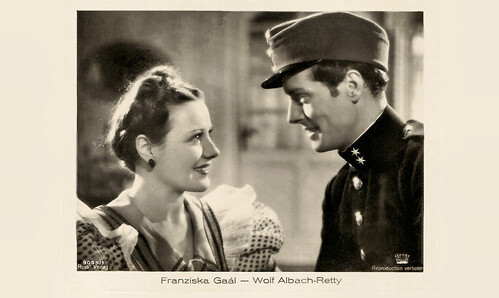
German postcard by Ross Verlag, no. 9055/1, 1934-1935. The photo is a still from Frühjahrsparade (Géza von Bolváry, 1934), also starring Franciska Gaál . The photo was cut out of the card by a former owner. Exception-wise, we've photoshopped new edges.
Back to the Burgtheater
After the war, Wolf Albach-Retty played with his cultivated charm the same kind of romantic roles as before in films like Der Mann, der sich selber sucht/The Man Who Searches For Himself (Géza von Cziffra, 1950) with Vera Molnar , Weh dem, der liebt!/Woe to Him Who Loves (Sándor Szlatinay, 1951) and a remake of Der Vogelhändler/The Bird Seller (Arthur Maria Rabenalt, 1953) opposite Ilse Werner .
But the times had changed. In the late 1950s, his film career started to sour as his past successes were no longer remembered.
His parts became smaller and the films rarer, but he returned successfully to the stage of the Burgtheater in 1959. Till his death, he starred in plays like 'Anatol' by Arthur Schnitzler, which was also adapted for television in 1962 by Otto Schenk.
His last stage role was in 'Professor Bernhardi' by Arthur Schnitzler. His final TV-film was Die Tänzerin Fanny Elßler/Fanny Elßler, the Dancer (Arthur Maria Rabenalt, 1966).
Wolfgang Albach-Retty died in 1967 in his hometown Vienna. He was survived by his second wife, actress Trude Marlen.
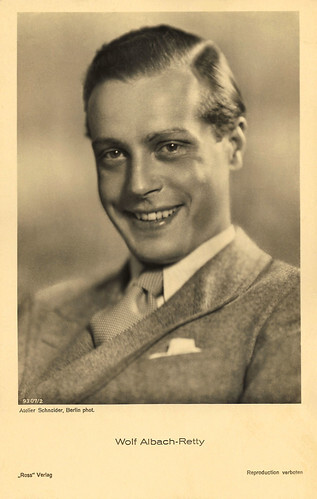
German postcard by Ross Verlag, no. 9307/2, 1935-1936. Photo: Atelier Schneider, Berlin.
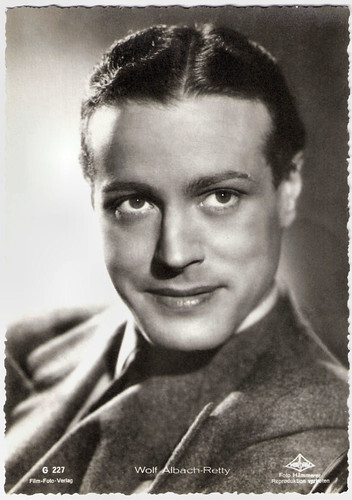
German postcard by Film-Foto-Verlag, no. G 227, 1941-1944. Photo: Hämmerer / Wien Film.
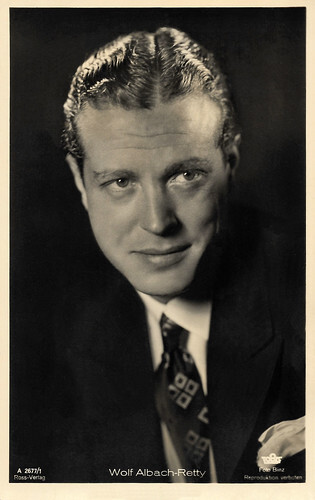
German postcard by Ross Verlag, no. A 2677/1, 1939-1940. Photo: Binz / Tobis.
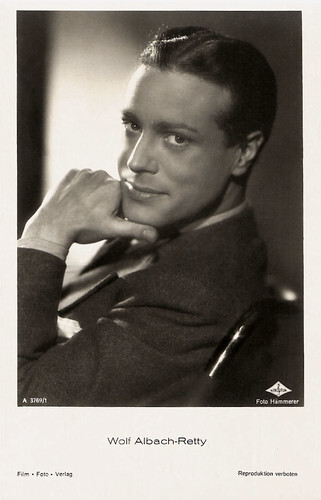
German postcard by Film-Foto-Verlag, no. A 3769/1, 1941-1944. Photo: Hämmerer / Wien film.
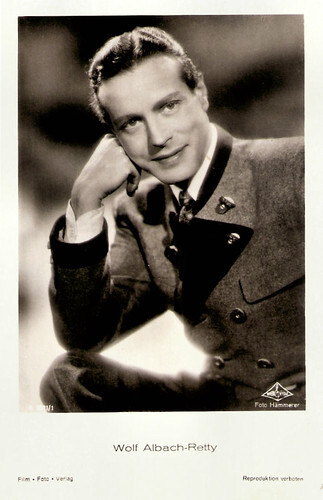
German postcard by Film-Foto-Verlag, no. A 3821/1, 1941-1944. Photo: Hämmerer / Wien Film. From Tatiana.
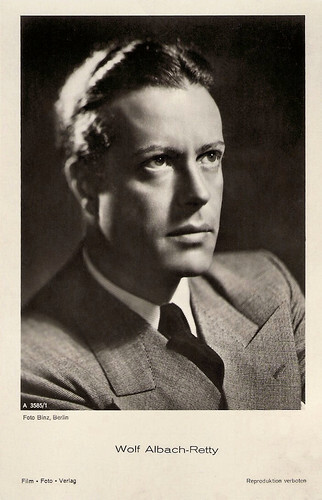
German postcard by Film-Foto-Verlag, no. A 3585/1, 1941-1944. Photo: Binz, Berlin.
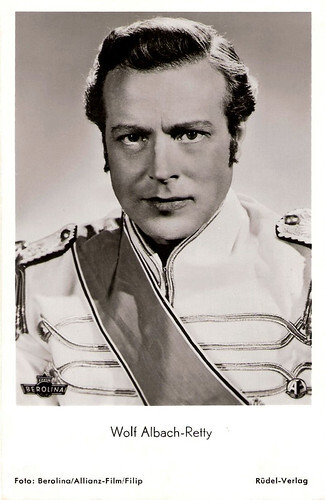
German postcard by Rüdel Verlag. Photo: Berolina / Allianz-Film / Filip.
Sources: Stephanie D'heil (Steffi-line) (German), Thomas Staedeli (Cyranos), (IMDb), AllMovie, and Wikipedia (German).

Austrian autograph card, signed in 1927. Photo: Franz Xaver Setzer, Wien.

German postcard by Ross Verlag, no. 9143/2, 1935-1936. Photo: Ondra-Lamac-Film GmbH. Wolf Albach-Retty in Großreinemachen/General Housecleaning (Karel Lamac, 1935).

German postcard by Ross Verlag, no. 9306/1, 1935-1936. Photo: Majestic-Film / Tobis - Rota. Wolf Albach-Retty in Der Vogelhändler/The Bird Seller (E.W. Emo, 1935).

German postcard by Ross Verlag, no. A 2516/1, 1939-1940. Photo: Binz / Tobis.

German postcard by Ross Verlag, no. A 3087/2, 1941-1944. Photo: Baumann / Ufa.

German postcard by Film-Foto-Verlag, no. A 3478/1, 1941-1944. Photo: Baumann / Ufa.
The beautiful adventure
Wolf Albach-Retty was born as Helmuth Walter Wolf Albach in Vienna, Austria-Hungary (now Austria) in 1906. He was the son of officer Karl Albach and actress Rosa Albach-Retty, a star of the Viennese stage. He studied at the Akademie für Musik und Darstellende Kunst (Academy for Music and Performing Arts) in Vienna. When he was 20 he debuted at the famous Burgtheater. He made his first film appearance in the leading role in the silent production Das Grobe Hemd/The Coarse Shirt (Fritz Kaufmann, 1927).
More leading roles followed in silent and early sound films, including Ein Wiener Musikantenmädel/A Vienna Music Girl (1928) and Zwei Herzen und ein Schlag/Two Hearts Beat as One (Wilhelm Thiele, 1932) opposite Lilian Harvey .
In 1932 the Ufa had invited him to come to Berlin. That year he was the male star of Das schöne Abenteuer/The Beautiful Adventure (1932), a romantic comedy by the great director Reinhold Schünzel . Schünzel and Emmerich Preßburger based their script on the French stage play La belle aventure by Gaston Arman de Caillavet, Robert de Flers and Etienne Rey.
Käthe von Nagy stars as the lovely Helene engaged to a corpulent man of wealth ( Otto Wallburg ). On the wedding day, she runs off with the man she really loves, her cousin André (Wolf Albach-Retty). They stay with her aged grandmother ( Adele Sandrock ) who assumes André (whom she doesn't know) to be the new husband and has prepared a bridal bed for them.
Schünzel also directed a French version with Roger Le Bon, La belle aventure (1932), starring Käthe von Nagy and Daniel Lecourtois in the role of Albach-Retty. Assistant director Kurt Hoffmann would later direct a remake, Das schöne Abenteuer (1959), with Liselotte Pulver and Robert Graf.

German postcard by Ross Verlag, no. 6884/1, 1931-1932. Photo: Ufa.

German postcard by Ross-Verlag, no. 6979/1, 1931-1932. Photo: Ufa.

German postcard by Ross Verlag, no. 142/2. Photo: Günther Pilz / Ufa. Publicity still for <1>Das schöne Abenteuer/The Beautiful Adventure1> (1932) with Käthe von Nagy .

German postcard by Ross Verlag, no. 142/3. Photo: Ufa. Publicity still for Das schöne Abenteuer/Beautiful Adventure (Reinhold Schünzel, 1932) with Adele Sandrock.

German postcard by Ross Verlag, no. 709. Photo: Ufa. Publicity still for Zwei Herzen und ein Schlag/Two Hearts Beat as One (Wilhelm Thiele, 1932). Collection: Geoffrey Donaldson Institute.

German postcard by Ross Verlag, no. 7202/1, 1932-1933. Photo: Ufa. Wolf Albach-Retty in Der schwarze Husar/The Black Hussar (Gerhard Lamprecht, 1932).

German postcard by Ross Verlag, no. 7203/1, 1932-1933. Photo: Ufa. Ursula Grabley and Wolf Albach-Retty in Der Schwarze HusarThe Black Hussar (Gerhard Lamprecht, 1932).
Romy
Despite his acting talents, Wolf Albach-Retty was mainly seen in commercial entertainment films. During the Nazi years, he mainly performed the romantic lead in superficial musicals and mediocre comedies which pleased the crowds but did not make film history.
Among his most popular films were Liebe muß verstanden sein/Love Must Be Understood (Hans Steinhoff, 1933), the operetta Der Vogelhändler/The Bird Seller (E.W. Emo, 1935) and the comedy Sieben Jahre Pech/Seven Years of Bad Luck (Ernst Marischka, 1940) starring Hans Moser .
In 1940, two years after the 'Anschluss' of Austria to Nazi Germany, Albach-Retty became a party member of the NSDAP.
In 1936 he married the German actress Magda Schneider . The so-called 'dream pair' co-starred in seven films including G'schichten aus dem Wienerwald/Tales from Vienna Woods (Georg Jacoby, 1934) and Winternachtstraum/Winter Night's Dream (Géza von Bolváry, 1935).
Temporarily Albach-Retty became a German citizen during his marriage. He and Schneider divorced in 1946 (some sources say 1945 or 1949). They had two children: Wolf-Dieter (1941) and Rosemarie, who would later become famous as Romy Schneider (1938-1982).

German postcard by Ross Verlag, no. 7568/1, 1932-1933. Photo: Ufa. Wolf Albach-Retty in ...und es leuchtet die Pußta/And the Plains Are Gleaming (Heinz Hille, 1933).

German postcard by Ross Verlag, no. 7851/2, 1932-1933. Photo: Ufa.

German postcard by Ross Verlag, no. 7974/1, 1932-1933. Photo: Ufa. Wolf Albach Retty in Liebe muß verstanden sein/Love Must Be Understood (Hans Steinhoff, 1933).

German postcard by Ross Verlag, no. 8419/1, 1933-1934. Photo: Ufa / Frhr. von Gudenberg.

Dutch postcard, no. 618. Photo: Filma. Franziska Gaal and Wolf Albach-Retty in Frühjahrsparade/Spring Parade (Géza von Bolváry, 1934).

German postcard by Ross Verlag, no. 9055/1, 1934-1935. The photo is a still from Frühjahrsparade (Géza von Bolváry, 1934), also starring Franciska Gaál . The photo was cut out of the card by a former owner. Exception-wise, we've photoshopped new edges.
Back to the Burgtheater
After the war, Wolf Albach-Retty played with his cultivated charm the same kind of romantic roles as before in films like Der Mann, der sich selber sucht/The Man Who Searches For Himself (Géza von Cziffra, 1950) with Vera Molnar , Weh dem, der liebt!/Woe to Him Who Loves (Sándor Szlatinay, 1951) and a remake of Der Vogelhändler/The Bird Seller (Arthur Maria Rabenalt, 1953) opposite Ilse Werner .
But the times had changed. In the late 1950s, his film career started to sour as his past successes were no longer remembered.
His parts became smaller and the films rarer, but he returned successfully to the stage of the Burgtheater in 1959. Till his death, he starred in plays like 'Anatol' by Arthur Schnitzler, which was also adapted for television in 1962 by Otto Schenk.
His last stage role was in 'Professor Bernhardi' by Arthur Schnitzler. His final TV-film was Die Tänzerin Fanny Elßler/Fanny Elßler, the Dancer (Arthur Maria Rabenalt, 1966).
Wolfgang Albach-Retty died in 1967 in his hometown Vienna. He was survived by his second wife, actress Trude Marlen.

German postcard by Ross Verlag, no. 9307/2, 1935-1936. Photo: Atelier Schneider, Berlin.

German postcard by Film-Foto-Verlag, no. G 227, 1941-1944. Photo: Hämmerer / Wien Film.

German postcard by Ross Verlag, no. A 2677/1, 1939-1940. Photo: Binz / Tobis.

German postcard by Film-Foto-Verlag, no. A 3769/1, 1941-1944. Photo: Hämmerer / Wien film.

German postcard by Film-Foto-Verlag, no. A 3821/1, 1941-1944. Photo: Hämmerer / Wien Film. From Tatiana.

German postcard by Film-Foto-Verlag, no. A 3585/1, 1941-1944. Photo: Binz, Berlin.

German postcard by Rüdel Verlag. Photo: Berolina / Allianz-Film / Filip.
Sources: Stephanie D'heil (Steffi-line) (German), Thomas Staedeli (Cyranos), (IMDb), AllMovie, and Wikipedia (German).
Published on October 01, 2023 22:00
Vitali Konyaev (1937-2023)
Russian actor Vitali Konyayev(1937) passed away on 30 September 2023. He was honoured as a people’s artist of Russia. Next to his theatre work, he appeared in a dozen films and he also worked as a director and acting teacher. Konyayev, who died of natural causes, was 86.
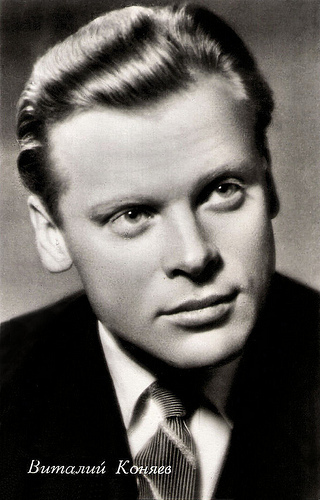
Russian postcard by Izdanije Byuro Propogandy Sovietskogo Kinoiskusstva, no. M 74663, 1962.

Russian postcard by Izdanije Byuro Propogandy Sovietskogo Kinoiskusstva, no. A 03168, 1965. Photo: B. Vilenkin, G. Ter-Ovanesov. This postcard was printed in an edition of 200,000 cards. The price was 8 kop.
Silence
Vitali A. Konyaev or Vitaliy Anatolyevich Konyayev (in Russian written as Виталий Коняев and in French as Vitali Koniaev) was born in Kronstadt in the former Soviet Union, now St. Petersburg, Russia, in 1937. From 1954 to 1958, he studied acting with L. Volkova at the M. S. Schepkin Higher Theatre School and from 1958 he worked for the State Academic Maly Theater.
In 1958 he also made his film debut with a small part in Stuchis' v lyubuyu dver'/Knock On Any Door (Mariya Fyodorova, 1958). More roles soon followed in films like Nasch Korrespondent/Our Correspondent (Anatoli Granik, 1958) and the lead role in Pesnya o Koltsove/A Song about Koltsov (Vladimir Gerasimov II, 1959), about the life of Russian poet Alexey Koltsov.
Konyaev played a supporting part in Chistoe nebo/Clear Skies (Grigori Chukhrai, 1961), a drama starring Yevgeny Urbansky . It is the story of a Soviet test pilot taken prisoner by the Nazis during World War II only to find himself expelled from the Communist Party on his release. Fired from his job, and deprived of all decorations, he becomes a drunk. His only solace lies in the love of his wife, as she challenges him to right the wrongs done to him.
This film was possible only after Joseph Stalin's death when his successor Nikita Khrushchev in 1956 denounced the 'cult of personality' and all of Stalin's purges. Still, Chukhrai had a hard and very delicate task on his hands because he had to portray the issue while still following the propaganda guidelines and affirming the righteousness of the whole communist system so that the film would actually pass the censors. He told the story through the eyes of the young wife of the pilot, played by Nina Drobysheva. Konyayev would later marry Drobysheva. Next, Vitali Konyaev played one of the leading roles in Tishina/Silence (Vladimir Basov, 1963) based on the novel by Yuri Bondareva. In this film, a young World War II hero's moral and political resolve is tested when he and his father are drummed out of the Communist Party.
At AllMovie , Dan Pavlides writes: "Sergei (Vitali Konyayev) resents his father for taking a lover, but his morals do not stop his own affair with a woman separated from her husband. After the war, Sergei enters the institute hoping to further his education, but he too is kicked out of the Party and the institute for the sins of his father. Vladimir Basov, a famous character actor in his own right, directed the film that was seen by over 50 million people in the USSR alone. This is one of the last films that fell under the political thaw period under Khruschev and openly depicted Stalinist oppression." The film won the Grand Prize at the Vsesoyuznyy kinofestival (All-Union Film Festival) in Leningrad in 1964. That same year, Leonid Brezhnev rose to power and this sort of commentary would once again be forbidden.
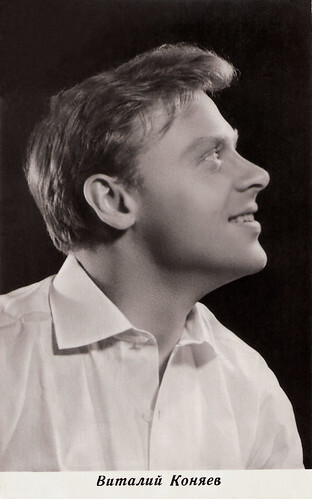
Russian postcard by Izdanije Byuro Propogandy Sovietskogo Kinoiskusstva, no. M 14943, 1965. This postcard was printed in an edition of 115-150,000 cards. The price was 8 kop.
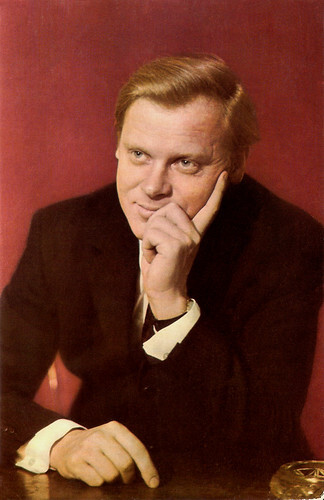
Russian postcard by Izdanije Byuro Propogandy Sovietskogo Kinoiskusstva, no. 2428, 1970. Photo: G. & T. Vajl. This postcard was printed in an edition of 200,000 cards. The price was 6 kop.
The Red and the White
Vitali Konyaev had a small part in the controversial Hungarian-Soviet co-production Csillagosok, katonák/The Red and the White (Miklós Jancsó, 1967). The film was originally commissioned to celebrate the 50th anniversary of the October Revolution in Russia in which the Bolsheviks took power.
However, director Miklós Jancsó chose to use a radically different approach to the film than was expected. As a result, the film was not well received in Russia, where it was first re-edited to put a more heroic spin on the war for its premiere and then banned. However, in Hungary and in the West it was favourably received and it had a theatrical release in many countries.
Next Konyaev played the lead in the political drama Belyy flyuger/A White Weather Vane (David Kocharyan, 1969), and also appeared in films like Gorod pod lipami/The City of Lipami (Alois Brench, 1971) and Samyy posledniy den/The Very Last Day (Mikhail Ulyanov, 1972).
From 1972 to 1982 he worked as a teacher at the M.S. Schepkin Higher Theatre School. During this period he played in the TV series Variant ‘Оmegа’/Option ‘Omega’ (Antonis Vogiazos, 1975) and the adventure film Tovarishch Innokentiy/Comrade Innocent (Yevgeni Mezentsev, Iosif Shapiro, 1981).
Later films in which he played small parts were the German-Russian coproduction Ubit drakona/To Kill a Dragon (Mark Zakharov, 1988) and the black comedy Vystrel v grobu/Shot in a Coffin (Nikolai Zaseyev, 1992). In 1998 Vitali Konyayev was given the title of People's Artist of Russia. Vitali Konyaev was married to Tatiana Konyaeva-Stanislavski. He had a daughter, actress Yelena Drobysheva (1964), and a son, Dmitry V. Konyaev (1987).
Trailer for Csillagosok, katonák/The Red and the White (1967).
Sources: Dan Pavlides (AllMovie), Kino-Teatr (Russian), Wikipedia and .

Russian postcard by Izdanije Byuro Propogandy Sovietskogo Kinoiskusstva, no. M 74663, 1962.

Russian postcard by Izdanije Byuro Propogandy Sovietskogo Kinoiskusstva, no. A 03168, 1965. Photo: B. Vilenkin, G. Ter-Ovanesov. This postcard was printed in an edition of 200,000 cards. The price was 8 kop.
Silence
Vitali A. Konyaev or Vitaliy Anatolyevich Konyayev (in Russian written as Виталий Коняев and in French as Vitali Koniaev) was born in Kronstadt in the former Soviet Union, now St. Petersburg, Russia, in 1937. From 1954 to 1958, he studied acting with L. Volkova at the M. S. Schepkin Higher Theatre School and from 1958 he worked for the State Academic Maly Theater.
In 1958 he also made his film debut with a small part in Stuchis' v lyubuyu dver'/Knock On Any Door (Mariya Fyodorova, 1958). More roles soon followed in films like Nasch Korrespondent/Our Correspondent (Anatoli Granik, 1958) and the lead role in Pesnya o Koltsove/A Song about Koltsov (Vladimir Gerasimov II, 1959), about the life of Russian poet Alexey Koltsov.
Konyaev played a supporting part in Chistoe nebo/Clear Skies (Grigori Chukhrai, 1961), a drama starring Yevgeny Urbansky . It is the story of a Soviet test pilot taken prisoner by the Nazis during World War II only to find himself expelled from the Communist Party on his release. Fired from his job, and deprived of all decorations, he becomes a drunk. His only solace lies in the love of his wife, as she challenges him to right the wrongs done to him.
This film was possible only after Joseph Stalin's death when his successor Nikita Khrushchev in 1956 denounced the 'cult of personality' and all of Stalin's purges. Still, Chukhrai had a hard and very delicate task on his hands because he had to portray the issue while still following the propaganda guidelines and affirming the righteousness of the whole communist system so that the film would actually pass the censors. He told the story through the eyes of the young wife of the pilot, played by Nina Drobysheva. Konyayev would later marry Drobysheva. Next, Vitali Konyaev played one of the leading roles in Tishina/Silence (Vladimir Basov, 1963) based on the novel by Yuri Bondareva. In this film, a young World War II hero's moral and political resolve is tested when he and his father are drummed out of the Communist Party.
At AllMovie , Dan Pavlides writes: "Sergei (Vitali Konyayev) resents his father for taking a lover, but his morals do not stop his own affair with a woman separated from her husband. After the war, Sergei enters the institute hoping to further his education, but he too is kicked out of the Party and the institute for the sins of his father. Vladimir Basov, a famous character actor in his own right, directed the film that was seen by over 50 million people in the USSR alone. This is one of the last films that fell under the political thaw period under Khruschev and openly depicted Stalinist oppression." The film won the Grand Prize at the Vsesoyuznyy kinofestival (All-Union Film Festival) in Leningrad in 1964. That same year, Leonid Brezhnev rose to power and this sort of commentary would once again be forbidden.

Russian postcard by Izdanije Byuro Propogandy Sovietskogo Kinoiskusstva, no. M 14943, 1965. This postcard was printed in an edition of 115-150,000 cards. The price was 8 kop.

Russian postcard by Izdanije Byuro Propogandy Sovietskogo Kinoiskusstva, no. 2428, 1970. Photo: G. & T. Vajl. This postcard was printed in an edition of 200,000 cards. The price was 6 kop.
The Red and the White
Vitali Konyaev had a small part in the controversial Hungarian-Soviet co-production Csillagosok, katonák/The Red and the White (Miklós Jancsó, 1967). The film was originally commissioned to celebrate the 50th anniversary of the October Revolution in Russia in which the Bolsheviks took power.
However, director Miklós Jancsó chose to use a radically different approach to the film than was expected. As a result, the film was not well received in Russia, where it was first re-edited to put a more heroic spin on the war for its premiere and then banned. However, in Hungary and in the West it was favourably received and it had a theatrical release in many countries.
Next Konyaev played the lead in the political drama Belyy flyuger/A White Weather Vane (David Kocharyan, 1969), and also appeared in films like Gorod pod lipami/The City of Lipami (Alois Brench, 1971) and Samyy posledniy den/The Very Last Day (Mikhail Ulyanov, 1972).
From 1972 to 1982 he worked as a teacher at the M.S. Schepkin Higher Theatre School. During this period he played in the TV series Variant ‘Оmegа’/Option ‘Omega’ (Antonis Vogiazos, 1975) and the adventure film Tovarishch Innokentiy/Comrade Innocent (Yevgeni Mezentsev, Iosif Shapiro, 1981).
Later films in which he played small parts were the German-Russian coproduction Ubit drakona/To Kill a Dragon (Mark Zakharov, 1988) and the black comedy Vystrel v grobu/Shot in a Coffin (Nikolai Zaseyev, 1992). In 1998 Vitali Konyayev was given the title of People's Artist of Russia. Vitali Konyaev was married to Tatiana Konyaeva-Stanislavski. He had a daughter, actress Yelena Drobysheva (1964), and a son, Dmitry V. Konyaev (1987).
Trailer for Csillagosok, katonák/The Red and the White (1967).
Sources: Dan Pavlides (AllMovie), Kino-Teatr (Russian), Wikipedia and .
Published on October 01, 2023 10:06
September 30, 2023
Barbra Streisand
Barbra Streisand (1942) began a successful recording career in the 1960s. In 1968, she made her film debut in the critically acclaimed Funny Girl, a reprise of her Broadway hit. She won both the Academy Award and Golden Globe Award for Best Actress for her role. Other notable films include What's Up, Doc? (1972), The Way We Were (1973) and A Star Is Born (1976) for which she received her second Academy Award for composing the music to the picture’s main song, 'Evergreen'. By the 1980s, Streisand established herself as one of Hollywood's most notable figures by becoming the first woman to direct, produce, script and star in her own picture, in Yentl (1983).
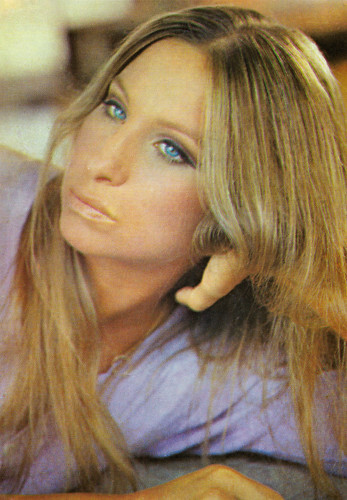
Romanian postcard by Casa Filmului Acin.
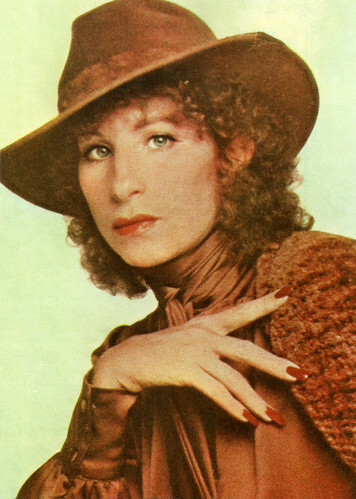
Romanian postcard by Colectia Cinefilului Acin.
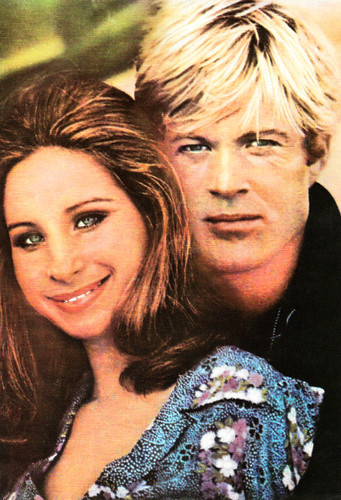
Romanian postcard by Casa Filmului Acin, no. 491. Photo: Barbra Streisand and Robert Redford in The Way We Were (Sydney Pollack, 1973).
You'll Never Know
Barbara Joan Streisand was born in the Williamsburg district of Brooklyn, New York, in 1942. Her parents, Emanuel Streisand and Dinah Rosen, were of Jewish descent. Streisand's maternal grandparents came from the Russian Empire and her paternal grandparents were from Polish Galicia. They had emigrated to the US at the turn of the century.
Streisand's parents both worked in education and met at the school where they both worked. Streisand has an older brother, Sheldon Streisand. In August 1943, a few months after her first birthday, Streisand's father died suddenly. Her mother now had to provide income on her own with a low-paid job as an accountant.
When Barbra Streisand was seven years old, her mother married Louis Kind. From this marriage came Streisand's half-sister Roslyn Kind, who also became an actress, singer and songwriter.
Streisand's mother had a beautiful voice and together they made a few tape recordings on which they sang as a duo. This was the first time she thought of a career as a singer. Streisand attended Erasmus Hall High School in Flatbush with Neil Diamond, with whom she later sang the duet 'You Don't Bring Me Flowers', and with future world chess champion Bobby Fischer.
In 1955, 13-year-old Barbra Streisand recorded two songs for a demo tape. One of the recordings was 'You'll Never Know'. Already as a teenager, Streisand performed as a nightclub singer. Because she actually wanted to become an actress, she appeared in the musical 'Driftwood' and several other Summer stock productions. She gained her first stage experience as early as 1958 when she appeared in three plays at the Clinton Theatre.
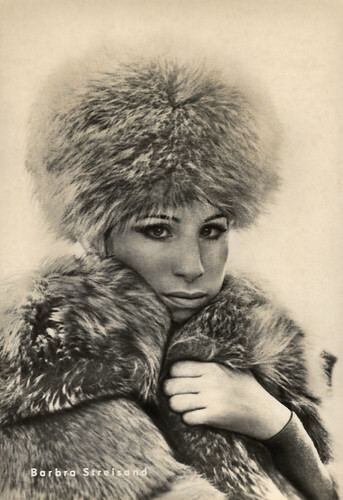
East-German postcard by VEB Progress Film-Vertrieb, Berlin, no. 186/70. Photo: Steve Schapiro / Columbia. Barbra Streisand in Funny Girl (William Wyler, 1968).
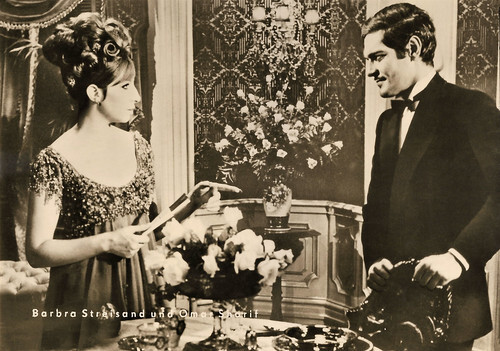
East-German postcard by VEB Progress Film-Vertrieb, Berlin, no. 209/70. Photo: Columbia. Barbra Streisand and Omar Sharif in Funny Girl (William Wyler, 1968).
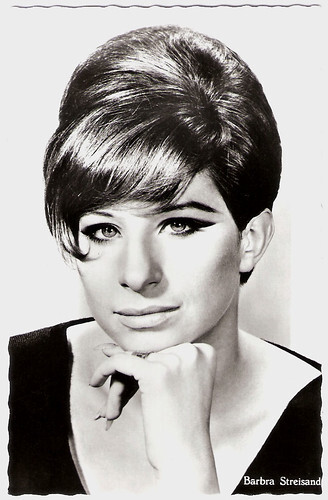
Dutch postcard. Sent by mail in 1969.
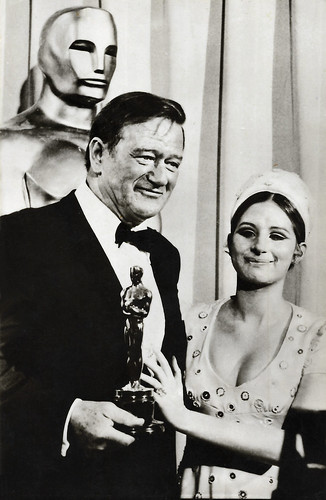
Romanian postcard by Casa Filmului Acin, no. 554, no. 7. John Wayne and Barbra Streisand during the Oscars ceremony 1970. Streisand presented the Best Actor award to Wayne on the 42nd Academy Awards show. Wayne won the Oscar for his performance in True Grit (Henry Hathaway, 1969).
Funny Girl
In 1961 Barbra Streisand made her first television appearance on The Tonight Show. She signed her first recording contract with Columbia Records in 1962. Her debut album, 'Barbra Streisand Album', won two Grammys in 1963. More television guest appearances followed, such as on The Judy Garland Show in 1963, where she sang 'Happy Days Are Here Again' and Judy Garland 's 'Get Happy'. Both songs were arranged by Garland into a duet.
She released her second album, 'The Second Barbra Streisand Album', in the autumn of 1963. From 1961 she also got engagements on Broadway. Her first role was in the musical 'I Can Get It For You Wholesale', by Harold Rome, receiving a Tony Award nomination for Best Supporting Actress and a New York Drama Critics Poll award.
Another smash Broadway hit followed in 1964 as legendary Broadway star Fanny Brice in the musical 'Funny Girl' by Jule Styne and Bob Merrill. Streisand's first no 1 song was 'People', the main song of 'Funny Girl', which reached the top-hit position in 1964. She signed an exclusive contract with CBS for a series of annual TV specials. My Name Is Barbra (1965), which won an Emmy, and Color Me Barbra (1966) were extremely successful.
In the cinema, she had her breakthrough with the leading role in the film adaptation Funny Girl (William Wylker, 1968). Streisand received an Oscar for her role as Fanny Brice at the Academy Awards in 1968. After a series of screen musicals, such as Gene Kelly 's Hello, Dolly! (1969) and Vincente Minnelli's On a Clear Day You Can See Forever (1970), she wanted to try comedies, resulting in such films as The Owl and the Pussycat (Herbert Ross, 1970). She celebrated another significant success alongside Ryan O'Neal in the leading female role in the Screwball Comedy What's Up, Doc? (Peter Bogdanovich, 1972).
In 1972 she also founded the production company Barwoods Films, with which she produced her own films. She turned to dramas and turned out Up the Sandbox (Irvin Kershner, 1972) and the classic The Way We Were (Sydney Pollack, 1973), co-starring Robert Redford . The song 'The Way We Were' became one of her biggest hits and most memorable and famous songs. She debuted as a director with the musical drama Yentl (Barbra Streisand, 1983), in which she also portrayed a Jewish girl who is forced to pass herself off as a man to pursue her dreams. For Yentl, she served as producer, director, screenwriter and lead actress. The preoccupation with Judaism, the theme of Yentl, runs like a thread through Streisand's works. Later, she produced such films as Prince of Tides (Barbra Streisand, 1986), Nuts (Martin Ritt, 1987), and The Mirror Has Two Faces (Barbra Streisand, 1996) with great success.
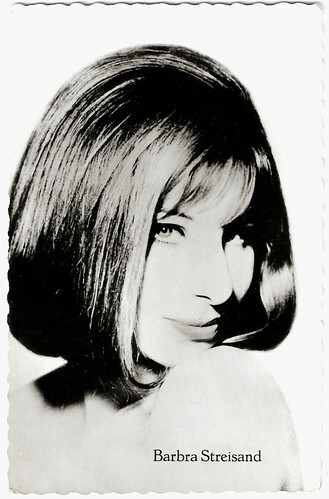
Dutch postcard. Photo: CBS Grammofoonplaten.
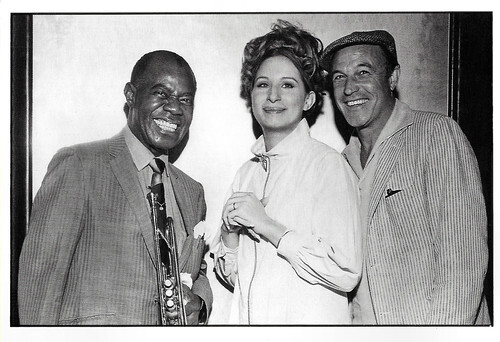
French postcard in the Entr'acte series by Éditions Asphodèle, Mâcon, no. 005/13. Collection: B. Courtel / D.R. Louis Armstrong , Barbra Streisand, and Gene Kelly on the set of Hello Dolly! (Gene Kelly, 1969). Caption: A moment of pause for Gene Kelly and his stars Barbra Streisand and Louis Armstrong.
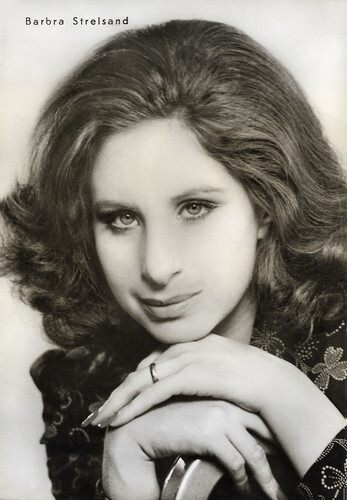
East-German postcard by VEB Progress Film-Vertrieb, Berlin, no. 121/75. Barbra Streisand in The Way We Were (Sydney Pollack, 1973).
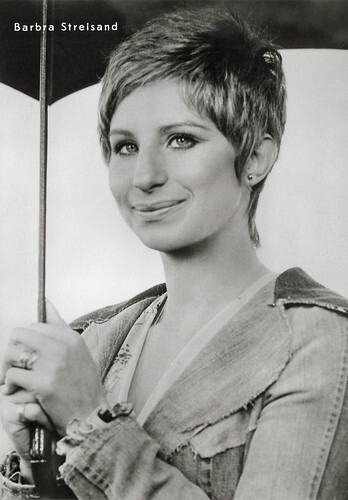
East German postcard by Progress Film-Verleih, Berlin, no. 108/76. Barbra Streisand in For Pete's Sake (Peter Yates, 1977).
Woman in Love
After gaining fame in the 1960s with artistic and highly successful songs from Broadway musicals and interpretations in the realm of traditional pop and jazz standards, Barbra Streisand first moved in a contemporary musical direction influenced by soft rock and mass and youth culture in 1969 with the album 'What About Today?' In the 1970s and early 1980s, Streisand was one of the most important pop singers with her distinctive, always somewhat dramatic-sounding vocal style, with a repertoire of numerous ballads, some from film soundtracks.
She received a second Oscar in 1977 for her composition 'Evergreen' for the film A Star Is Born (Frank Pierson, 1976) with Kris Kristofferson. She was the first woman to be awarded this prize. In 1976, Streisand made a classical album, 'Classical Barbra', that included music by Robert Schumann. From the album 'Lazy Afternoon' (1975) onwards, she also repeatedly recorded songs in the disco style popular at the time. This culminated in the number one hit 'No More Tears (Enough Is Enough)' (1979), a duet with the then "Queen of Disco", Donna Summer.
In 1980, she scored another major no. 1 hit with 'Woman in Love'. The song was taken from her 1980 album 'Guilty', on which she collaborates with Barry Gibb. It was not until 1985 that she returned to her musical roots with 'The Broadway Album' when she recorded some of his most beautiful musical songs under the direction of Stephen Sondheim. The album was a best seller and earned her another Grammy Award for Best Female Pop Vocal Performance in 1987.
In 2005, they collaborated again on the follow-up, 'Guilty Pleasures'. She scored another international hit in 1997 with 'Tell Him', a duet with Céline Dion. In total, Streisand has released more than 60 albums, including 12 film soundtrack albums. She is the female artist with the most gold, platinum and multi-platinum albums.
She made two more films - a supporting role as a sex therapist mother in the Ben Stiller comedy Meet the Fockers (Jay Roach, 2004) and its sequel, Little Fockers (Paul Weitz, 2010), alongside Dustin Hoffman and Robert De Niro . After a long break from filming, she returned to a starring role in The Guilt Trip (Anne Fletcher, 2012), a mother/son picture co-starring Seth Rogen. She published a book, 'Passion for Design', in 2010. Streisand was married to Elliott Gould between 1963 and 1971. They had a son, Jason Gould (1966), who played Streisand's son in the film Prince of Tides (Barbra Streisand, 1991). In 1998, she married James Brolin.
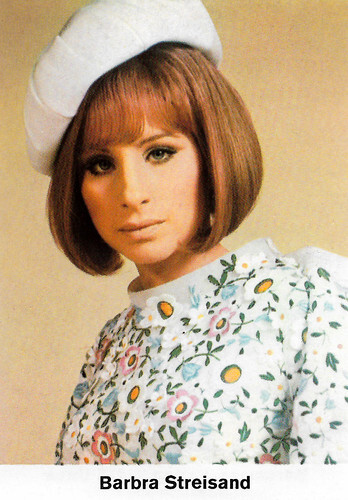
German collectors card in the Show-Top-Stars series by Bergmann Verlag, Unna. The complete series counted 270 star cards.
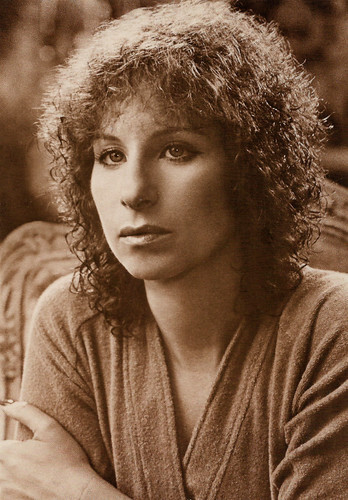
American postcard by Ludlow Sales, New York, N.Y., no. FC 60.
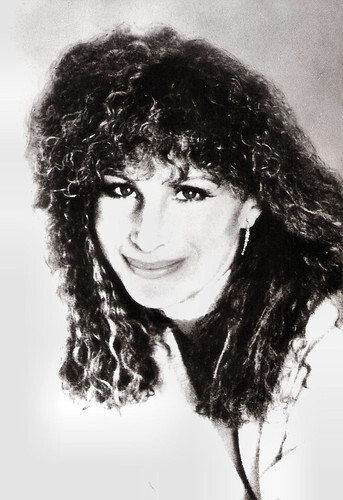
East German postcard by Progress Film-Verleih, Berlin, no. 500/12/89.
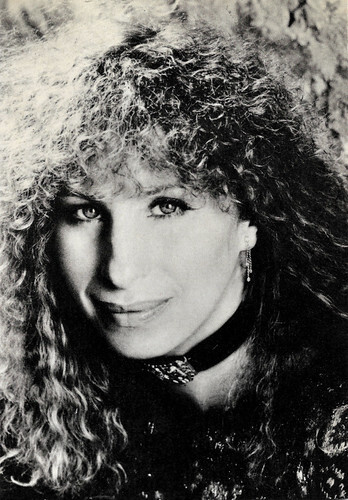
French postcard by Humour a la Carte, Paris, no. 3711.
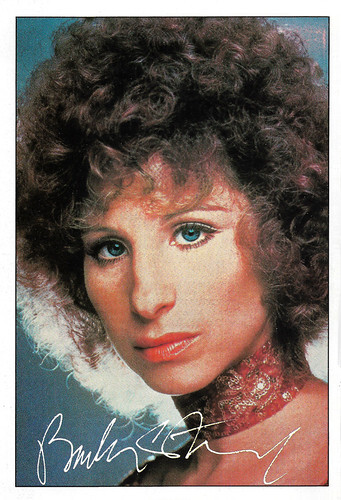
German autograph card by Bravo.
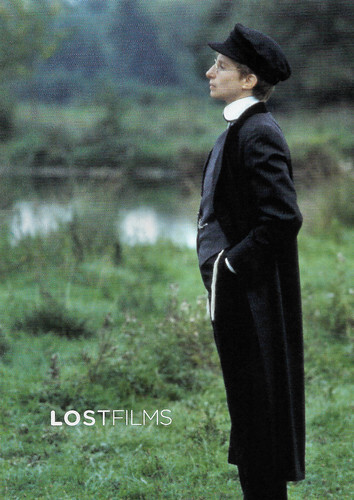
French postcard by Lost Films Distribution. Promotion card for the 2018 re-issue of Yentl (Barbra Streisand, 1983).
Sources: Wikipedia (Dutch, German and French) and .

Romanian postcard by Casa Filmului Acin.

Romanian postcard by Colectia Cinefilului Acin.

Romanian postcard by Casa Filmului Acin, no. 491. Photo: Barbra Streisand and Robert Redford in The Way We Were (Sydney Pollack, 1973).
You'll Never Know
Barbara Joan Streisand was born in the Williamsburg district of Brooklyn, New York, in 1942. Her parents, Emanuel Streisand and Dinah Rosen, were of Jewish descent. Streisand's maternal grandparents came from the Russian Empire and her paternal grandparents were from Polish Galicia. They had emigrated to the US at the turn of the century.
Streisand's parents both worked in education and met at the school where they both worked. Streisand has an older brother, Sheldon Streisand. In August 1943, a few months after her first birthday, Streisand's father died suddenly. Her mother now had to provide income on her own with a low-paid job as an accountant.
When Barbra Streisand was seven years old, her mother married Louis Kind. From this marriage came Streisand's half-sister Roslyn Kind, who also became an actress, singer and songwriter.
Streisand's mother had a beautiful voice and together they made a few tape recordings on which they sang as a duo. This was the first time she thought of a career as a singer. Streisand attended Erasmus Hall High School in Flatbush with Neil Diamond, with whom she later sang the duet 'You Don't Bring Me Flowers', and with future world chess champion Bobby Fischer.
In 1955, 13-year-old Barbra Streisand recorded two songs for a demo tape. One of the recordings was 'You'll Never Know'. Already as a teenager, Streisand performed as a nightclub singer. Because she actually wanted to become an actress, she appeared in the musical 'Driftwood' and several other Summer stock productions. She gained her first stage experience as early as 1958 when she appeared in three plays at the Clinton Theatre.

East-German postcard by VEB Progress Film-Vertrieb, Berlin, no. 186/70. Photo: Steve Schapiro / Columbia. Barbra Streisand in Funny Girl (William Wyler, 1968).

East-German postcard by VEB Progress Film-Vertrieb, Berlin, no. 209/70. Photo: Columbia. Barbra Streisand and Omar Sharif in Funny Girl (William Wyler, 1968).

Dutch postcard. Sent by mail in 1969.

Romanian postcard by Casa Filmului Acin, no. 554, no. 7. John Wayne and Barbra Streisand during the Oscars ceremony 1970. Streisand presented the Best Actor award to Wayne on the 42nd Academy Awards show. Wayne won the Oscar for his performance in True Grit (Henry Hathaway, 1969).
Funny Girl
In 1961 Barbra Streisand made her first television appearance on The Tonight Show. She signed her first recording contract with Columbia Records in 1962. Her debut album, 'Barbra Streisand Album', won two Grammys in 1963. More television guest appearances followed, such as on The Judy Garland Show in 1963, where she sang 'Happy Days Are Here Again' and Judy Garland 's 'Get Happy'. Both songs were arranged by Garland into a duet.
She released her second album, 'The Second Barbra Streisand Album', in the autumn of 1963. From 1961 she also got engagements on Broadway. Her first role was in the musical 'I Can Get It For You Wholesale', by Harold Rome, receiving a Tony Award nomination for Best Supporting Actress and a New York Drama Critics Poll award.
Another smash Broadway hit followed in 1964 as legendary Broadway star Fanny Brice in the musical 'Funny Girl' by Jule Styne and Bob Merrill. Streisand's first no 1 song was 'People', the main song of 'Funny Girl', which reached the top-hit position in 1964. She signed an exclusive contract with CBS for a series of annual TV specials. My Name Is Barbra (1965), which won an Emmy, and Color Me Barbra (1966) were extremely successful.
In the cinema, she had her breakthrough with the leading role in the film adaptation Funny Girl (William Wylker, 1968). Streisand received an Oscar for her role as Fanny Brice at the Academy Awards in 1968. After a series of screen musicals, such as Gene Kelly 's Hello, Dolly! (1969) and Vincente Minnelli's On a Clear Day You Can See Forever (1970), she wanted to try comedies, resulting in such films as The Owl and the Pussycat (Herbert Ross, 1970). She celebrated another significant success alongside Ryan O'Neal in the leading female role in the Screwball Comedy What's Up, Doc? (Peter Bogdanovich, 1972).
In 1972 she also founded the production company Barwoods Films, with which she produced her own films. She turned to dramas and turned out Up the Sandbox (Irvin Kershner, 1972) and the classic The Way We Were (Sydney Pollack, 1973), co-starring Robert Redford . The song 'The Way We Were' became one of her biggest hits and most memorable and famous songs. She debuted as a director with the musical drama Yentl (Barbra Streisand, 1983), in which she also portrayed a Jewish girl who is forced to pass herself off as a man to pursue her dreams. For Yentl, she served as producer, director, screenwriter and lead actress. The preoccupation with Judaism, the theme of Yentl, runs like a thread through Streisand's works. Later, she produced such films as Prince of Tides (Barbra Streisand, 1986), Nuts (Martin Ritt, 1987), and The Mirror Has Two Faces (Barbra Streisand, 1996) with great success.

Dutch postcard. Photo: CBS Grammofoonplaten.

French postcard in the Entr'acte series by Éditions Asphodèle, Mâcon, no. 005/13. Collection: B. Courtel / D.R. Louis Armstrong , Barbra Streisand, and Gene Kelly on the set of Hello Dolly! (Gene Kelly, 1969). Caption: A moment of pause for Gene Kelly and his stars Barbra Streisand and Louis Armstrong.

East-German postcard by VEB Progress Film-Vertrieb, Berlin, no. 121/75. Barbra Streisand in The Way We Were (Sydney Pollack, 1973).

East German postcard by Progress Film-Verleih, Berlin, no. 108/76. Barbra Streisand in For Pete's Sake (Peter Yates, 1977).
Woman in Love
After gaining fame in the 1960s with artistic and highly successful songs from Broadway musicals and interpretations in the realm of traditional pop and jazz standards, Barbra Streisand first moved in a contemporary musical direction influenced by soft rock and mass and youth culture in 1969 with the album 'What About Today?' In the 1970s and early 1980s, Streisand was one of the most important pop singers with her distinctive, always somewhat dramatic-sounding vocal style, with a repertoire of numerous ballads, some from film soundtracks.
She received a second Oscar in 1977 for her composition 'Evergreen' for the film A Star Is Born (Frank Pierson, 1976) with Kris Kristofferson. She was the first woman to be awarded this prize. In 1976, Streisand made a classical album, 'Classical Barbra', that included music by Robert Schumann. From the album 'Lazy Afternoon' (1975) onwards, she also repeatedly recorded songs in the disco style popular at the time. This culminated in the number one hit 'No More Tears (Enough Is Enough)' (1979), a duet with the then "Queen of Disco", Donna Summer.
In 1980, she scored another major no. 1 hit with 'Woman in Love'. The song was taken from her 1980 album 'Guilty', on which she collaborates with Barry Gibb. It was not until 1985 that she returned to her musical roots with 'The Broadway Album' when she recorded some of his most beautiful musical songs under the direction of Stephen Sondheim. The album was a best seller and earned her another Grammy Award for Best Female Pop Vocal Performance in 1987.
In 2005, they collaborated again on the follow-up, 'Guilty Pleasures'. She scored another international hit in 1997 with 'Tell Him', a duet with Céline Dion. In total, Streisand has released more than 60 albums, including 12 film soundtrack albums. She is the female artist with the most gold, platinum and multi-platinum albums.
She made two more films - a supporting role as a sex therapist mother in the Ben Stiller comedy Meet the Fockers (Jay Roach, 2004) and its sequel, Little Fockers (Paul Weitz, 2010), alongside Dustin Hoffman and Robert De Niro . After a long break from filming, she returned to a starring role in The Guilt Trip (Anne Fletcher, 2012), a mother/son picture co-starring Seth Rogen. She published a book, 'Passion for Design', in 2010. Streisand was married to Elliott Gould between 1963 and 1971. They had a son, Jason Gould (1966), who played Streisand's son in the film Prince of Tides (Barbra Streisand, 1991). In 1998, she married James Brolin.

German collectors card in the Show-Top-Stars series by Bergmann Verlag, Unna. The complete series counted 270 star cards.

American postcard by Ludlow Sales, New York, N.Y., no. FC 60.

East German postcard by Progress Film-Verleih, Berlin, no. 500/12/89.

French postcard by Humour a la Carte, Paris, no. 3711.

German autograph card by Bravo.

French postcard by Lost Films Distribution. Promotion card for the 2018 re-issue of Yentl (Barbra Streisand, 1983).
Sources: Wikipedia (Dutch, German and French) and .
Published on September 30, 2023 22:00
September 29, 2023
My postcards from the 1980s and 1990s
Around 2007, Ivo and I started to collect vintage film postcards seriously. Before then, I sometimes bought postcards, but only rarely vintage cards. I did have a collection of film star postcards I bought in cinema and museum shops during the 1980s and 1990s. Although the cards were new then, their subjects were old. I collected film stars from the 1950s and from the silent era. Brando, Monroe and James Dean were all the rage. I loved the black and white pictures of the 1920s by such great photographers as James Abbe, Eugene Robert Richee and George Hurrell and stills of the silent comedy classics such as Buster Keaton's The General (1927) and Charlie Chaplin's The Gold Rush (1925). Today it's my birthday and I'm 63 now. The cards I bought during my twenties and thirties are for many people 'vintage' now. Of course, it depends on what you call vintage, but it's my party and I post what I want to. So today a nostalgic post at EFSP with my postcards from the 1980s and 1990s.
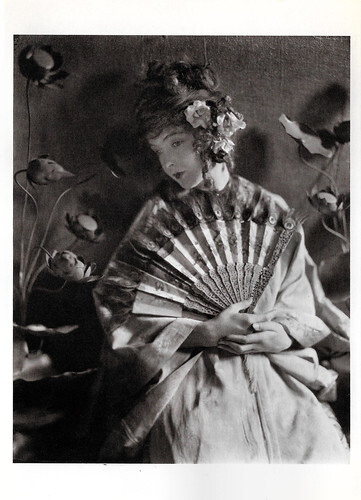
American postcard by Fotofolio, NY, NY, no. JA13. Photo: James Abbe. Lillian Gish in Broken Blossoms (David Wark Griffith, 1919).
American actress Lillian Gish (1893-1993) was 'The First Lady of the Silent Screen'. During the 1910s, she was one of director D.W. Griffith's greatest stars. She appeared in his features such as The Birth of a Nation (1915), Broken Blossoms (1919), and Orphans of the Storm (1921). After 13 years with Griffith, she moved to MGM where her first picture was La Bohème (King Vidor, 1926). In the 1940s, after a long interval, she returned to the screen in a handful of films and received a Best Supporting Actress Oscar nomination for her role as Laura Belle McCanles in Duel in the Sun (King Vidor, 1946). Again a decade later, she was marvellous in the classic Film Noir The Night of the Hunter (Charles Laughton, 1955). Her last film was The Whales of August (Lindsay Anderson, 1987) in which she shared the lead with Bette Davis.
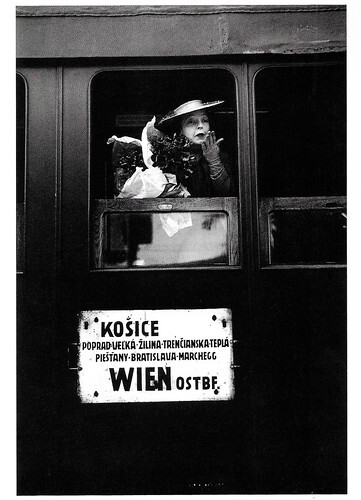
Swiss postcard by News Productions, Baulmes, no. 55706. Photo: John Phillips / Musée de l'Elysée, Lausanne. Caption: Actress and inveterate Traveller Lillian Gish blows a goodbye kiss to friends in Czechoslovakia as she leaves for the USA in 1938, shortly before Hitler occupies Prague.
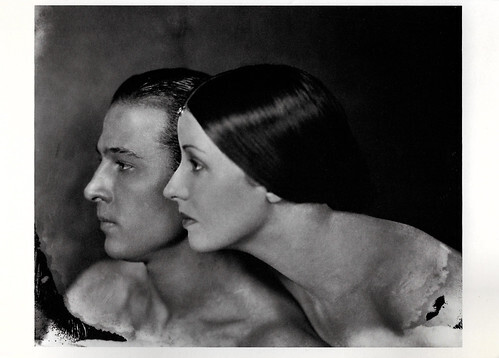
American postcard by Fotofolio, NY, NY, no. JA2. Photo: James Abbe, 1921. Rudolph Valentino and Natascha Rambova.
Rudolph Valentino (1895-1926) was Hollywood's ultimate 'Latin Lover'. The Italian-born American actor starred in several well-known silent films including The Four Horsemen of the Apocalypse (1921), The Sheik (1922), Blood and Sand (1922), The Eagle (1925), and The Son of the Sheik (1926). His early death at age 31 caused mass hysteria among his female fans and propelled him into iconic status.
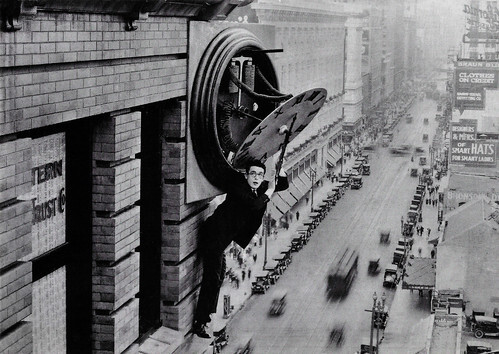
American postcard by The Museum of Modern Art, New York, N.Y., no. 9260, 1988. Photo: The Museum of Modern Art / Film Stills Archive. Harold Lloyd in Safety Last (Fred C. Newmeyer, Sam Taylor, 1923).
American actor, comedian, director, producer, screenwriter, and stunt performer Harold Lloyd (1893-1971) is best known for his silent comedies. He ranks alongside Charlie Chaplin and Buster Keaton as one of the three most popular and influential comedians of silent film. Between 1914 and 1947, Lloyd made nearly 200 comedies, often as a bespectacled 'Glass' character, a resourceful, success-seeking go-getter who was perfectly in tune with the 1920s-era United States. His films frequently contained 'thrill sequences' of extended chase scenes and daredevil physical feats. A classic is Lloyd hanging from the hands of a clock high above the street in Safety Last! (1923).
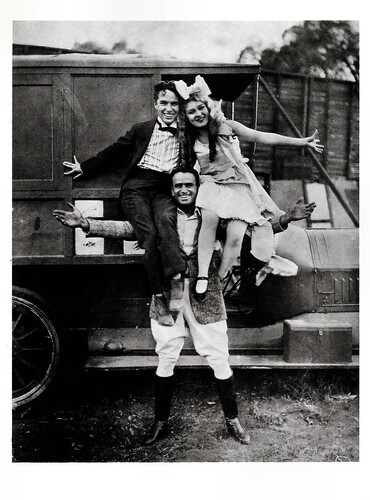
American postcard by Fotofolio, NY, NY, no. P51. Photo: Culver Pictures. Charlie Chaplin , Mary Pickford and Douglas Fairbanks , Hollywood, 1917.
English comedian Charles ‘Charlie’ Chaplin (1889-1977) was one of the most creative and influential personalities of the silent-film era. His most famous role was that of The Tramp with his toothbrush moustache, undersized bowler hat and bamboo cane who struggled to survive while keeping his dignity in a world with great social injustice. Chaplin used mime, slapstick and other visual comedy routines, and he not only starred in his films, but also directed, wrote and produced them, and composed the music as well. His working life in entertainment spanned over 75 years, from the Victorian stage and the Music Hall in the United Kingdom as a child performer, until close to his death at the age of 88. Author George Bernard Shaw called Chaplin "the only genius to come out of the movie industry".
Mary Pickford (1892-1972) was a legendary silent film actress and was known as 'America’s sweetheart.' She was a founder of United Artists and helped establish the Academy.
American actor Douglas Fairbanks (1883-1939) was best known for his swashbuckling roles in silent films such as The Mark of Zorro (1920), Robin Hood (1922), and The Thief of Bagdad (1924), but spent the early part of his career making comedies. Fairbanks was a founding member of United Artists and of The Motion Picture Academy. He hosted the first Oscars Ceremony in 1929. With his marriage to Mary Pickford in 1920, the couple became Hollywood royalty, and Fairbanks was referred to as The King of Hollywood'', but his career rapidly declined with the advent of the 'talkies. His final film was made in Great Britain, The Private Life of Don Juan (1934).
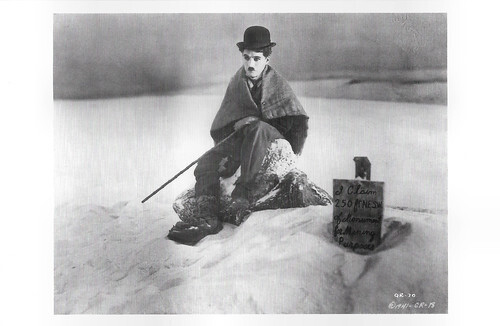
Vintage postcard, no. F4. Charlie Chaplin in The Gold Rush (Charles Chaplin, 1925).
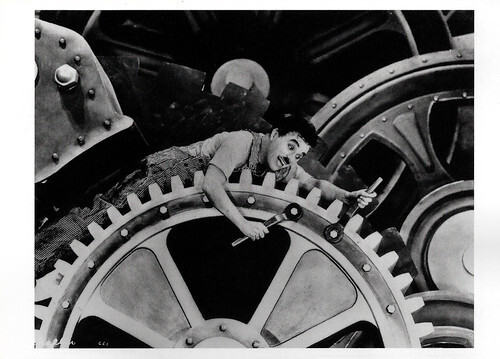
American postcard by Pomegranate Publications, Petaluma, no. 2063. Charlie Chaplin in Modern Times (Charles Chaplin, 1936).
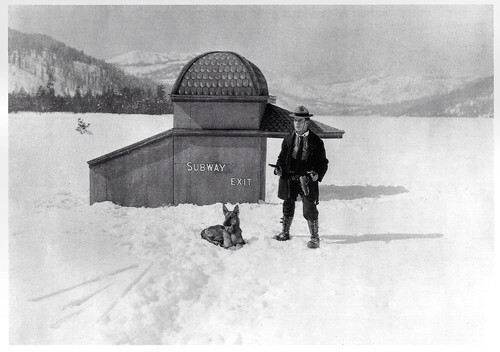
American postcard by The Museum of Modern Art, New York, N.Y., no. 9255, 1988. Photo: The Museum of Modern Art / Film Stills Archive. Buster Keaton in The Frozen North (Edward F. Cline, Buster Keaton, 1922).
Stone-faced Buster Keaton (1895-1966) was one of the three greatest comedians of Silent Hollywood.
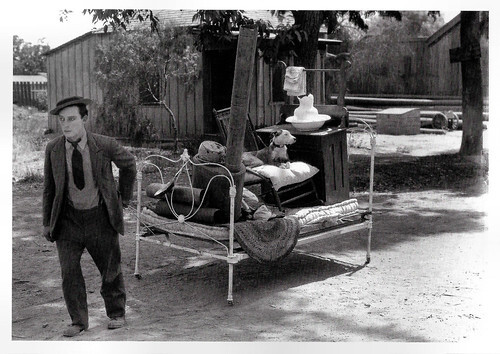
British postcard by Portfolio, London, no. VO 18. Photo: Kobal Collection. Buster Keaton in Go West (Buster Keaton, 1925).
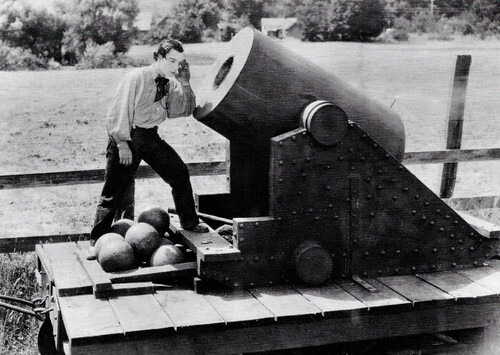
American postcard by The Museum of Modern Art, New York, N.Y., no. 9266, 1982. Photo: The Museum of Modern Art / Film Stills Archive. Buster Keaton in The General (Clyde Bruckman, Buster Keaton, 1927).
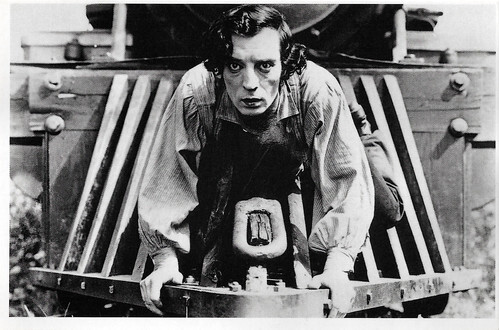
British postcard by World Postcards Inc., no. X283, 1990, no. 9266, 1982. Buster Keaton in The General (Clyde Bruckman, Buster Keaton, 1927).
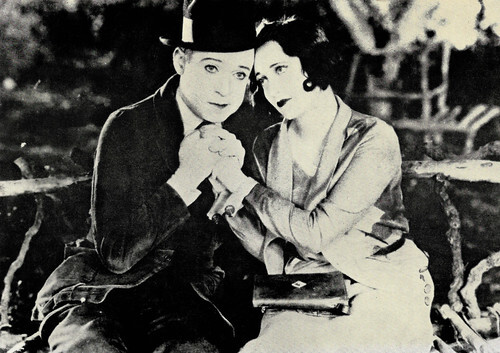
French postcard by François Nugeron, Paris. Photo: Collection Snark. Harry Langdon and Joan Crawford in Tramp, Tramp, Tramp (Frank Capra, 1926). The French film title was Plein des bottes.
Hollywood comedian Harry Langdon (1884-1944), often called 'Baby Face', had enormous success during his heyday. Early in his film career, he had the good fortune to work regularly with director Harry Edwards, writer Frank Arthur Ripley, and the young Frank Capra. They created his unique character of the innocent and helpless man-child who found himself in dramatic and hazardous circumstances with only providence and good luck to survive. Despite his success, Langdon has remained far more obscure than his contemporaries as Charlie Chaplin, Harold Lloyd, and Buster Keaton.
American film star Joan Crawford (1904-1977) had a career that would span many decades, studios, and controversies. In her silent films, she made an impact as a vivacious Jazz Age flapper and later she matured into a star of psychological melodramas.
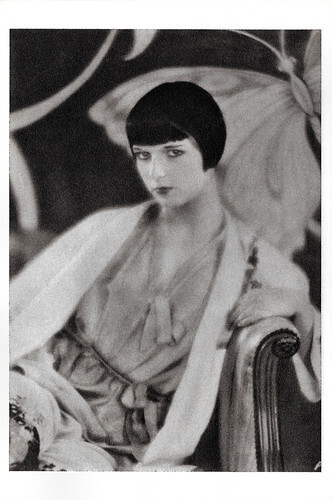
French postcard by Editions La Malibran, Paris, no. CA 30. Photo: Eugene Robert Richee.
Legendary American dancer and actress Louise Brooks (1906-1985) set the trend of the bobbed haircut and personified the flapper, the rebellious young woman of the 1920s. She played the lead in three European silent film classics: Die Büchse der Pandora/Pandora's Box (1929), Tagebuch einer Verlorenen/Diary of a Lost Girl (1929), and Prix de Beauté /Miss Europe (1930).
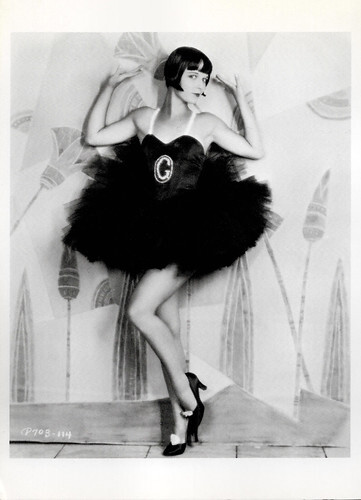
American postcard by Fotofolio, NY, NY, no. K 45. Photo: Eugene Robert Richee / The Kobal Collection. Caption: Louise Brooks , 1928.
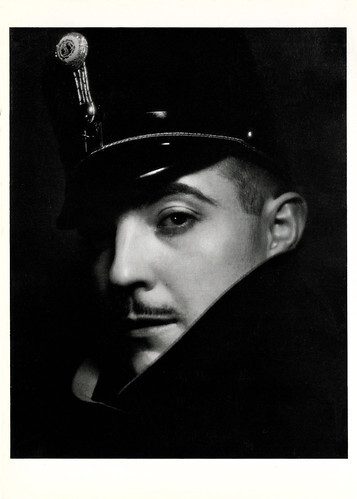
American postcard by Fotofolio, NY, NY, no. GH8. Photo: George Hurrell / Creative Art Images, Hollywood. Caption: Ramon Novarro , 1931. Publicity still for Daybreak (Jacques Feyder, 1931).
Mexican-American actor Ramon Novarro (1899-1968) was a popular Latin Lover of the 1920s and early 1930s. He was the star of silent Hollywood's biggest epic, Ben-Hur (Fred Niblo, 1925).
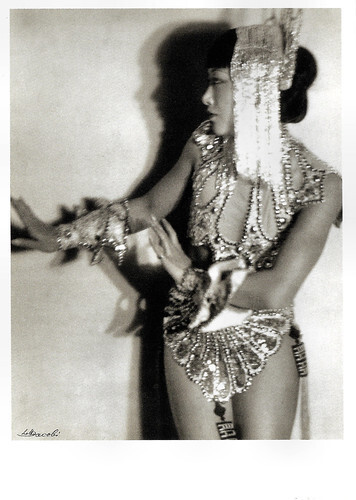
German postcard in the Ausdrucktstanz series by Galerie Bodo Niemann, Berlin, no. 08/10. Photo: Lotte Jacobi. Caption: Anna May Wong , Berlin, ca. 1931.
Anna May Wong (1905-1961) was the first Chinese-American movie star, and the first Asian American actress to gain international recognition. Frustrated by the stereotypical supporting roles she reluctantly played in Hollywood, Wong left for Europe, where she starred in such classics as Piccadilly (1929).
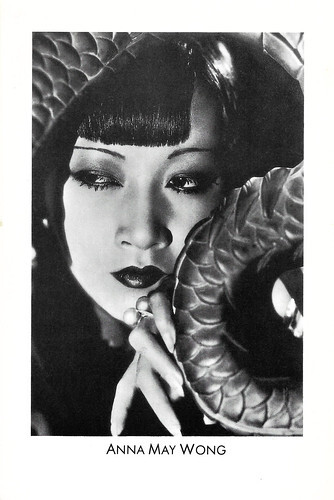
British postcard by James Gardiner Postcards, Watford in The Glamour Queens series, no. 15, 1988. Photo: Otto Dyar.
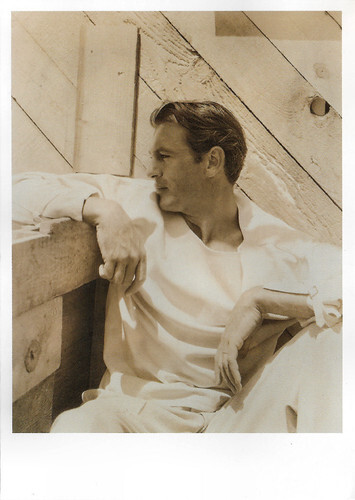
American postcard by the Metropolitan Museum of Modern Art, no. 01-02619-3, 1994. Photo: George Hoyningen-Huene. Caption: Gary Cooper , 1934.
American screen legend Gary Cooper (1901-1961) is well remembered for his stoic, understated acting style in more than one hundred Westerns, comedies and dramas. He received five Oscar nominations and won twice for his roles as Alvin York in Sergeant York (1941) and as Will Kane in High Noon (1952).
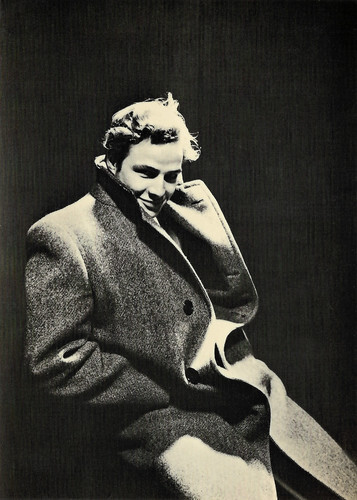
British postcard by Camden Graphics Ltd, London, 1982, no. PC 427. Photo: Cecil Beaton. Caption: Marlon Brando , 1946.
American film star Marlon Brando (1924-2004) was one of the greatest and most influential actors of all time. A cultural icon, Brando is most famous for his Oscar-winning performances as Terry Malloy in On the Waterfront (Elia Kazan, 1954) and Vito Corleone in The Godfather (1972). He initially gained popularity for recreating the role of Stanley Kowalski in the film A Streetcar Named Desire (Elia Kazan,1951), adapted from the Tennessee Williams play in which he became recognized as a Broadway star during its 1947–49 stage run. Then followed his Academy Award-winning performance as Terry Malloy in On the Waterfront (Elia Kazan, 1954), as well as for his iconic portrayal of the rebel motorcycle gang leader Johnny Strabler in The Wild One (Laslo Benedek, 1953), which is considered to be one of the most famous images in pop culture.
French postcard by Editions La Malibran, Paris, no. CA 74. Photo: John Engstead. Marlon Brando in A Streetcar Named Desire (Elia Kazan, 1951).
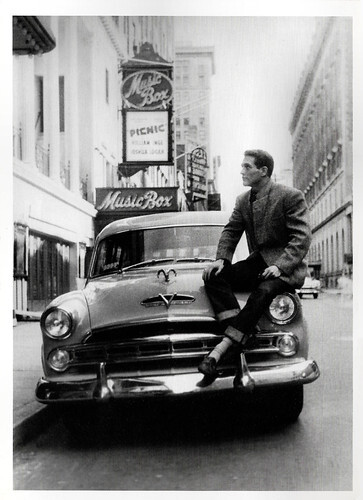
American postcard by Fotofolio, NY, NY, no. P332. Photo: D. D. & E. Peter Schroeder. Caption: Paul Newman , New York City, 1953.
American film actor Paul Newman (1925-2008) was a matinee idol with the most famous blue eyes in Hollywood, who often played detached yet charismatic anti-heroes and rebels. He was nominated for nine acting Academy Awards in five different decades and won the Oscar for The Color of Money (1986). He was also a prominent social activist, a major proponent of actors' creative rights, and a noted philanthropist.
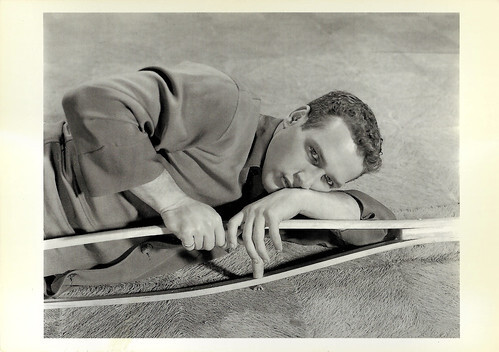
French postcard in the Collection Magie Noire by Editions Hazan, Paris, 1988, no. 6015. Photo: anonymous / Ciné Images.
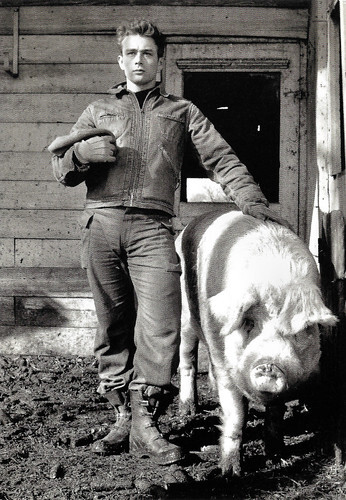
French postcard by Grafique de France, no. SC 109. Photo: Dennis Stock. Caption: James Dean , 1954.
American actor James Dean (1931-1955) was the quintessential 1950s teenager, brooding and romantic. An air of androgyny attributed to his iconic appeal to both men and women. The three roles that defined his stardom are as troubled teenager Jim Stark in Rebel Without a Cause (1955), loner Cal Trask in East of Eden (1955) and surly Ranch hand Jett Rink in Giant (1956). After his death in a car crash, the only 24-year-old Dean became the first actor to receive a posthumous Academy Award nomination for Best Actor.
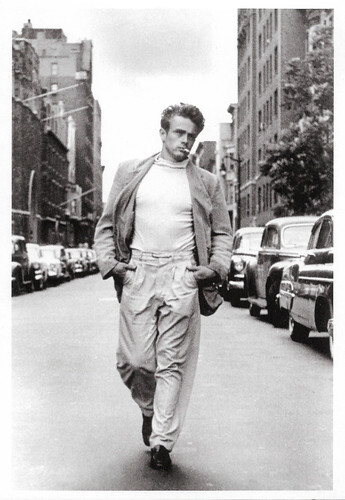
American postcard by Pomegranate Publications, Rohnert Park, CSA, no. 2925. Photo: Roy Schatt.
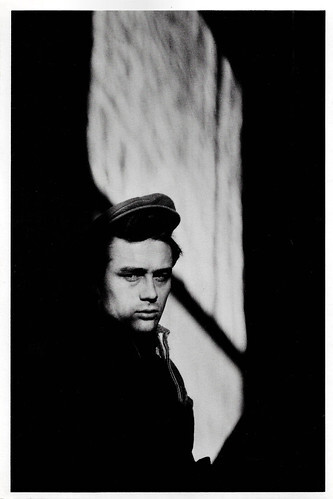
American postcard by the American Postcard Co., no. 250, 1984. Photo: Dennis Stock. Caption: James Dean , Fairmount, Indiana, 1955.
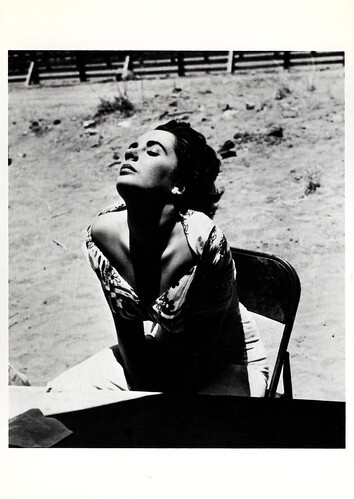
American postcard by Fotofolio, NY, NY, no. P145. Photo: Sid Avery. Elizabeth Taylor sunning herself on the Marfa, Texas set of Giant, 1955.
British-American actress Elizabeth Taylor (1932-2011) began as a child star. As an adult, she came to be known for her acting talent and beauty. She had a much-publicised private life, including eight marriages and several near-death experiences. Taylor was considered one of the great actresses of Hollywood's Golden Age.
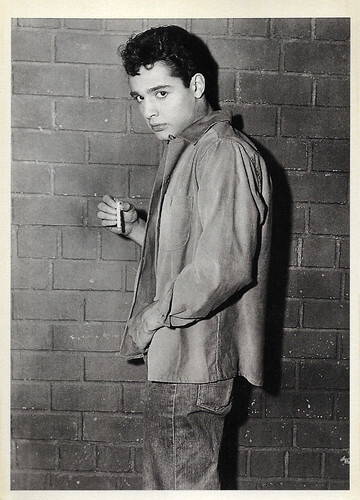
American postcard by Pomegranate Publications, Petaluma, CA, no. 5874. Photo: Michael Ochs Archives.
American actor Sal Mineo (1939-1976) was a teen idol during the late 1950s. He shot to fame as Plato in the classic Rebel Without a Cause (1955) featuring James Dean. Diminutive and sad-eyed, his performance perfectly captured the film's themes of youthful desperation, and struck a chord with audiences as well as critics, earning him a Best Supporting Actor Academy Award nomination. He co-starred again with Dean in Giant (1956) and with Paul Newman in Somebody Up There Likes Me (1956). In 1957, he scored a pair of Top 40 hits with 'Start Movin' (In My Direction) and 'Lasting Love'.
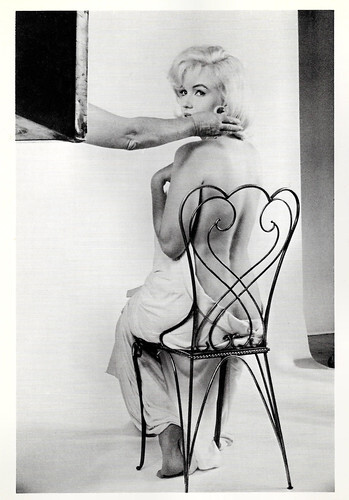
American postcard by Fotofolio, NY, NY, no. MP3. Photo: Eve Arnold / Magnum Photos Inc. Caption: Marilyn Monroe , Studio Session, Hollywood, 1960.

American postcard by Fotofolio, NY, NY, no. JA13. Photo: James Abbe. Lillian Gish in Broken Blossoms (David Wark Griffith, 1919).
American actress Lillian Gish (1893-1993) was 'The First Lady of the Silent Screen'. During the 1910s, she was one of director D.W. Griffith's greatest stars. She appeared in his features such as The Birth of a Nation (1915), Broken Blossoms (1919), and Orphans of the Storm (1921). After 13 years with Griffith, she moved to MGM where her first picture was La Bohème (King Vidor, 1926). In the 1940s, after a long interval, she returned to the screen in a handful of films and received a Best Supporting Actress Oscar nomination for her role as Laura Belle McCanles in Duel in the Sun (King Vidor, 1946). Again a decade later, she was marvellous in the classic Film Noir The Night of the Hunter (Charles Laughton, 1955). Her last film was The Whales of August (Lindsay Anderson, 1987) in which she shared the lead with Bette Davis.

Swiss postcard by News Productions, Baulmes, no. 55706. Photo: John Phillips / Musée de l'Elysée, Lausanne. Caption: Actress and inveterate Traveller Lillian Gish blows a goodbye kiss to friends in Czechoslovakia as she leaves for the USA in 1938, shortly before Hitler occupies Prague.

American postcard by Fotofolio, NY, NY, no. JA2. Photo: James Abbe, 1921. Rudolph Valentino and Natascha Rambova.
Rudolph Valentino (1895-1926) was Hollywood's ultimate 'Latin Lover'. The Italian-born American actor starred in several well-known silent films including The Four Horsemen of the Apocalypse (1921), The Sheik (1922), Blood and Sand (1922), The Eagle (1925), and The Son of the Sheik (1926). His early death at age 31 caused mass hysteria among his female fans and propelled him into iconic status.

American postcard by The Museum of Modern Art, New York, N.Y., no. 9260, 1988. Photo: The Museum of Modern Art / Film Stills Archive. Harold Lloyd in Safety Last (Fred C. Newmeyer, Sam Taylor, 1923).
American actor, comedian, director, producer, screenwriter, and stunt performer Harold Lloyd (1893-1971) is best known for his silent comedies. He ranks alongside Charlie Chaplin and Buster Keaton as one of the three most popular and influential comedians of silent film. Between 1914 and 1947, Lloyd made nearly 200 comedies, often as a bespectacled 'Glass' character, a resourceful, success-seeking go-getter who was perfectly in tune with the 1920s-era United States. His films frequently contained 'thrill sequences' of extended chase scenes and daredevil physical feats. A classic is Lloyd hanging from the hands of a clock high above the street in Safety Last! (1923).

American postcard by Fotofolio, NY, NY, no. P51. Photo: Culver Pictures. Charlie Chaplin , Mary Pickford and Douglas Fairbanks , Hollywood, 1917.
English comedian Charles ‘Charlie’ Chaplin (1889-1977) was one of the most creative and influential personalities of the silent-film era. His most famous role was that of The Tramp with his toothbrush moustache, undersized bowler hat and bamboo cane who struggled to survive while keeping his dignity in a world with great social injustice. Chaplin used mime, slapstick and other visual comedy routines, and he not only starred in his films, but also directed, wrote and produced them, and composed the music as well. His working life in entertainment spanned over 75 years, from the Victorian stage and the Music Hall in the United Kingdom as a child performer, until close to his death at the age of 88. Author George Bernard Shaw called Chaplin "the only genius to come out of the movie industry".
Mary Pickford (1892-1972) was a legendary silent film actress and was known as 'America’s sweetheart.' She was a founder of United Artists and helped establish the Academy.
American actor Douglas Fairbanks (1883-1939) was best known for his swashbuckling roles in silent films such as The Mark of Zorro (1920), Robin Hood (1922), and The Thief of Bagdad (1924), but spent the early part of his career making comedies. Fairbanks was a founding member of United Artists and of The Motion Picture Academy. He hosted the first Oscars Ceremony in 1929. With his marriage to Mary Pickford in 1920, the couple became Hollywood royalty, and Fairbanks was referred to as The King of Hollywood'', but his career rapidly declined with the advent of the 'talkies. His final film was made in Great Britain, The Private Life of Don Juan (1934).

Vintage postcard, no. F4. Charlie Chaplin in The Gold Rush (Charles Chaplin, 1925).

American postcard by Pomegranate Publications, Petaluma, no. 2063. Charlie Chaplin in Modern Times (Charles Chaplin, 1936).

American postcard by The Museum of Modern Art, New York, N.Y., no. 9255, 1988. Photo: The Museum of Modern Art / Film Stills Archive. Buster Keaton in The Frozen North (Edward F. Cline, Buster Keaton, 1922).
Stone-faced Buster Keaton (1895-1966) was one of the three greatest comedians of Silent Hollywood.

British postcard by Portfolio, London, no. VO 18. Photo: Kobal Collection. Buster Keaton in Go West (Buster Keaton, 1925).

American postcard by The Museum of Modern Art, New York, N.Y., no. 9266, 1982. Photo: The Museum of Modern Art / Film Stills Archive. Buster Keaton in The General (Clyde Bruckman, Buster Keaton, 1927).

British postcard by World Postcards Inc., no. X283, 1990, no. 9266, 1982. Buster Keaton in The General (Clyde Bruckman, Buster Keaton, 1927).

French postcard by François Nugeron, Paris. Photo: Collection Snark. Harry Langdon and Joan Crawford in Tramp, Tramp, Tramp (Frank Capra, 1926). The French film title was Plein des bottes.
Hollywood comedian Harry Langdon (1884-1944), often called 'Baby Face', had enormous success during his heyday. Early in his film career, he had the good fortune to work regularly with director Harry Edwards, writer Frank Arthur Ripley, and the young Frank Capra. They created his unique character of the innocent and helpless man-child who found himself in dramatic and hazardous circumstances with only providence and good luck to survive. Despite his success, Langdon has remained far more obscure than his contemporaries as Charlie Chaplin, Harold Lloyd, and Buster Keaton.
American film star Joan Crawford (1904-1977) had a career that would span many decades, studios, and controversies. In her silent films, she made an impact as a vivacious Jazz Age flapper and later she matured into a star of psychological melodramas.

French postcard by Editions La Malibran, Paris, no. CA 30. Photo: Eugene Robert Richee.
Legendary American dancer and actress Louise Brooks (1906-1985) set the trend of the bobbed haircut and personified the flapper, the rebellious young woman of the 1920s. She played the lead in three European silent film classics: Die Büchse der Pandora/Pandora's Box (1929), Tagebuch einer Verlorenen/Diary of a Lost Girl (1929), and Prix de Beauté /Miss Europe (1930).

American postcard by Fotofolio, NY, NY, no. K 45. Photo: Eugene Robert Richee / The Kobal Collection. Caption: Louise Brooks , 1928.

American postcard by Fotofolio, NY, NY, no. GH8. Photo: George Hurrell / Creative Art Images, Hollywood. Caption: Ramon Novarro , 1931. Publicity still for Daybreak (Jacques Feyder, 1931).
Mexican-American actor Ramon Novarro (1899-1968) was a popular Latin Lover of the 1920s and early 1930s. He was the star of silent Hollywood's biggest epic, Ben-Hur (Fred Niblo, 1925).

German postcard in the Ausdrucktstanz series by Galerie Bodo Niemann, Berlin, no. 08/10. Photo: Lotte Jacobi. Caption: Anna May Wong , Berlin, ca. 1931.
Anna May Wong (1905-1961) was the first Chinese-American movie star, and the first Asian American actress to gain international recognition. Frustrated by the stereotypical supporting roles she reluctantly played in Hollywood, Wong left for Europe, where she starred in such classics as Piccadilly (1929).

British postcard by James Gardiner Postcards, Watford in The Glamour Queens series, no. 15, 1988. Photo: Otto Dyar.

American postcard by the Metropolitan Museum of Modern Art, no. 01-02619-3, 1994. Photo: George Hoyningen-Huene. Caption: Gary Cooper , 1934.
American screen legend Gary Cooper (1901-1961) is well remembered for his stoic, understated acting style in more than one hundred Westerns, comedies and dramas. He received five Oscar nominations and won twice for his roles as Alvin York in Sergeant York (1941) and as Will Kane in High Noon (1952).

British postcard by Camden Graphics Ltd, London, 1982, no. PC 427. Photo: Cecil Beaton. Caption: Marlon Brando , 1946.
American film star Marlon Brando (1924-2004) was one of the greatest and most influential actors of all time. A cultural icon, Brando is most famous for his Oscar-winning performances as Terry Malloy in On the Waterfront (Elia Kazan, 1954) and Vito Corleone in The Godfather (1972). He initially gained popularity for recreating the role of Stanley Kowalski in the film A Streetcar Named Desire (Elia Kazan,1951), adapted from the Tennessee Williams play in which he became recognized as a Broadway star during its 1947–49 stage run. Then followed his Academy Award-winning performance as Terry Malloy in On the Waterfront (Elia Kazan, 1954), as well as for his iconic portrayal of the rebel motorcycle gang leader Johnny Strabler in The Wild One (Laslo Benedek, 1953), which is considered to be one of the most famous images in pop culture.
French postcard by Editions La Malibran, Paris, no. CA 74. Photo: John Engstead. Marlon Brando in A Streetcar Named Desire (Elia Kazan, 1951).

American postcard by Fotofolio, NY, NY, no. P332. Photo: D. D. & E. Peter Schroeder. Caption: Paul Newman , New York City, 1953.
American film actor Paul Newman (1925-2008) was a matinee idol with the most famous blue eyes in Hollywood, who often played detached yet charismatic anti-heroes and rebels. He was nominated for nine acting Academy Awards in five different decades and won the Oscar for The Color of Money (1986). He was also a prominent social activist, a major proponent of actors' creative rights, and a noted philanthropist.

French postcard in the Collection Magie Noire by Editions Hazan, Paris, 1988, no. 6015. Photo: anonymous / Ciné Images.

French postcard by Grafique de France, no. SC 109. Photo: Dennis Stock. Caption: James Dean , 1954.
American actor James Dean (1931-1955) was the quintessential 1950s teenager, brooding and romantic. An air of androgyny attributed to his iconic appeal to both men and women. The three roles that defined his stardom are as troubled teenager Jim Stark in Rebel Without a Cause (1955), loner Cal Trask in East of Eden (1955) and surly Ranch hand Jett Rink in Giant (1956). After his death in a car crash, the only 24-year-old Dean became the first actor to receive a posthumous Academy Award nomination for Best Actor.

American postcard by Pomegranate Publications, Rohnert Park, CSA, no. 2925. Photo: Roy Schatt.

American postcard by the American Postcard Co., no. 250, 1984. Photo: Dennis Stock. Caption: James Dean , Fairmount, Indiana, 1955.

American postcard by Fotofolio, NY, NY, no. P145. Photo: Sid Avery. Elizabeth Taylor sunning herself on the Marfa, Texas set of Giant, 1955.
British-American actress Elizabeth Taylor (1932-2011) began as a child star. As an adult, she came to be known for her acting talent and beauty. She had a much-publicised private life, including eight marriages and several near-death experiences. Taylor was considered one of the great actresses of Hollywood's Golden Age.

American postcard by Pomegranate Publications, Petaluma, CA, no. 5874. Photo: Michael Ochs Archives.
American actor Sal Mineo (1939-1976) was a teen idol during the late 1950s. He shot to fame as Plato in the classic Rebel Without a Cause (1955) featuring James Dean. Diminutive and sad-eyed, his performance perfectly captured the film's themes of youthful desperation, and struck a chord with audiences as well as critics, earning him a Best Supporting Actor Academy Award nomination. He co-starred again with Dean in Giant (1956) and with Paul Newman in Somebody Up There Likes Me (1956). In 1957, he scored a pair of Top 40 hits with 'Start Movin' (In My Direction) and 'Lasting Love'.

American postcard by Fotofolio, NY, NY, no. MP3. Photo: Eve Arnold / Magnum Photos Inc. Caption: Marilyn Monroe , Studio Session, Hollywood, 1960.
Published on September 29, 2023 22:00
September 28, 2023
Charlie Sheen
American actor Charlie Sheen (1965) had his breakthrough with Oliver Stone's Oscar-winning epic Platoon (1986). Other hits were Wall Street (1987), Young Guns (1988), Major League (1989), Navy SEALs (1990), The Three Musketeers (1993), and Terminal Velocity (1994). He made a come-back with the sitcom Two and a Half Men (2003).
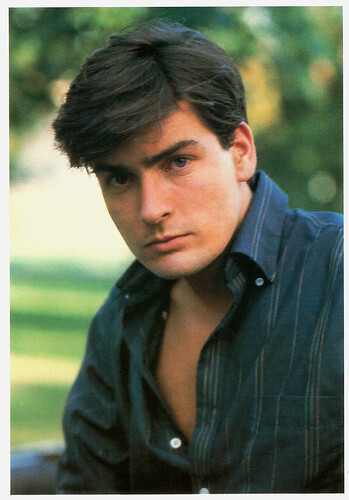
British postcard by Santoro Graphics Ltd., London, no. C285.
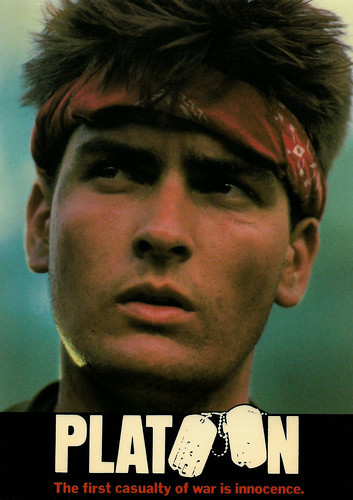
British postcard by Reflex Marketing LTD., Wellingborough, England, no. PC 243. Photo: Hemsdale Film Corporation, 1986. Charlie Sheen in Platoon (Oliver Stone, 1986). Caption: The first casualty of war is innocence.
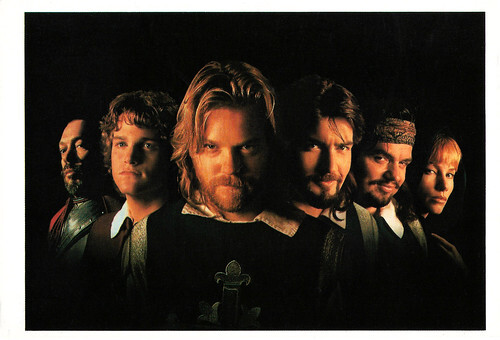
British postcard by Film Review, set H, card 1. Photo: Walt Disney / Buena Vista (UK) International Ltd. Kiefer Sutherland, Charlie Sheen, Chris O'Donnell, Oliver Platt, Tim Curry and Rebecca De Mornay in Three Musketeers (Stephen Herek, 1993). Caption: Disney's contemporary re-telling of a classic adventure.
A young soldier caught in the centre of a moral crisis
Charlie Sheen was born Carlos Irwin Estévez in 1965, in New York City. His father, actor Martin Sheen (born Ramon Antonio Gerard Estevez), was at the time just breaking into the business, with performances on Broadway. His mother, Janet Sheen (née Templeton), was a former New York art student who had met Charlie's father right after he had moved to Manhattan. Martin and Janet had three other children, Emilio Estevez, Renée Estevez, and Ramon Estevez, all of whom became actors. Charlie is the only member of his family to legally change his name to Sheen and pass that new name on to his children.
At a young age, Charlie took an interest in his father's acting career. When he was nine, he was given a small part in his dad's movie The Execution of Private Slovik (Lamont Johnson, 1974). In 1977, he was in the Philippines where his dad suffered a near-fatal heart attack on the set of Apocalypse Now (Francis Ford Coppola, 1979). While at Santa Monica High School, Charlie had two major interests: acting and baseball. Along with his friends, which included Rob Lowe and Sean Penn, he produced and starred in several amateur Super-8 films. On the Vikings baseball team, he was a star shortstop and pitcher. He fought constantly with his older brother Emilio Estevez. He was a good student, but then let his grades slip when he skipped school in high school to play baseball. Just a few weeks before his scheduled graduation date, Charlie was expelled due to poor attendance and bad grades. After high school, Charlie Sheen aggressively pursued many acting roles.
His first major role was as a high school student in the teen war film Red Dawn (John Milius, 1984) starring Patrick Swayze and C. Thomas Howell. He followed this up with relatively small roles in TV movies and low-profile releases. His big break came in 1986 when he starred in the Oscar-winning war epic Platoon (Oliver Stone, 1986). He drew rave reviews for his portrayal of a young soldier who is caught in the centre of a moral crisis in Vietnam. The success of Platoon (1986) prompted Oliver Stone to cast Charlie in his next film Wall Street (Oliver Stone, 1987) alongside Michael Douglas and his father Martin Sheen. The film with its "Greed is Good" theme became an instant hit with viewers. Shortly after, Stone approached Charlie about the starring role in his next movie, Born on the Fourth of July (1989). When Tom Cruise eventually got the part, Sheen ended up hearing the news from his brother Emilio Estevez and not even getting as much as a call from Stone. This led to a fallout, and the two have not worked together since.
The fallout with Stone, however, did nothing to hurt Charlie's career in the late 1980s and early 1990s, as he continued to establish himself as one of the top box office draws with a string of hits that included the biographical Western Young Guns (Christopher Cain, 1988) with his brother Emilio Estevez, the sports comedy Major League (David S. Ward, 1989), the buddy cop film The Rookie (Clint Eastwood, 1990), and the spoof Hot Shots! (Jim Abrahams, 1991). However, as the mid-1990s neared, his good fortune both personally and professionally, soon came to an end.
Around this time, Charlie Sheen, who had already been to drug rehab, was beginning to develop a reputation as a hard-partying, womaniser. In 1995, the same year he was briefly married to model Donna Peele, he was called to testify at the trial of Hollywood madam Heidi Fleiss. At the trial, while under oath he admitted to spending nearly $50,000 on 27 of Fleiss' $2,500-a-night prostitutes. His downward spiral continued the following year when his ex-girlfriend Brittany Ashland filed charges claiming that he physically abused her. He was later charged with misdemeanour battery to which he pleaded no contest and was given a year's suspended sentence, two years probation, and a $2,800 fine. He finally hit rock bottom in May 1998 when he was hospitalised in Thousand Oaks, California, following a near-fatal drug overdose. Later that month, he was ordered back to the drug rehab centre, which he had previously left after one day. During this stretch, Charlie's film career began to suffer as well. He starred in a series of box office flops that included The Arrival (David Twohy, 1996) and Shadow Conspiracy (George P. Cosmatos, 1997). However as the 1990s came to an end, so did Charlie's string of bad luck.
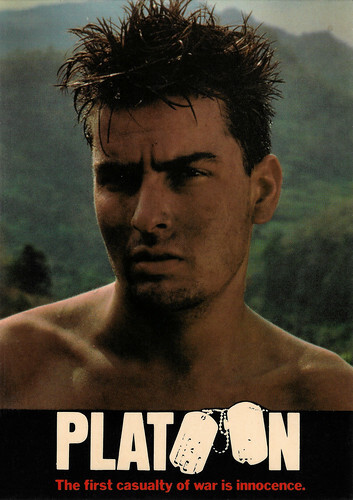
British postcard by Reflex Marketing LTD, Wellingborough, no. PC 244. Photo: Hemdale Film Corporation, 1986. Charlie Sheen in Platoon (Oliver Stone, 1986). Caption: The first casualty of war is innocence.
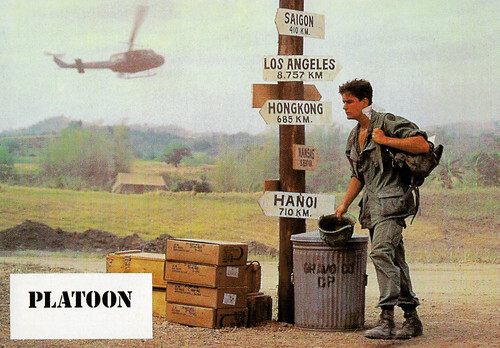
French postcard by Humour a la Carte, Paris, no. A-C 1253. Charlie Sheen in Platoon (Oliver Stone, 1986).
The highest-paid comedy star on television
In 2000, Charlie Sheen, now clean and sober, was chosen to replace Michael J. Fox on the ABC hit sitcom Spin City (1996). Though his stint lasted only two seasons, Charlie's performance caught the eye of CBS executives who in 2003 were looking for an established star to help carry their Monday night lineup of sitcoms that included Everybody Loves Raymond (1996). The sitcom Two and a Half Men (2003) starred Charlie as a swinging, irresponsible womaniser whose life changes when his nephew suddenly appears on his doorstep.
The show became a huge hit, breathing much-needed life into Charlie's fading career. He gained three Emmy Award nominations and two Golden Globe award nominations. Charlie's personal life also appeared to be improving. In 2002, he married actress Denise Richards, whom he first met while shooting the film Good Advice (Steve Rash, 2001). In 2004, they had a daughter, Sam, and it was announced shortly after that Denise was pregnant with the couple's second child. By all reports, the couple seemed to be very happy together. However, like all of Charlie's previous relationships, the stability did not last long.
In March of 2005, Denise, who was six months pregnant, filed for divorce, citing irreconcilable differences. She gave birth to a second daughter, Lola, in June of that same year. Their divorce became final in late 2006. At the time, he was the highest-paid comedy star on television. He earned $350,000 per episode for Two and a Half Men, and during his eighth and final season on the show, Sheen even earned $1.8 million per episode. In 2008, he married Brooke Mueller. They had also two children, twin sons Bob Sheen and Max Sheen (2009). He checked himself into a rehab facility about a domestic violence assault on his wife in late 2009. However, the couple divorced in 2011.
In March 2011, his contract for Two and a Half Men was terminated by CBS and Warner Bros. following his derogatory comments about the series creator, Chuck Lorre. He was replaced by Ashton Kutcher. In 2015, he admitted his HIV-positive condition during an interview with Matt Lauer on the TV Show Today, in which he said that he was diagnosed four years ago. He chose to go public to stop people from blackmailing him for money. He had another success with the TV Sitcom Anger Management (2012-2014), the spin-off of the film of the same name. But the film 9/11 (Martin Guigui, 2017) was a notorious box office flop.
In 2017, Sheen sued the National Enquirer over a story alleging that, in 1986, the then 19-year-old actor raped his 13-year-old co-star Corey Haim on the set of Lucas (David Seltzer, 1986). The case was settled in 2018. Haim's mother, Judy Haim, identified a different actor as her son's rapist on The Dr. Oz Show, and told Entertainment Tonight that Sheen never raped her son, calling the claims "made up". In 2020, actor Corey Feldman repeated the claim that Sheen raped Haim in his documentary '(My) Truth: The Rape of Two Coreys', corroborated by Feldman's ex-wife Susie Feldman and his Lost Boys (Joel Schumacher, 1987) co-star Jamison Newlander. Sheen, through his publicist, denied the allegations, calling them "sick, twisted and outlandish".
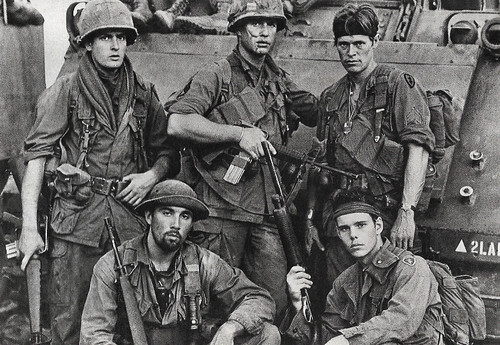
French postcard by Humour a la Carte, Paris, no. A-C 1256. Charlie Sheen, Tom Berenger and Willem Dafoe (top row) in Platoon (Oliver Stone, 1986). Bottom row: Francesco Quinn and Kevin Dillon.
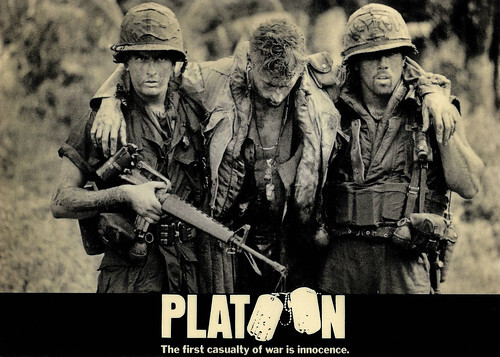
British postcard by Reflex Marketing LTD, Wellingborough, no. PC 245. Photo: Hemdale Film Corporation, 1986. Charlie Sheen in Platoon (Oliver Stone, 1986). Caption: The first casualty of war is innocence.
Sources: Wikipedia and .

British postcard by Santoro Graphics Ltd., London, no. C285.

British postcard by Reflex Marketing LTD., Wellingborough, England, no. PC 243. Photo: Hemsdale Film Corporation, 1986. Charlie Sheen in Platoon (Oliver Stone, 1986). Caption: The first casualty of war is innocence.

British postcard by Film Review, set H, card 1. Photo: Walt Disney / Buena Vista (UK) International Ltd. Kiefer Sutherland, Charlie Sheen, Chris O'Donnell, Oliver Platt, Tim Curry and Rebecca De Mornay in Three Musketeers (Stephen Herek, 1993). Caption: Disney's contemporary re-telling of a classic adventure.
A young soldier caught in the centre of a moral crisis
Charlie Sheen was born Carlos Irwin Estévez in 1965, in New York City. His father, actor Martin Sheen (born Ramon Antonio Gerard Estevez), was at the time just breaking into the business, with performances on Broadway. His mother, Janet Sheen (née Templeton), was a former New York art student who had met Charlie's father right after he had moved to Manhattan. Martin and Janet had three other children, Emilio Estevez, Renée Estevez, and Ramon Estevez, all of whom became actors. Charlie is the only member of his family to legally change his name to Sheen and pass that new name on to his children.
At a young age, Charlie took an interest in his father's acting career. When he was nine, he was given a small part in his dad's movie The Execution of Private Slovik (Lamont Johnson, 1974). In 1977, he was in the Philippines where his dad suffered a near-fatal heart attack on the set of Apocalypse Now (Francis Ford Coppola, 1979). While at Santa Monica High School, Charlie had two major interests: acting and baseball. Along with his friends, which included Rob Lowe and Sean Penn, he produced and starred in several amateur Super-8 films. On the Vikings baseball team, he was a star shortstop and pitcher. He fought constantly with his older brother Emilio Estevez. He was a good student, but then let his grades slip when he skipped school in high school to play baseball. Just a few weeks before his scheduled graduation date, Charlie was expelled due to poor attendance and bad grades. After high school, Charlie Sheen aggressively pursued many acting roles.
His first major role was as a high school student in the teen war film Red Dawn (John Milius, 1984) starring Patrick Swayze and C. Thomas Howell. He followed this up with relatively small roles in TV movies and low-profile releases. His big break came in 1986 when he starred in the Oscar-winning war epic Platoon (Oliver Stone, 1986). He drew rave reviews for his portrayal of a young soldier who is caught in the centre of a moral crisis in Vietnam. The success of Platoon (1986) prompted Oliver Stone to cast Charlie in his next film Wall Street (Oliver Stone, 1987) alongside Michael Douglas and his father Martin Sheen. The film with its "Greed is Good" theme became an instant hit with viewers. Shortly after, Stone approached Charlie about the starring role in his next movie, Born on the Fourth of July (1989). When Tom Cruise eventually got the part, Sheen ended up hearing the news from his brother Emilio Estevez and not even getting as much as a call from Stone. This led to a fallout, and the two have not worked together since.
The fallout with Stone, however, did nothing to hurt Charlie's career in the late 1980s and early 1990s, as he continued to establish himself as one of the top box office draws with a string of hits that included the biographical Western Young Guns (Christopher Cain, 1988) with his brother Emilio Estevez, the sports comedy Major League (David S. Ward, 1989), the buddy cop film The Rookie (Clint Eastwood, 1990), and the spoof Hot Shots! (Jim Abrahams, 1991). However, as the mid-1990s neared, his good fortune both personally and professionally, soon came to an end.
Around this time, Charlie Sheen, who had already been to drug rehab, was beginning to develop a reputation as a hard-partying, womaniser. In 1995, the same year he was briefly married to model Donna Peele, he was called to testify at the trial of Hollywood madam Heidi Fleiss. At the trial, while under oath he admitted to spending nearly $50,000 on 27 of Fleiss' $2,500-a-night prostitutes. His downward spiral continued the following year when his ex-girlfriend Brittany Ashland filed charges claiming that he physically abused her. He was later charged with misdemeanour battery to which he pleaded no contest and was given a year's suspended sentence, two years probation, and a $2,800 fine. He finally hit rock bottom in May 1998 when he was hospitalised in Thousand Oaks, California, following a near-fatal drug overdose. Later that month, he was ordered back to the drug rehab centre, which he had previously left after one day. During this stretch, Charlie's film career began to suffer as well. He starred in a series of box office flops that included The Arrival (David Twohy, 1996) and Shadow Conspiracy (George P. Cosmatos, 1997). However as the 1990s came to an end, so did Charlie's string of bad luck.

British postcard by Reflex Marketing LTD, Wellingborough, no. PC 244. Photo: Hemdale Film Corporation, 1986. Charlie Sheen in Platoon (Oliver Stone, 1986). Caption: The first casualty of war is innocence.

French postcard by Humour a la Carte, Paris, no. A-C 1253. Charlie Sheen in Platoon (Oliver Stone, 1986).
The highest-paid comedy star on television
In 2000, Charlie Sheen, now clean and sober, was chosen to replace Michael J. Fox on the ABC hit sitcom Spin City (1996). Though his stint lasted only two seasons, Charlie's performance caught the eye of CBS executives who in 2003 were looking for an established star to help carry their Monday night lineup of sitcoms that included Everybody Loves Raymond (1996). The sitcom Two and a Half Men (2003) starred Charlie as a swinging, irresponsible womaniser whose life changes when his nephew suddenly appears on his doorstep.
The show became a huge hit, breathing much-needed life into Charlie's fading career. He gained three Emmy Award nominations and two Golden Globe award nominations. Charlie's personal life also appeared to be improving. In 2002, he married actress Denise Richards, whom he first met while shooting the film Good Advice (Steve Rash, 2001). In 2004, they had a daughter, Sam, and it was announced shortly after that Denise was pregnant with the couple's second child. By all reports, the couple seemed to be very happy together. However, like all of Charlie's previous relationships, the stability did not last long.
In March of 2005, Denise, who was six months pregnant, filed for divorce, citing irreconcilable differences. She gave birth to a second daughter, Lola, in June of that same year. Their divorce became final in late 2006. At the time, he was the highest-paid comedy star on television. He earned $350,000 per episode for Two and a Half Men, and during his eighth and final season on the show, Sheen even earned $1.8 million per episode. In 2008, he married Brooke Mueller. They had also two children, twin sons Bob Sheen and Max Sheen (2009). He checked himself into a rehab facility about a domestic violence assault on his wife in late 2009. However, the couple divorced in 2011.
In March 2011, his contract for Two and a Half Men was terminated by CBS and Warner Bros. following his derogatory comments about the series creator, Chuck Lorre. He was replaced by Ashton Kutcher. In 2015, he admitted his HIV-positive condition during an interview with Matt Lauer on the TV Show Today, in which he said that he was diagnosed four years ago. He chose to go public to stop people from blackmailing him for money. He had another success with the TV Sitcom Anger Management (2012-2014), the spin-off of the film of the same name. But the film 9/11 (Martin Guigui, 2017) was a notorious box office flop.
In 2017, Sheen sued the National Enquirer over a story alleging that, in 1986, the then 19-year-old actor raped his 13-year-old co-star Corey Haim on the set of Lucas (David Seltzer, 1986). The case was settled in 2018. Haim's mother, Judy Haim, identified a different actor as her son's rapist on The Dr. Oz Show, and told Entertainment Tonight that Sheen never raped her son, calling the claims "made up". In 2020, actor Corey Feldman repeated the claim that Sheen raped Haim in his documentary '(My) Truth: The Rape of Two Coreys', corroborated by Feldman's ex-wife Susie Feldman and his Lost Boys (Joel Schumacher, 1987) co-star Jamison Newlander. Sheen, through his publicist, denied the allegations, calling them "sick, twisted and outlandish".

French postcard by Humour a la Carte, Paris, no. A-C 1256. Charlie Sheen, Tom Berenger and Willem Dafoe (top row) in Platoon (Oliver Stone, 1986). Bottom row: Francesco Quinn and Kevin Dillon.

British postcard by Reflex Marketing LTD, Wellingborough, no. PC 245. Photo: Hemdale Film Corporation, 1986. Charlie Sheen in Platoon (Oliver Stone, 1986). Caption: The first casualty of war is innocence.
Sources: Wikipedia and .
Published on September 28, 2023 22:00
September 27, 2023
Fritz Kortner
Austrian-born stage and film actor and theatre director Fritz Kortner (1892–1970) was one of the best-known character actors of German silent cinema. His speciality was playing sinister and threatening roles.
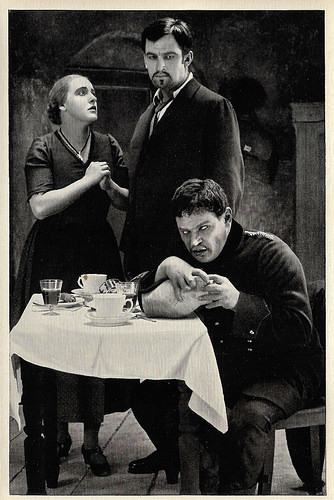
German collectors card by Ross Verlag in the series Vom Werden deutscher Filmkunst - Der Stumme Film, picture no. 102. Photo: Ufa. Publicity still for Hintertreppe/Backstairs (Leopold Jessner, Paul Leni, 1921) with Henny Porten and Wilhelm Dieterle .
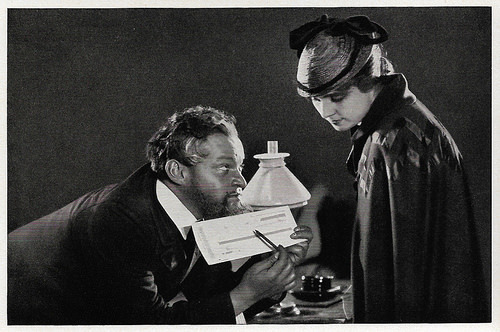
German collectors card by Ross Verlag in the series Vom Werden deutscher Filmkunst - Der Stumme Film, picture no. 99, group 43. Photo: Ufa. Publicity still for Nora (Berthold Viertel, 1923) with Olga Tschechova .
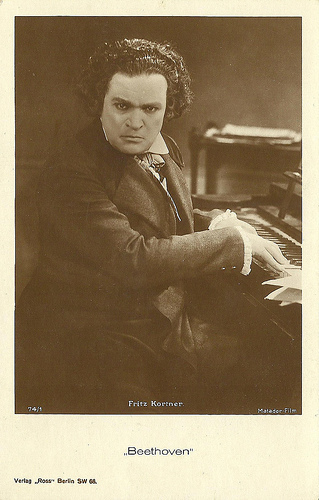
German postcard by Ross Verlag, Berlin, no. 74/1, 1925-1935. Photo: Matador-Film. Publicity still for Das Leben des Beethoven/The Life of the Beethoven (Hans Otto, 1927).
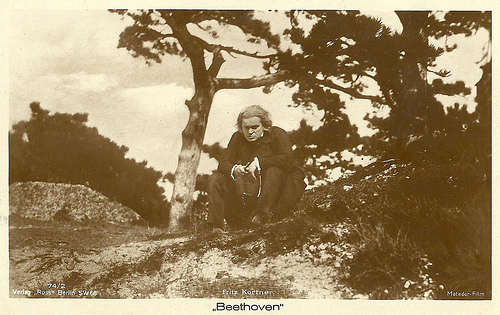
German postcard by Ross Verlag, Berlin, no. 74/2, 1925-1935. Photo: Matador-Film. Publicity still for Das Leben des Beethoven/The Life of the Beethoven (Hans Otto, 1927). Collection: Didier Hanson.

Italian postcard, no. 341. Photo: Dist. S.A. Pittaluga. Francesca Bertini and Fritz Kortner in Mein Leben für das Deine/My life for yours (Luitz-Morat, 1928), an adaptation of the play Odette by Victorien Sardou.
Unfit for the front
Fritz Kortner was born Fritz Nathan Kohn in Vienna, Austria, in 1892. He studied at the Vienna Academy of Music and Dramatic Art, an academy at the Burgtheater. After graduating, he received his first engagement at the National Theatre Mannheim. In 1911, he joined Max Reinhardt at the Deutsches Theater in Berlin. There he played only minor roles, and soon he moved again. These were wander years for the actor, hopping from stage to stage. At the outbreak of the First World War, he was called up for military service. However, he was soon written off as unfit for the front.
In 1915 he made his first film appearances in a series of adventure films directed and produced by Harry Piel , including Manya, die Türkin/Manya, the Turkish Woman (Harry Piel, 1915). During the war, he also appeared in such films as Der Märtyrer seines Herzens/The Martyr of his Heart (Emil Justitz, 1918) as Ludwig von Beethoven, Der Sonnwendhof/The Sonnwendhof (Emil Leyde, 1918) and Frauenehre/Honour of a woman (Georg Kundert, 1918), in which his expressionistic acting style first came into its own.
On stage, his roles became more important, and in 1919 he had his breakthrough with his performance in the play Die Wandlung (the Conversion) by Ernst Toller at Die Tribüne in Berlin. Then director Leopold Jessner committed him to the Staatstheater and made him one of his principal actors. Kortner appeared in many plays by Schiller, Büchner and William Shakespeare under the direction of Jessner.
His Shylock in The Merchant of Venice became his most famous role. It made him one of the great stars of the German stage in the 1920s, with a new form of theatre: Expressionism. His speciality was playing sinister and threatening roles. He also intensified his activities in the cinema, where he also excelled in expressionist works with his demonically subtle acting, such as in Satanas/Satan (F.W. Murnau, 1920) opposite Ernst Hoffmann , Die Nacht der Königin Isabeau/The Night of Queen Isabeau (Robert Wiene, 1920) starring Fern Andra , and the thriller Schatten/Warning Shadows (Arthur Robison, 1923) with Alexander Granach.
Another early classic was the drama Hintertreppe/Backstairs (Leopold Jessner, Paul Leni, 1921) in which he played a crippled mailman in love with a maid ( Henny Porten ) who lives in the same poor apartment building. In 1924 Kortner married the actress Johanna Hofer, and they stayed together till his death. That year he played the role of the villain in the Austrian silent horror classic Orlacs Hände/Orlac’s Hands (Robert Wiene, 1924) opposite Conrad Veidt . He proved his versatility with completely different parts in two other classics, as Dr. Ludwig Schön in Die Büchse der Pandora/Pandora’s Box (Georg Wilhelm Pabst, 1929) featuring Louise Brooks , and the title role in the early sound film Dreyfus/The Dreyfus Case (Richard Oswald, 1930) with Heinrich George .
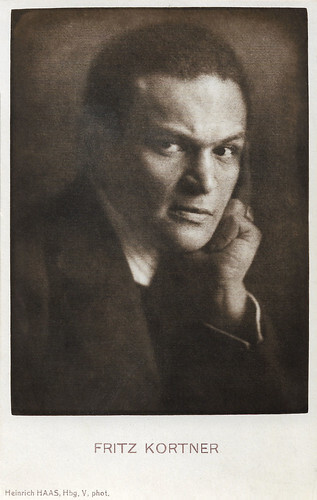
German postcard. Photo: Heinrich Haas, Hamburg.
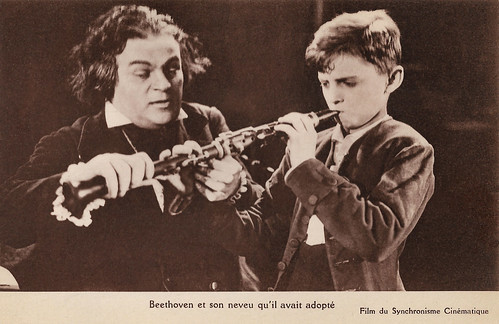
French postcard. Photo: Film du Synchronisme Cinématique. Fritz Kortner in Das Leben des Beethoven/The Life of the Beethoven (Hans Otto, 1927). Caption: Beethoven and his adopted nephew.

Danish postcard by Alex. Vincent's Kunstforlag, Eneret, no. 254. Photo: publicity still for Revolutionshochzeit/ Revolutionsbryllup/ The Last Night (A.W. Sandberg, 1928). This was a German-Danish dramatization of Sophus Michaëlis' play Revolutionshochzeit (Revolutionary Wedding), with also Karina Bell, Walter Rilla and Fritz Kortner, and produced by Terra-Filmkunst. This card shows left Ekman and Bell and in the back Fritz Kortner as the Jacobine Monteloup, and right Jacobini whose character, the aristocratic Alaine, has changed clothes with her maid Leontine (Bell) to get a pass to leave Paris.
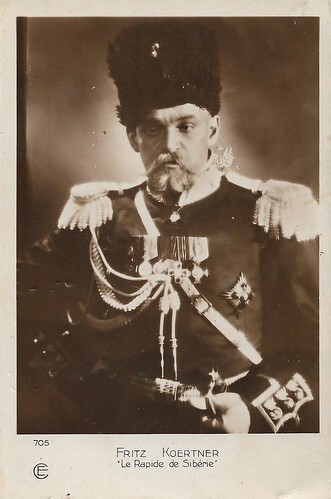
French postcard by Cinémagazine-Edition, no. 705. Photo: Erda-Film. Fritz Kortner in the late silent film Die Nacht des Schreckens (Gennaro Righelli, 1929), released in France as Le Rapide de Sibérie.
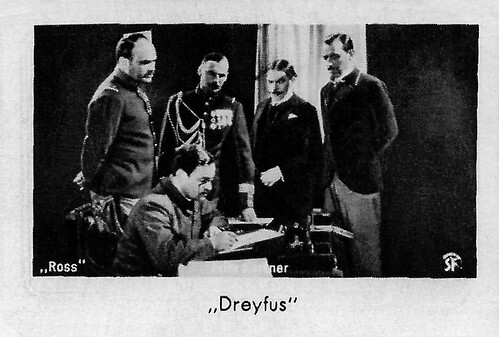
German collectors card by Ross Verlag. Photo: SF (Süd-Film). Fritz Kortner in Dreyfus/The Dreyfus Case (Richard Oswald, 1930).
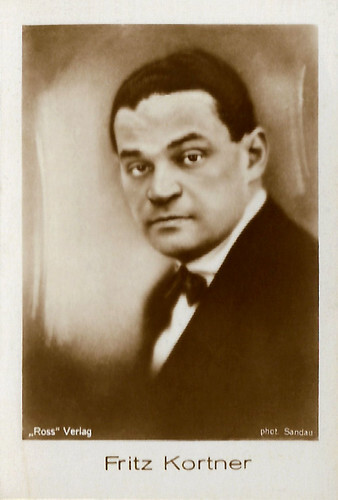
German cigarette card by Ross Verlag for A. Batschari Cigarettenfabrik, Baden-Baden, for its Mercedes cigarettes, no. 461. Photo: Sandau.
The attack
During the turbulent times in the early 1930s, the Jewish Fritz Kortner decided to install his residence in Ascona. In late 1932 he was attacked in the Nazi propaganda sheet Der Angriff (The Attack): "One had chosen for the role in 'Gott, Kaiser und Bauer' (1932, God, Emperor and Farmer) the Jew Kortner-Kohn, who actually should have stopped playing in the Berlin theatre scene long ago. He is pretty much the worst and grubbiest type who has ever been on a German stage.”
When Adolf Hitler came to power in 1933, Kortner, was on a tour through Scandinavia and Eastern Europe. He decided not to return to Germany. Over Czechoslovakia, then to Vienna - where he performed at Max Reinhardt ’s Theater in der Josefstadt – to Paris, the Kortner family then emigrated to Great Britain, where Fritz Kortner could appear in films again. Among his British films are Chu Chin Chow (Walter Forde, 1934) with Anna May Wong , and Abdul the Damned (Karl Grune, 1935) with Nils Asther .
In 1937, he emigrated to the United States, where he found work as a character actor and theatre director. In 1938 followed his family, and they moved on to Hollywood. Here he worked on scripts. Until his return to Europe in 1947 he starred in nine films such as The Hitler Gang (John Farrow, 1944). However, they were not very convincing artistically. After his return to Germany, he became noted for his innovative staging and direction. His artistic homes were the Münchener Kammerspiele under Hans Schweikart and the Schillertheater in Berlin under Boleslaw Barlog. A classic became his direction of Richard III (1964) in which the king crawls over piles of corpses at the end. At the Kammerspiele, he directed seventeen plays until 1967.
He also appeared in some interesting films, such as Der Ruf/The Last Illusion (Josef von Báky, 1949) with Johanna Hofer, and the suspenseful drama-thriller Epilog: Das Geheimnis der Orplid/Epilogue (Helmut Käutner, 1950). In the 1960s, Kortner started to direct at the Burgtheater in his native Vienna. He directed his last play, Emilia Galotti with Klaus Maria Brandauer, in April 1970, at the Viennese Theater in der Josefstadt.
Three months later, Fritz Kortner died of cancer in Munich, aged 78. Kortner’s style of interpretation and rehearsal influenced a new generation of directors. Particularly noteworthy are Peter Stein and Jürgen Flimm, who both have been assistant directors of Kortner.
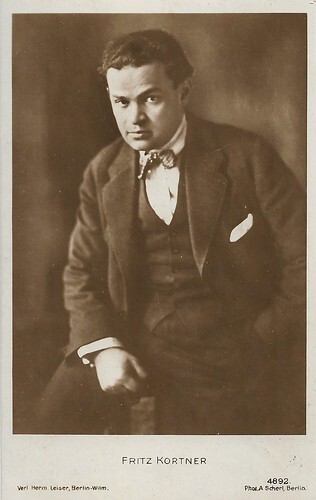
German postcard by Verlag Hermann Leiser, no. 4892. Photo: A. Scherl, Berlin.
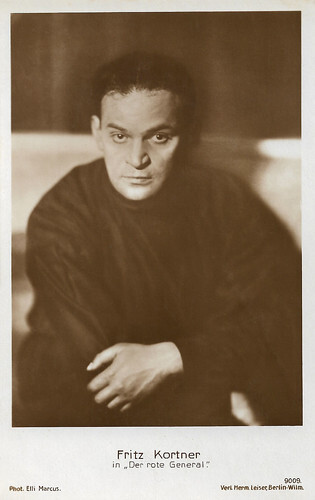
German postcard by Verlag Herm. Leiser, Berlin-Wilm., no. 9009. Photo: Eli Marcus. Fritz Kortner in the play 'Der rote General' (1928) by Hermann Ungar.
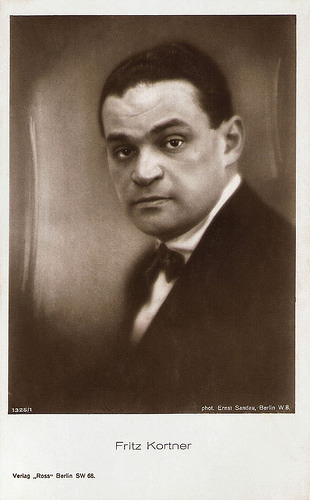
German postcard by Ross Verlag, no. 1325/1, 1927-1928. Photo: Ernst Sandau, Berlin.
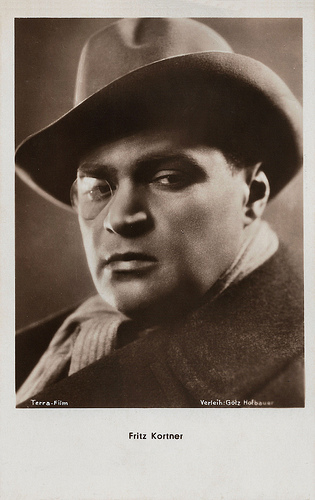
Austrian postcard by Iris Verlag, no. 6037. Photo: Terra Film / Götz Hofbauer.
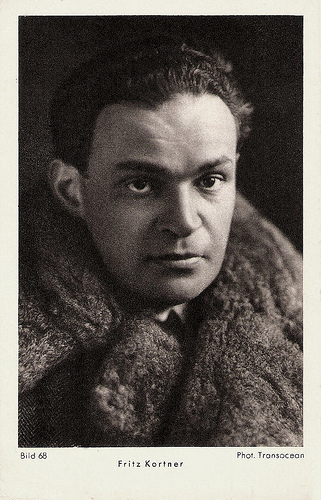
German postcard by Margarinewerk Eidelstedt Gebr. Fauser G.m.b.H., Holstein, Serie 1, no. Bild 68. Photo: Transocean.
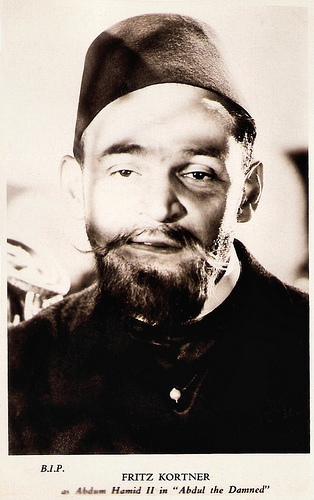
British card. Photo: B.I.P. Publicity still for Abdul the Damned (1935).
Sources: Wikipedia (English and German) and .

German collectors card by Ross Verlag in the series Vom Werden deutscher Filmkunst - Der Stumme Film, picture no. 102. Photo: Ufa. Publicity still for Hintertreppe/Backstairs (Leopold Jessner, Paul Leni, 1921) with Henny Porten and Wilhelm Dieterle .

German collectors card by Ross Verlag in the series Vom Werden deutscher Filmkunst - Der Stumme Film, picture no. 99, group 43. Photo: Ufa. Publicity still for Nora (Berthold Viertel, 1923) with Olga Tschechova .

German postcard by Ross Verlag, Berlin, no. 74/1, 1925-1935. Photo: Matador-Film. Publicity still for Das Leben des Beethoven/The Life of the Beethoven (Hans Otto, 1927).

German postcard by Ross Verlag, Berlin, no. 74/2, 1925-1935. Photo: Matador-Film. Publicity still for Das Leben des Beethoven/The Life of the Beethoven (Hans Otto, 1927). Collection: Didier Hanson.

Italian postcard, no. 341. Photo: Dist. S.A. Pittaluga. Francesca Bertini and Fritz Kortner in Mein Leben für das Deine/My life for yours (Luitz-Morat, 1928), an adaptation of the play Odette by Victorien Sardou.
Unfit for the front
Fritz Kortner was born Fritz Nathan Kohn in Vienna, Austria, in 1892. He studied at the Vienna Academy of Music and Dramatic Art, an academy at the Burgtheater. After graduating, he received his first engagement at the National Theatre Mannheim. In 1911, he joined Max Reinhardt at the Deutsches Theater in Berlin. There he played only minor roles, and soon he moved again. These were wander years for the actor, hopping from stage to stage. At the outbreak of the First World War, he was called up for military service. However, he was soon written off as unfit for the front.
In 1915 he made his first film appearances in a series of adventure films directed and produced by Harry Piel , including Manya, die Türkin/Manya, the Turkish Woman (Harry Piel, 1915). During the war, he also appeared in such films as Der Märtyrer seines Herzens/The Martyr of his Heart (Emil Justitz, 1918) as Ludwig von Beethoven, Der Sonnwendhof/The Sonnwendhof (Emil Leyde, 1918) and Frauenehre/Honour of a woman (Georg Kundert, 1918), in which his expressionistic acting style first came into its own.
On stage, his roles became more important, and in 1919 he had his breakthrough with his performance in the play Die Wandlung (the Conversion) by Ernst Toller at Die Tribüne in Berlin. Then director Leopold Jessner committed him to the Staatstheater and made him one of his principal actors. Kortner appeared in many plays by Schiller, Büchner and William Shakespeare under the direction of Jessner.
His Shylock in The Merchant of Venice became his most famous role. It made him one of the great stars of the German stage in the 1920s, with a new form of theatre: Expressionism. His speciality was playing sinister and threatening roles. He also intensified his activities in the cinema, where he also excelled in expressionist works with his demonically subtle acting, such as in Satanas/Satan (F.W. Murnau, 1920) opposite Ernst Hoffmann , Die Nacht der Königin Isabeau/The Night of Queen Isabeau (Robert Wiene, 1920) starring Fern Andra , and the thriller Schatten/Warning Shadows (Arthur Robison, 1923) with Alexander Granach.
Another early classic was the drama Hintertreppe/Backstairs (Leopold Jessner, Paul Leni, 1921) in which he played a crippled mailman in love with a maid ( Henny Porten ) who lives in the same poor apartment building. In 1924 Kortner married the actress Johanna Hofer, and they stayed together till his death. That year he played the role of the villain in the Austrian silent horror classic Orlacs Hände/Orlac’s Hands (Robert Wiene, 1924) opposite Conrad Veidt . He proved his versatility with completely different parts in two other classics, as Dr. Ludwig Schön in Die Büchse der Pandora/Pandora’s Box (Georg Wilhelm Pabst, 1929) featuring Louise Brooks , and the title role in the early sound film Dreyfus/The Dreyfus Case (Richard Oswald, 1930) with Heinrich George .

German postcard. Photo: Heinrich Haas, Hamburg.

French postcard. Photo: Film du Synchronisme Cinématique. Fritz Kortner in Das Leben des Beethoven/The Life of the Beethoven (Hans Otto, 1927). Caption: Beethoven and his adopted nephew.

Danish postcard by Alex. Vincent's Kunstforlag, Eneret, no. 254. Photo: publicity still for Revolutionshochzeit/ Revolutionsbryllup/ The Last Night (A.W. Sandberg, 1928). This was a German-Danish dramatization of Sophus Michaëlis' play Revolutionshochzeit (Revolutionary Wedding), with also Karina Bell, Walter Rilla and Fritz Kortner, and produced by Terra-Filmkunst. This card shows left Ekman and Bell and in the back Fritz Kortner as the Jacobine Monteloup, and right Jacobini whose character, the aristocratic Alaine, has changed clothes with her maid Leontine (Bell) to get a pass to leave Paris.

French postcard by Cinémagazine-Edition, no. 705. Photo: Erda-Film. Fritz Kortner in the late silent film Die Nacht des Schreckens (Gennaro Righelli, 1929), released in France as Le Rapide de Sibérie.

German collectors card by Ross Verlag. Photo: SF (Süd-Film). Fritz Kortner in Dreyfus/The Dreyfus Case (Richard Oswald, 1930).

German cigarette card by Ross Verlag for A. Batschari Cigarettenfabrik, Baden-Baden, for its Mercedes cigarettes, no. 461. Photo: Sandau.
The attack
During the turbulent times in the early 1930s, the Jewish Fritz Kortner decided to install his residence in Ascona. In late 1932 he was attacked in the Nazi propaganda sheet Der Angriff (The Attack): "One had chosen for the role in 'Gott, Kaiser und Bauer' (1932, God, Emperor and Farmer) the Jew Kortner-Kohn, who actually should have stopped playing in the Berlin theatre scene long ago. He is pretty much the worst and grubbiest type who has ever been on a German stage.”
When Adolf Hitler came to power in 1933, Kortner, was on a tour through Scandinavia and Eastern Europe. He decided not to return to Germany. Over Czechoslovakia, then to Vienna - where he performed at Max Reinhardt ’s Theater in der Josefstadt – to Paris, the Kortner family then emigrated to Great Britain, where Fritz Kortner could appear in films again. Among his British films are Chu Chin Chow (Walter Forde, 1934) with Anna May Wong , and Abdul the Damned (Karl Grune, 1935) with Nils Asther .
In 1937, he emigrated to the United States, where he found work as a character actor and theatre director. In 1938 followed his family, and they moved on to Hollywood. Here he worked on scripts. Until his return to Europe in 1947 he starred in nine films such as The Hitler Gang (John Farrow, 1944). However, they were not very convincing artistically. After his return to Germany, he became noted for his innovative staging and direction. His artistic homes were the Münchener Kammerspiele under Hans Schweikart and the Schillertheater in Berlin under Boleslaw Barlog. A classic became his direction of Richard III (1964) in which the king crawls over piles of corpses at the end. At the Kammerspiele, he directed seventeen plays until 1967.
He also appeared in some interesting films, such as Der Ruf/The Last Illusion (Josef von Báky, 1949) with Johanna Hofer, and the suspenseful drama-thriller Epilog: Das Geheimnis der Orplid/Epilogue (Helmut Käutner, 1950). In the 1960s, Kortner started to direct at the Burgtheater in his native Vienna. He directed his last play, Emilia Galotti with Klaus Maria Brandauer, in April 1970, at the Viennese Theater in der Josefstadt.
Three months later, Fritz Kortner died of cancer in Munich, aged 78. Kortner’s style of interpretation and rehearsal influenced a new generation of directors. Particularly noteworthy are Peter Stein and Jürgen Flimm, who both have been assistant directors of Kortner.

German postcard by Verlag Hermann Leiser, no. 4892. Photo: A. Scherl, Berlin.

German postcard by Verlag Herm. Leiser, Berlin-Wilm., no. 9009. Photo: Eli Marcus. Fritz Kortner in the play 'Der rote General' (1928) by Hermann Ungar.

German postcard by Ross Verlag, no. 1325/1, 1927-1928. Photo: Ernst Sandau, Berlin.

Austrian postcard by Iris Verlag, no. 6037. Photo: Terra Film / Götz Hofbauer.

German postcard by Margarinewerk Eidelstedt Gebr. Fauser G.m.b.H., Holstein, Serie 1, no. Bild 68. Photo: Transocean.

British card. Photo: B.I.P. Publicity still for Abdul the Damned (1935).
Sources: Wikipedia (English and German) and .
Published on September 27, 2023 22:00
Paul van Yperen's Blog
- Paul van Yperen's profile
- 13 followers
Paul van Yperen isn't a Goodreads Author
(yet),
but they
do have a blog,
so here are some recent posts imported from
their feed.



